(Translated from Slovenian to English with ChatGPT)
- Introduction
- Moving around
- Residence
- Eating
- Bangalore attractions
- Wayanad and a real safari trip
- Andaman Islands
- To conclude …
Introduction
“It’s been a month and a half since arriving in India, and it’s time to go home. I’m sitting at the airport, writing. There are still a couple of hours until the flight to Dubai, and I can’t browse the internet because the airport’s free Wi-Fi doesn’t send an SMS message with a PIN code to my Slovenian phone number for an hour of free browsing. I don’t dare turn on my data on the Slovenian Telekom mobile number while roaming here. The prices in the stores around me are inflated as if we’re no longer in India, so I have no interest in shopping or even sightseeing. Actually, we’re not really in India any-more because diligent officials checked if we were the ones who entered the country a month and a half ago even before inspecting our luggage. Moreover, everything is so clean, shiny, and organized that it could be anywhere in that gleaming Western world that values glamour and knows better how to hide misery than here. However, it is true that there might be a bit more misery here, and they don’t make much effort to hide it. At least that’s the impression one gets on the streets of the metropolis, where glamour and misery intertwine closely. I must emphasize that my perception is strongly influenced by the cultural environment in which I grew up and live. But my perception of what I see does not necessarily mean evaluation. Just because something is different doesn’t make it worse or better. Above all, it is necessary to accept the fact that those being observed do not perceive their situation the same way we, who live elsewhere and differently, do.
Moving around
The interweaving of misery and glamour, as we perceive it in the central part of Europe, is noticeable at every step in India. Premium cars mix with buses, some of which could be a museum exhibit that has been carrying passengers around the city for decades. Then there are the yellow-green autorickshaws, all kinds of two-wheelers, and occasionally even cyclists. Not to mention the pedestrians who try to cross the road alive, dodging cows rummaging through garbage and strolling through rushing vehicles.
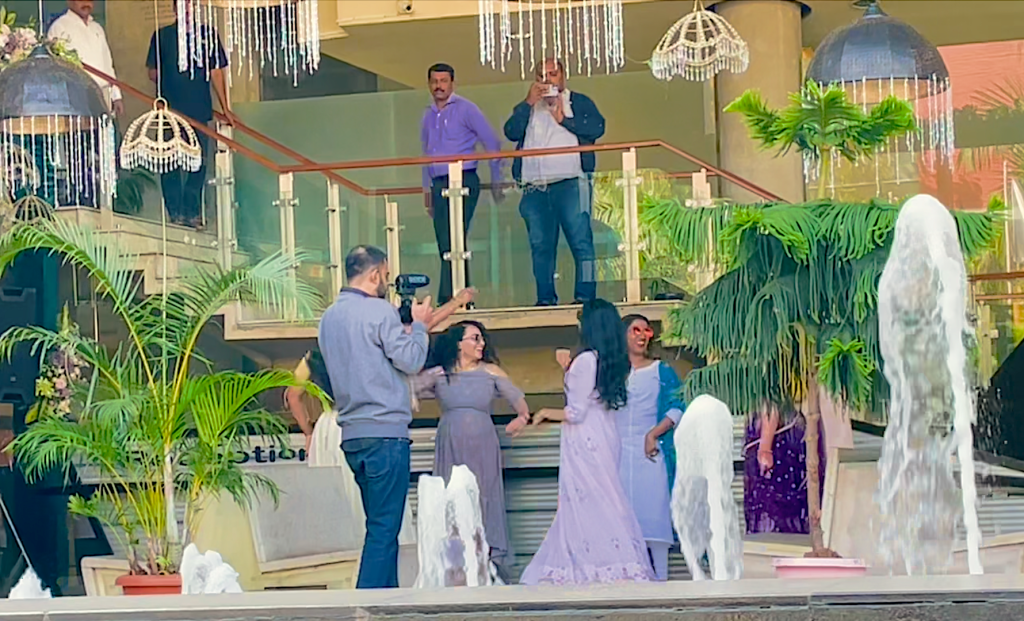
Along the roads, makeshift shops made of discarded boards and corrugated metal alternate with those that people would not be ashamed of anywhere where they value glamour and neon lighting. Magnificent palaces of various institutions share the street space with buildings that appear like uninhabited for decades, maybe just occupied by squatters who are not concerned with art but with commercial activities. Immaculate side walks in front of the palaces end at the first neighbour, either dug up due to some construction work or filled with construction debris, usually adorned with plenty of garbage. Wherever you walk, expect obstacles. Crossing the road, for us accustomed to the green man on the traffic light, is an impossible task because pedestrians are an unnecessary nuisance here that needs to be removed from the road as soon as possible. If not, then to the hospital or the grave, if I may exaggerate. That’s the feeling you get when you make your way through moving vehicles to the other side of the road. Apparently, to undertake such a venture as crossing the main artery of the metropolis alive, one must be born here in the midst of this daily hustle and bustle, as it is probably impossible to learn it, especially since in India they don’t drive on the right side like us but on the left.
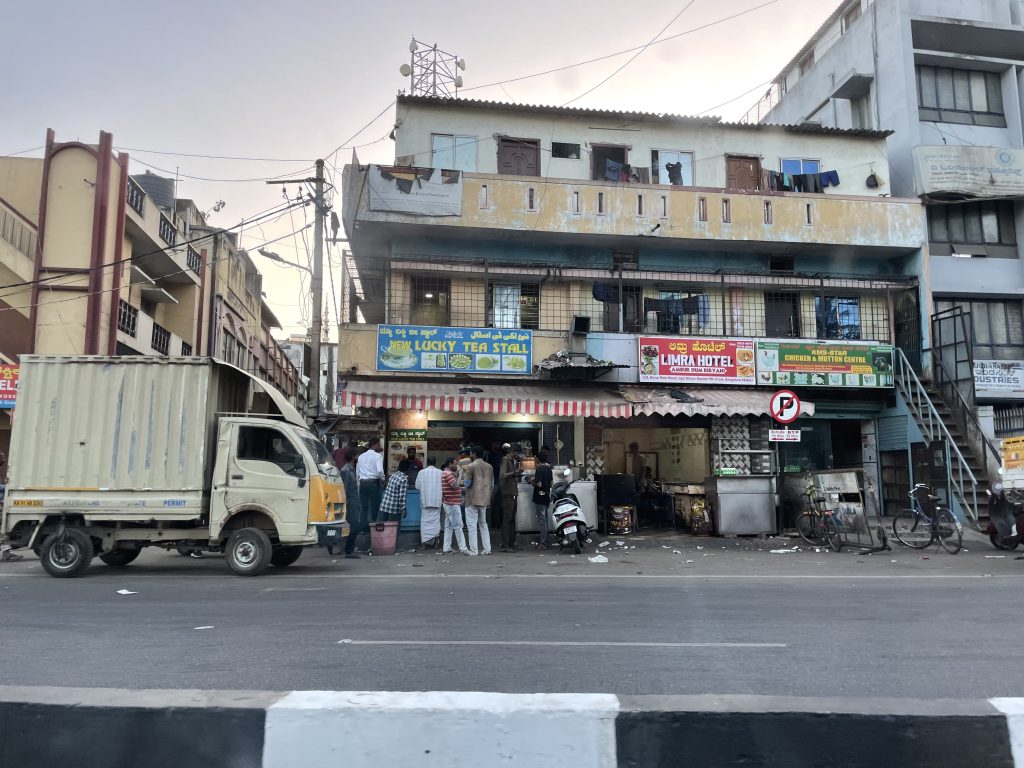
Even if they’d drove on the right side of the road, crossing it would still be a high-risk endeavour. Regarding driving on the left side, it must be admitted that it is not entirely true that they drive on the left, or, for our standards, on the wrong side. Even in the city, where lanes for different directions are physically separated, vehicles often drive (over shorter distances) towards those going in the prescribed direction. So I saw two-wheelers as well as autorickshaws driving in opposite direction. Both are narrow enough to squeeze through wherever there is enough space to pass, and the direction of travel is quite irrelevant. When they drive in the opposite direction, they keep to the right and therefore drive on the side that we do. On roads with less traffic Indian divers don’t drive on the left either but in the middle. They overtake where there is space, either on the left or on the right, just to get past. They only move to the left if someone comes towards them. In India, they don’t really drive on the left; they just avoid those going in the opposite direction by going to the left.
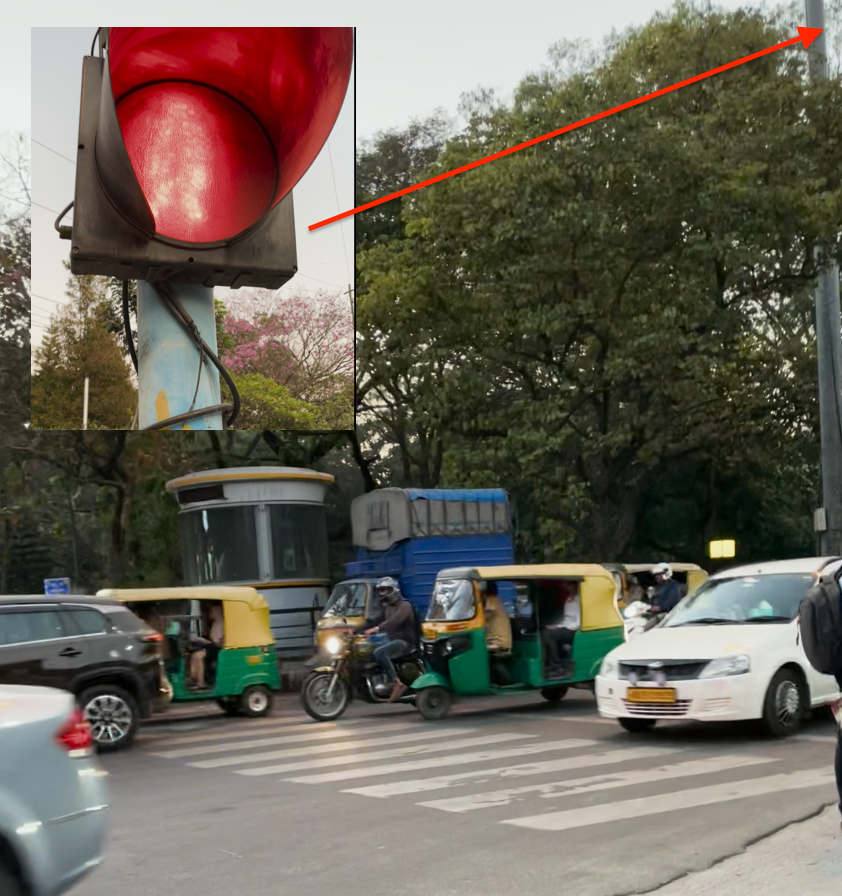
The traffic congestion in a city with over 11 million inhabitants, where they are constructing a metro line above the main city arteries, is accordingly huge, especially since the capacity is significantly reduced due to miles and miles of construction sites. It takes an hour and a half to drive from the apartment where we stayed to the airport, sometimes even more than two hours, depending on traffic. Since it was Friday on the day of our departure, and it was expected to be quite crowded, and because airlines dictate that you must be at the airport at least three hours before the scheduled departure, our taxi driver calculated that we had to leave our temporary home in India before three o’clock. Since he is experienced and knows it well, we followed his advice. We said goodbye to our grandson, daughter, son-in-law, his sister, and mother, got into the taxi, and left. However, the expected Friday congestion was not there. It was just the usual kind. After an hour and a half, we were already at the airport, where, for local standards, there wasn’t any real crowd either. Three hours before the flight, we had completed all the necessary checks, dropped off our luggage, and had boarding passes in our hands.
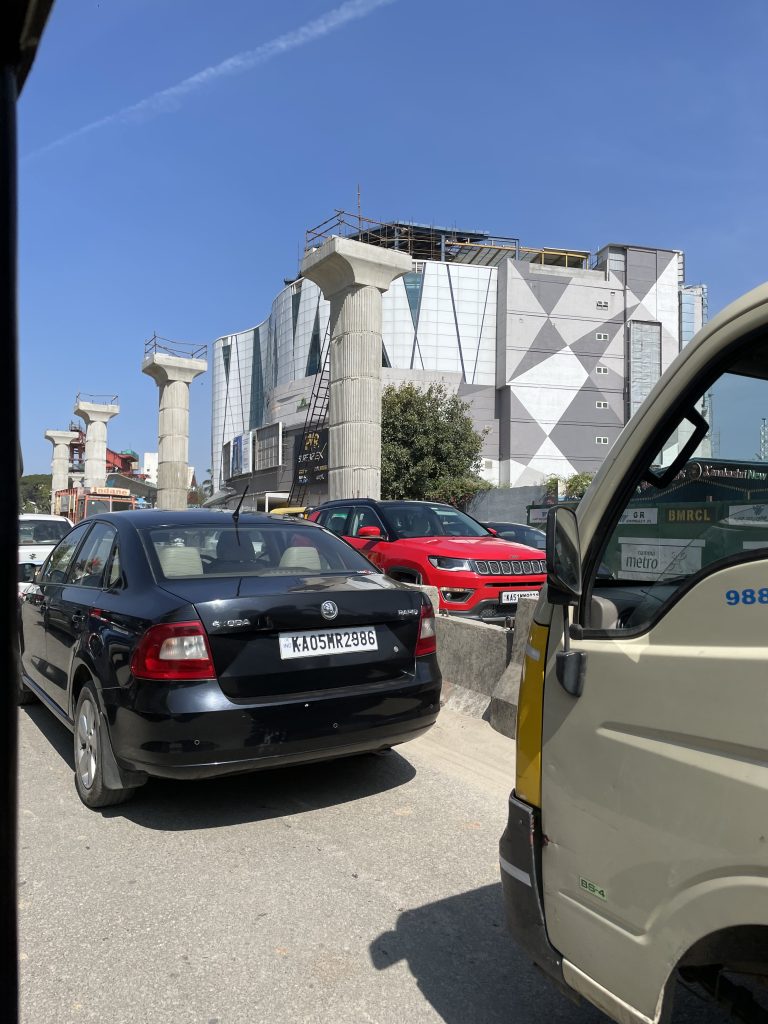
So I had plenty of time to write about the impressions from this trip, but not enough battery on my laptop. If I hadn’t been able to find an outlet, this story would be considerably shorter. However, finding an outlet in India is not enough. After you find one, you have to be skillful enough to plug in the charger so that the electricity flows through the wires. After several unsuccessful attempts to plug in the plug of my Apple charger into the outlet, I finally succeeded. As the experiences show, you must not push the plug into the socket all the way. This is another peculiarity of these places that can be annoying. Sometimes you go from one outlet to another, trying to insert the plug in various ways, and nothing happens. This reminded me of the Kama Sutra and the instructions for “bedtime delights” described in it. As far as I remember, it was mentioned that the best matches are made between those who are in the same size category (not referring to shoe or clothing sizes but… well, you probably guessed what, even if you haven’t read the mentioned manual). Indian sockets are slightly too big for “apple” plugs, or maybe too shallow, who knows. The fact is, they don’t fit well with the plug I use for charging both my laptop and phone. Another peculiarity of Indian sockets is that there is a switch next to each one that you have to turn on to connect the socket to the electrical grid. You get used to both after facing an empty battery several times, despite pluging in the device in the evening and charging it all night. And speaking of electricity, occasional brief power outages are quite common. At the Port Blair airport, after our arrival, the lights suddenly went off in the waiting area and came back on after about half a minute. On the screens above the check-in counters, you could then see the Windows operating system rebooting, which is clear evidence that you can’t even fly without Bill Gates and his windows any-more.
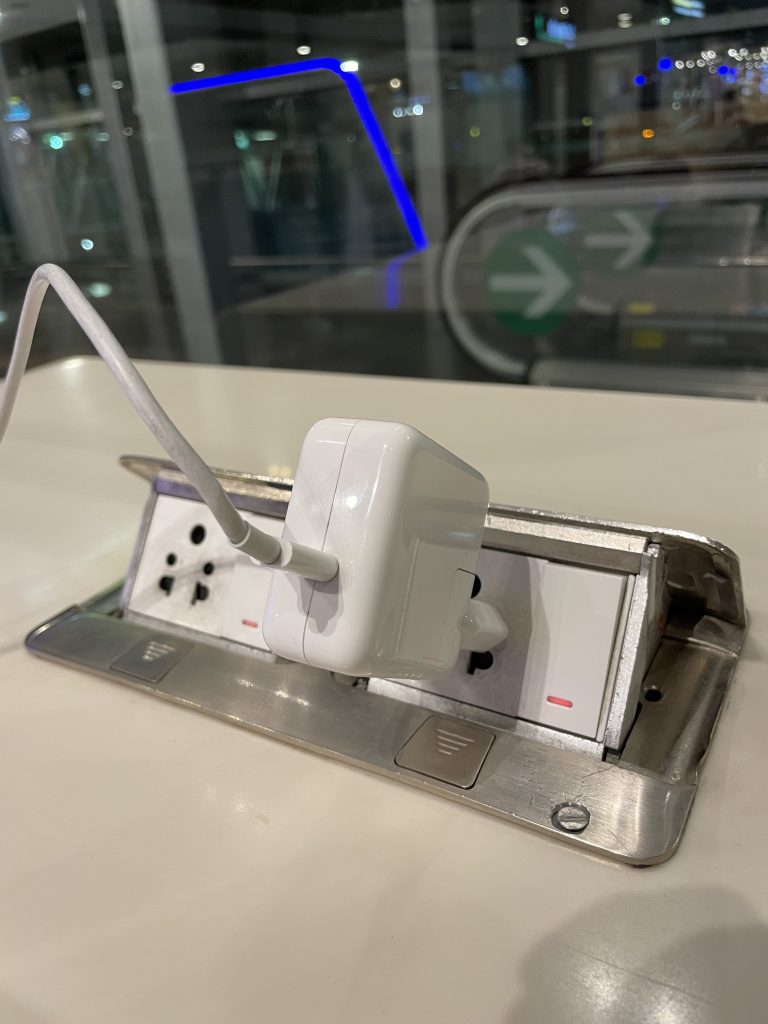
With flying I am returning back to transportation. Besides domestic flights, we also tried other forms of transportation in southern India. Walking doesn’t get you far, as I mentioned before, so it’s necessary to consider something on wheels. Cycling is out of the question because deep breathing in this city filled with traffic exhaust fumes is not recommended, although there are rare individuals who do just that. If we exclude walking and cycling, we are left with motorcycles, autorickshaws, cars or taxis, buses, and the metro.
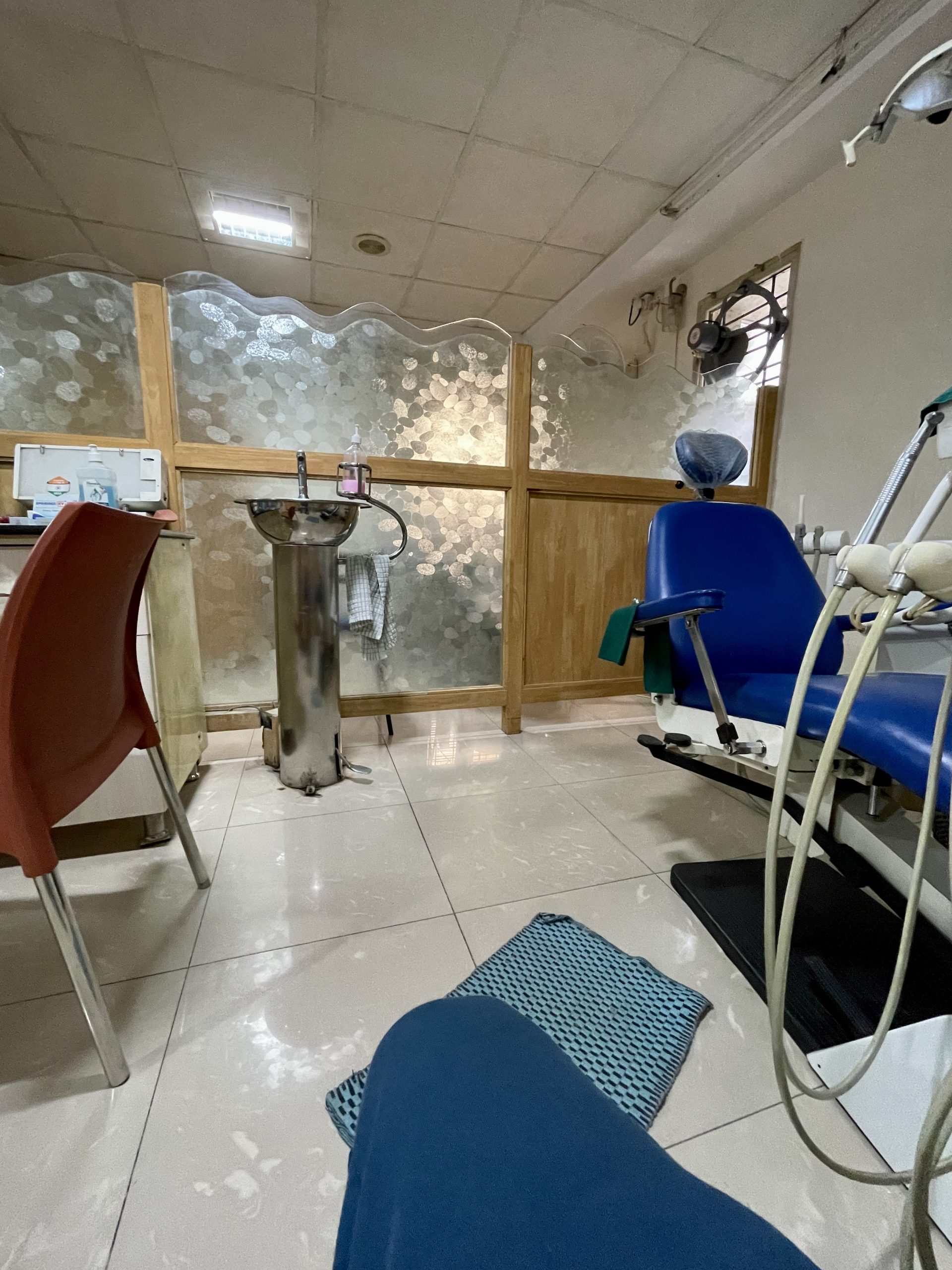
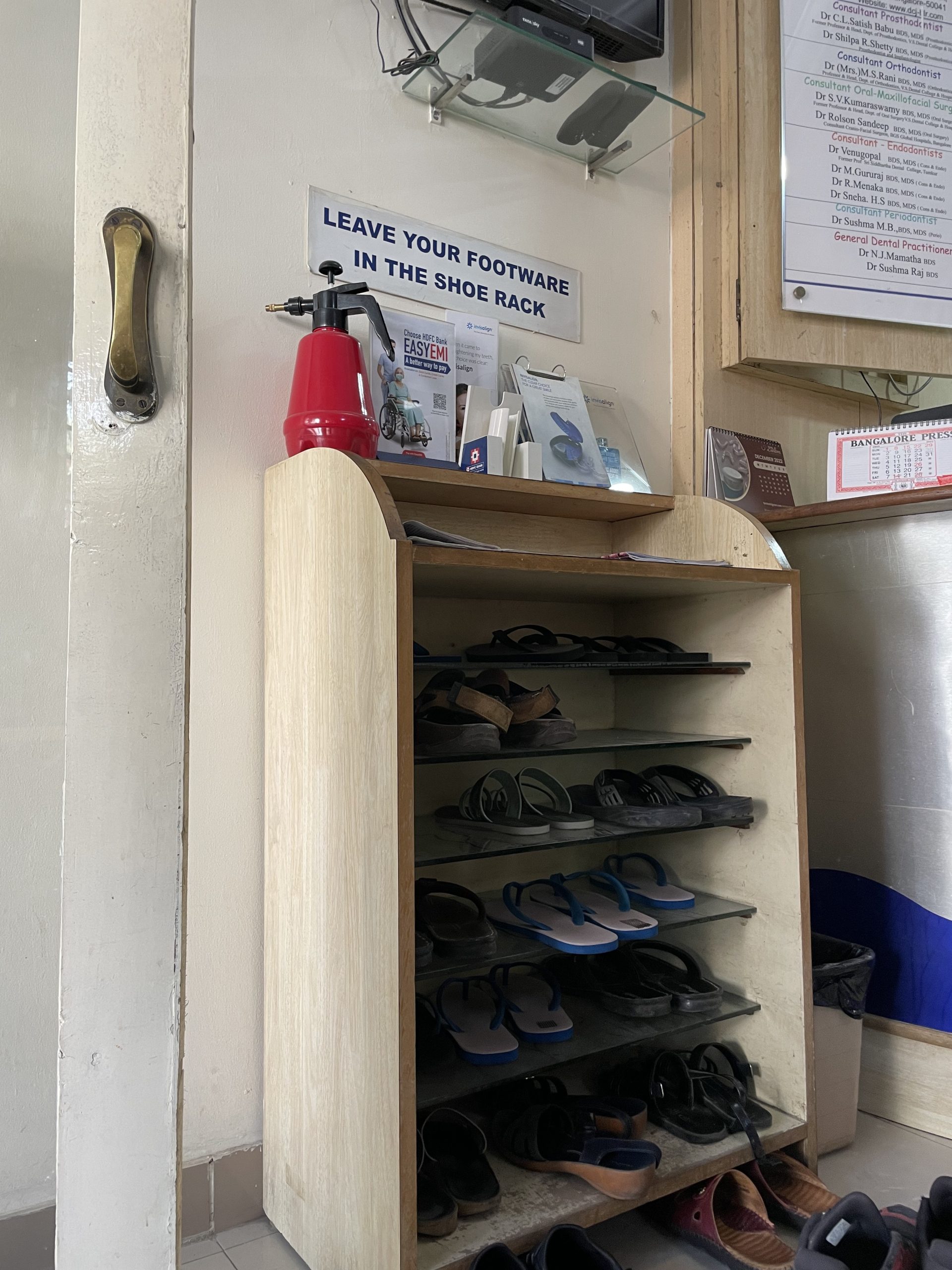
I’m not particularly fond of motorcycles because my uncle had a fatal accident on one, so motorcycles were on the list of forbidden or at least undesirable things in my family. In my younger years, I transitioned directly from a bicycle to a car, and later I was never tempted to ride a motorcycle, especially not as a passenger. But I also encountered it in India. During my first visit three years ago, I enthusiastically photographed motorcycles loaded with whole families or with as much cargo as you can barely fit on a small car trailer in our country. This time, however, I had to climb onto a motorcycle myself as my son-in-law drove me to the dentist. The quarter-hour of bouncing through the bustling streets and weaving through evening traffic was not easily forgotten. On the way there, with every passing minute, I became more convinced that under no circumstances would I return on a motorcycle. However, because we waited half an hour at the dentist, only to be told that there wasn’t enough time for any treatment, I couldn’t bring myself to ask my son-in-law to go back on the motorcycle while I would take an autorickshaw. It’s not economically sound, and since we are thrifty people from the eastern part of Gorenjska, I firmly held onto the seat during the return journey, trying to cushion the impact against it on road obstacles and potholes as much as possible. The journey home has never seemed so long to me, even though we weren’t any slower than taxis or autorickshaws, if anything, we were faster. However, it should be noted that what we in our country call “lying down policemen” (direct translation from Slovenian for Speed Bumps) does not deserve that name on Indian roads. They still have standing police officers on the roads, while what we call “lying down policemen” are actual road obstacles that everyone carefully ascends because otherwise they might get stuck on them. You can imagine what follows – in addition to the honking of traffic participants, of course.
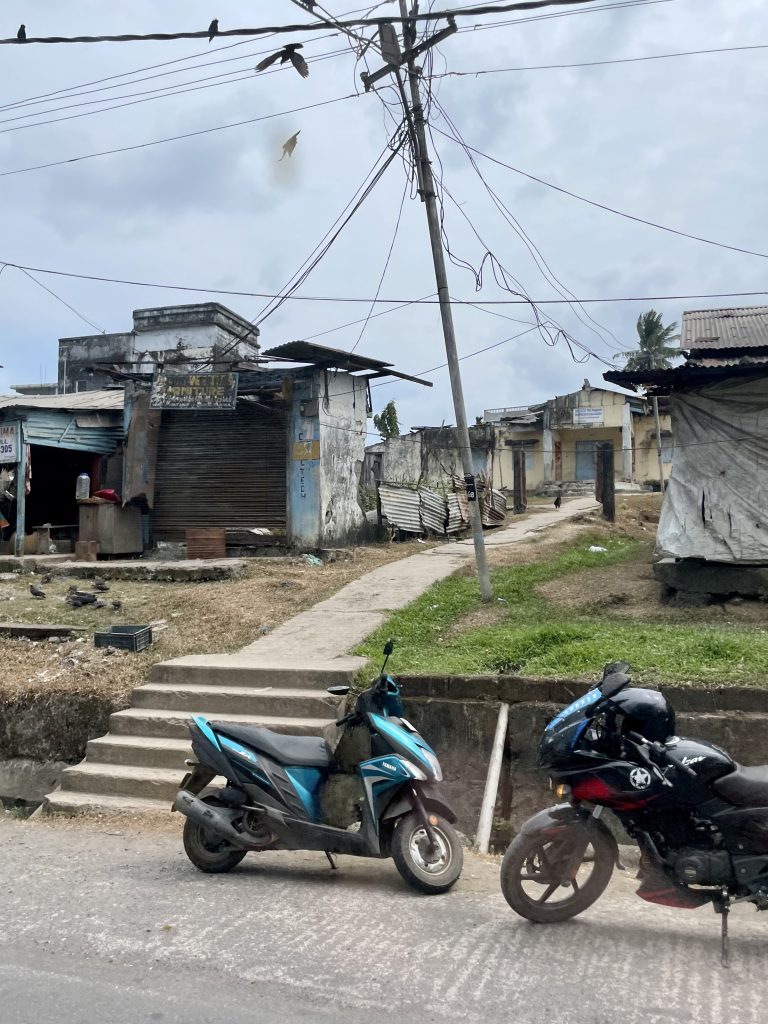
Honking is, as one might say, a mandatory routine here. With it, you communicate where you are to those who can’t see you so they can make room if necessary. For example, if you’re overtaking in a blind curve, which is a common practice, you honk a few times so that oncoming traffic on the other side of the curve knows that they may need to move a little to the left, the same applies to the person you’re overtaking. You squeeze through in extreme situations. I think we call it “overtaking in scissors” in our country, but I didn’t see such scissors actually cutting in India. Somehow, it usually works out for them. Honking contributes to this, as well as the fact that the mentality of punishing others’ mistakes in the sense of “I’ll show you overtaking in scissors, I have the right to drive here – bam!” does not prevail among them. I got the feeling that Indians don’t claim what is legally theirs, i.e., the left lane, but they collectively share the entire road surface and, if possible, a little more. It’s quite pointless to draw lines on multi-lane roads because it’s a waste of paint. When traffic gets congested, there are as many lanes as vehicles can fit side by side, depending on how wide they are. The distances between them are so minimal that it’s hard to understand how they manage to change course without touching each other. It’s also incredible how they merge into traffic and make right turns. There’s no waiting for a safe gap to cut across. Safety is disregarded, as well as right-of-way. The only important thing is to avoid collisions. So, when you approach the main road from a side street, where the traffic moves relatively fast, you don’t wait, but you carefully squeeze into the queue where there is at least a little space between vehicles. Those you’re squeezing in between somehow readjust, slow down a bit, and the traffic continues to flow normally. Making a right turn is a bit more delicate because those whose path is intersected by the turning flow must slow down and, if the traffic is dense enough, even stop to allow the right-turning vehicles to squeeze through. The same applies to U-turns, where you have to go from the left side of a multi-lane road to the right side where there is a low wall between the two sides, and your destination is on the other side and back. You position yourself at the gap in the wall and squeeze in between the oncoming traffic, then move to the far left where your destination is. If you’re on a motorcycle or in an autorickshaw and the traffic is less dense than usual, you don’t bother with that and instead, at the previous gap in the wall between the lanes going in different directions, you turn diagonally to the right and then slowly drive on the far right side against the opposite direction of traffic.

If you’re unfamiliar with such driving style, then you’re dependent on others to transport you, and most often for us, it was the autorickshaw drivers. Usually, we would get the transportation using the Uber app, and most often it was my son-in-law Bharath who has arranged that for us. On the last day when Julija and I went shopping, we have gotten the proof that this mode of transportation is much more cost-effective than trying to negotiate a cheap ride with drivers waiting for passengers on the street. One driver wanted to charge us 80 rupees for a five-minute ride. Julija claimet that it was too much for such a short distance and offered to pay 50, but he was only prepared to lower it to 70. At that point, I intervened and firmly said that it is either 50 or nothing. And it was nothing. Julja got out, and he drove off. A few minutes later, we got a ride through Uber for 35 rupees, which is approximately 40 EURO cents. But principles are principles, and we Gorenjci1 (people from the Gorenjska region) are Gorenjci (thrifty), even in India. Bargaining is certainly not an innate skill in our family; we learned it out of necessity. But even the more skilled ones don’t always succeed. In some places, autorickshaw drivers have some sort of cartel agreement. You can easily arrive in front of the palace in Bangalore using Uber, but from there, it’s not possible because, for unknown reasons, you can’t find a ride. Those waiting in line to take you away from the palace don’t lower their prices, and no matter how much you go from one to another, the price remains the same, and none of them will give even a five-rupee discount. However, that’s when we opted for a “new autorickshaw.” It’s essentially a small car with windows, doors, a steering wheel, and a sequential gearbox. Classic autorickshaws are mopeds with a seat for two or three passengers at the back. We often traveled as a group of four, including a two-year-old child. Since the autorickshaw has no windows, it’s always breezy during the ride, and you’re directly exposed to all the exhaust fumes from the road. But whatever goes in comes out just as quickly, which cannot be said for cars with windows and doors. Such rides are neither healthy nor safe, that’s for sure.
1 A stereotype about people from these region is that they are even stingier than Scots.
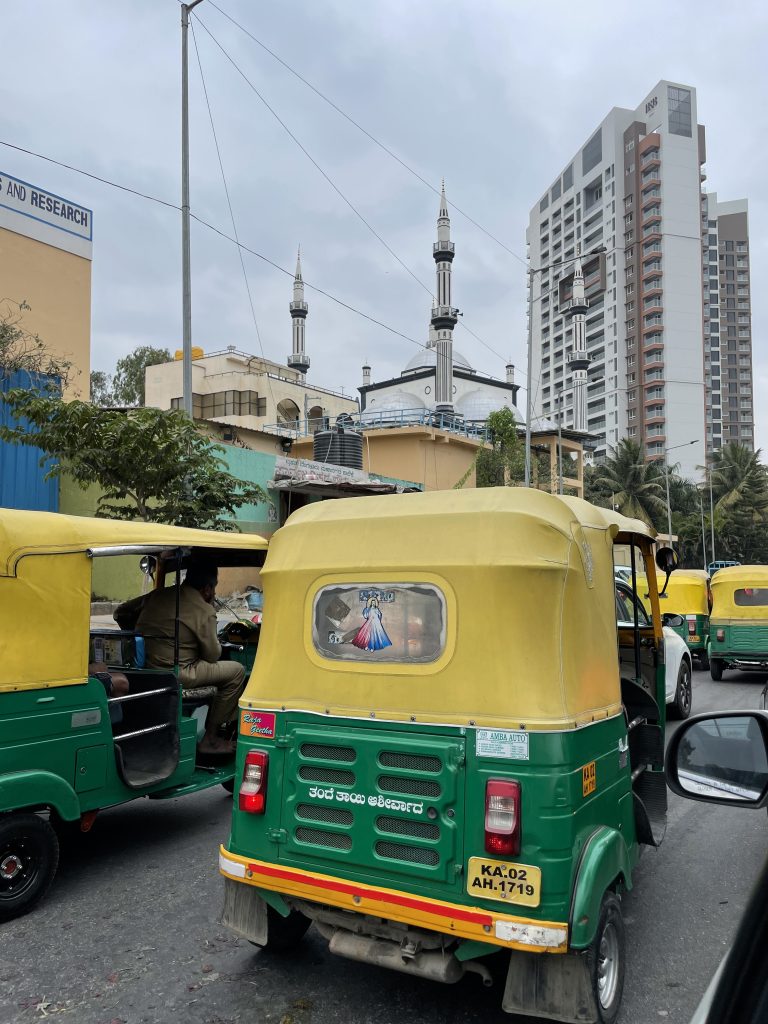
For longer journeys and more comfort, you have to opt for a taxi. Since there’s significantly less noise in a taxi compared to an autorickshaw, it’s even possible to have a conversation with the driver. Of course, the condition is that they have enough English proficiency to understand what you’re asking or telling them. English language proficiency among the local population is far from widespread. One of the taxi drivers boasted to us that he speaks six languages, five of them Indian, and the sixth being English. He learned them from his peers because Bangalore is a city of immigrants from all over India. The local language is Kannada, and they also speak Tamil, Hindi, and who knows what else, but English is the least obvious. I didn’t engage in conversation with taxi drivers because experience taught me that they wouldn’t understand me anyway. But Julija can’t do without establishing some form of connection, even though some taxi drivers themselves initiated the conversation by asking, “Where are you from?” Julija was interested in their age, the number of children they have, how much time they spend at work, how they obtain a taxi driving license, and similar things. Her compassion and communicativeness led us to a very amusing situation when we were on vacation with Maša and Sky on the Andaman Islands. When we returned to Port Blair on a boat from Havelock Island, we arrived about ten minutes late. The taxi driver who had to wait for us seemed a bit pitiful to July, and as soon as we got into the taxi, she started apologizing with the sentence, “We came later!” The driver replied, “Just a small stop!” and drove us without us understanding why he needed a short stop. Five minutes later, he stopped on the street where there were small shops and asked us for twenty rupees. We thought he needed it for something necessary to take us to the hotel. We exchanged glances, and although we didn’t understand why he needed the money, we started rummaging through our wallets to find change. Because we were apparently too slow, he got tired of waiting and hurried off to a store. In no time, he returned with a lighter, offering it to July. However, she didn’t need or take the lighter. We found out why the driver thought she needed it from a conversation with him shortly afterward. When Julija said, “later,” our driver, who is a smoker, heard “lighter.” Smokers know all too well how difficult it is when you don’t have anything to light your tobacco roll with. That’s why he made such an effort to provide his passenger with this magical device called a “lighter” or “later” or something similar. Julija didn’t need the lighter, nor did she accept it, but that’s how we found out why he needed “just a small stop” on the way to the hotel.
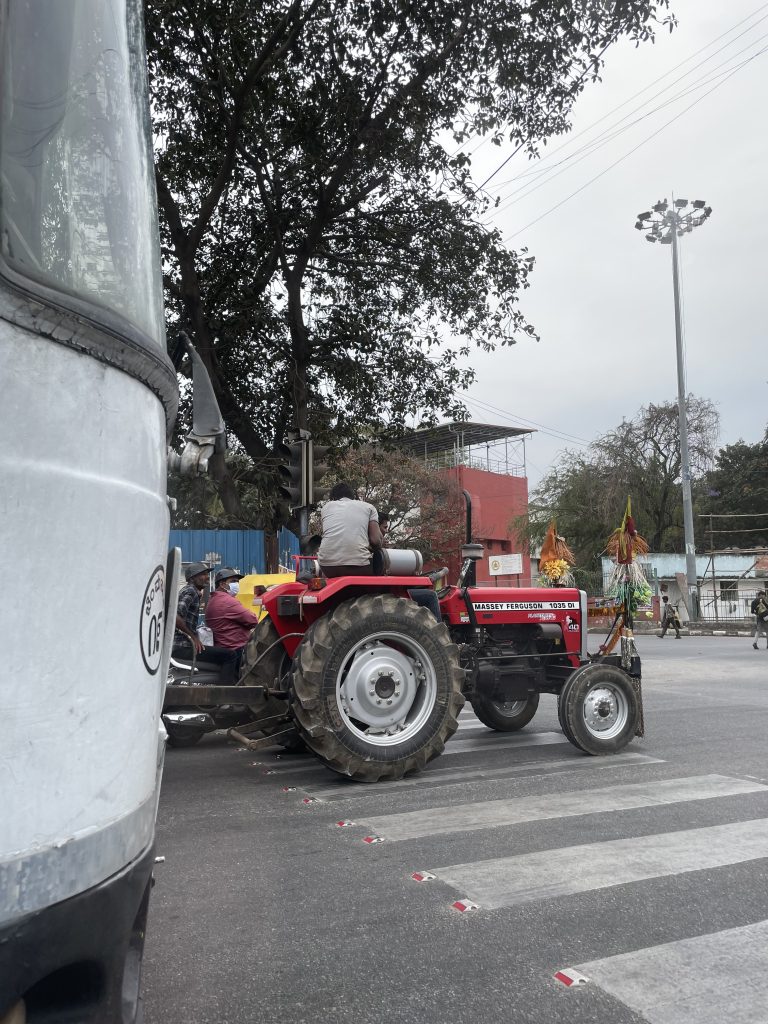
The remaining two forms of transportation involve sharing the means of transport with random strangers. We only took a few stops on the bus. It was reasonably crowded, and the conductor was pushing through from one end to the other, selling tickets, just like on our buses during my high school days. The problem with buses is that you have to know where they are going and at which stop you need to get off. The transportation staff isn’t of much help in this regard, as it can happen that they don’t understand you when you try to explain where you want to go. That’s why we ended our only bus ride halfway to the destination and switched to an autorickshaw. There’s no need to explain the destination there because you already enter it into Google Maps when ordering.
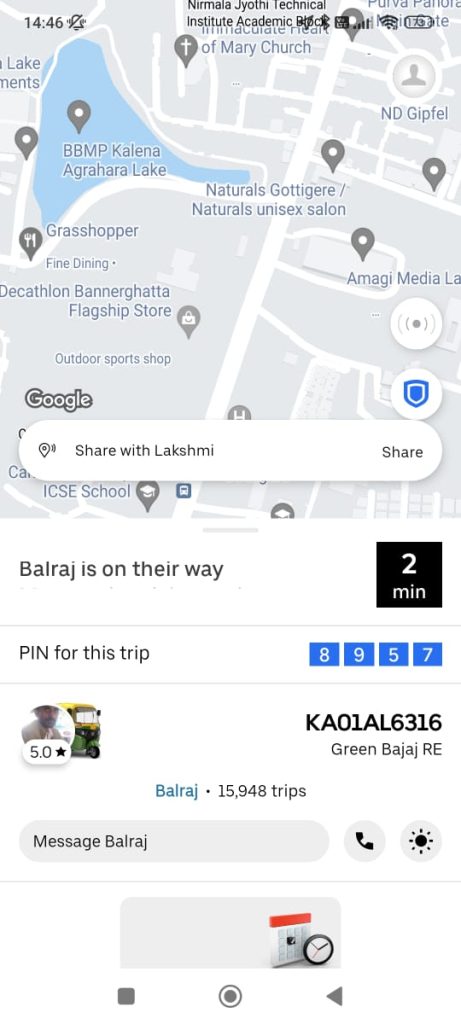
The most luxurious form of public transportation in the city is the Metro. It is primarily an elevated system supported by pillars with reinforced concrete structures, and it has a dual-track layout. The pillars of the existing and new lines are placed in the middle of the main city thoroughfares, allowing the trains to transport you high above the bustling traffic below. In terms of the local transportation conditions, the Metro is not just a floor or two above average; it is significantly elevated. Before they allow you onto the platform, you have to go through a security check similar to an airport. Your belongings go through a conveyor belt and an X-ray machine, while you have to walk through the passage that beeps if you have any metallic objects. Then you step onto a small stool where they pat you down with a magical wand that beeps if you have anything prohibited. For women, this procedure takes place in a cabin draped with fabric on all sides. Once you are on the platform, you find yourself in a completely different world from the one outside. The floors shine and appear so clean that you could eat off them. Everything is well-maintained, and there are surprisingly few people. At least, during our rides, there weren’t many. When you want to buy tickets at the window, it always gets complicated because everyone here wants exact change and they don’t accept banknotes of larger denominations, specifically those worth more than twenty euros. But that’s already a significant amount of money there, and it seems that banknotes of 10, 20, and 50 rupees are too scarce to be handed out to someone who wants to pay a small amount with a two-thousand-rupee note. However, once you successfully complete the transaction, you receive a token that opens the automatic gates to the platform. Upon arrival, all you have to do is “scan” the token, but when leaving the platform at the final station, you have to bid farewell to the token and insert it into the designated slot.
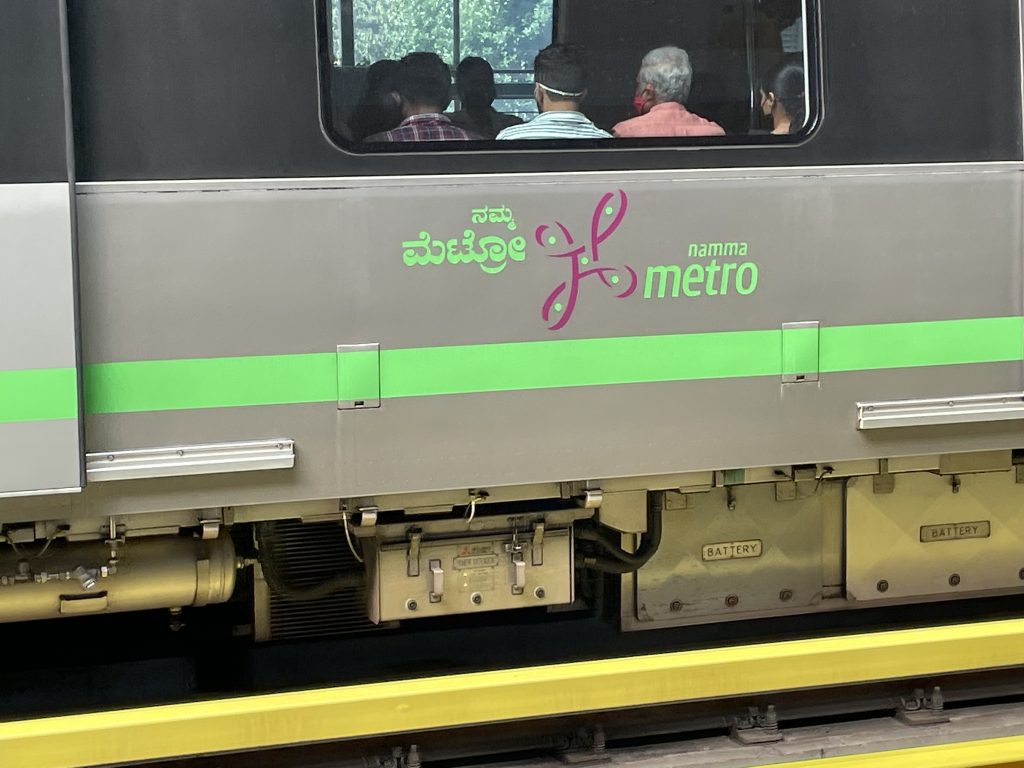
The trains run quite frequently, so we never waited more than five minutes. They are modern, clean, and not overcrowded, although we probably didn’t travel during peak hours when there are more passengers. Riding these trains is comfortable, pleasant, and almost like a panoramic experience. Throughout the journey, you can see how far the vast city stretches into the surrounding area. Since many parks and green spaces surround the main city arteries, you also travel among the treetops. We have a well-known and praised treetop walk in Slovenia, for which you have to pay a significant entrance fee. In Bangalore, however, transportation among the treetops is already included in the ticket price for travelling between two metro stations. You just have to board at the right station and alight at the right one.
Currently, the metro has two operational lines. The green line is over 30 kilometres long and has 29 stations, with only three of them underground. It starts in the southern part of the city at Silk Institute station, runs towards the central area, and then turns north-west, ending for now at Nagasandra station. Perpendicular to this line is the purple line, which is just under 26 kilometres long and has 23 active stations. It also starts where the city is surrounded by the tolled circular highway called NICE ring road, on the western and southern sides. It begins about 8 kilometres north-west of the green line and intersects it in the central part of the city before heading east.
For a city with a population of over eleven million, these two lines are definitely not enough. Therefore, since 2015, they have been constructing the second phase of the network, with planned extensions of the existing lines and the construction of two new lines, yellow and pink, totalling almost 74 kilometres. This means more than doubling the length of the current network, but even that will not be sufficient to provide efficient public transportation for all areas of the city, which spreads over at least seven hundred square kilometres. It would be approximately enclosed by a circle with a radius of 15 to 16 kilometres, yet even that would not cover all densely populated areas that extend along the roads into more rural surroundings.
The deadline for completing the second phase of the Metro is supposed to be in 2024, but given the progress of the work, it is highly likely that there will be a delay of at least a few years.

Doc.aneesh, CC BY-SA 4.0, via Wikimedia Commons)Residence
Bangalore is a vast city in terms of area, and it is also growing rapidly. This is evident from population estimates, which project it to have over eleven and a half million residents by 2023, which is around three million more than the last population census in 2011. As you look around the city, high-rise buildings rise into the sky as far as the eye can see, interspersed with areas of lower construction. In the central part of the city, there are relatively few tall buildings, but instead, countless streets are surrounded by one- to two-story buildings, many of which have small shops or workshops on the ground floor. Here and there, you come across vacant plots that serve as magnets for all kinds of waste. The city also has a significant number of green and water areas. The latter used to be crucial for water supply in the previously agricultural landscape but are now located in the heart of the city, attracting walkers who enjoy the view of the water or even take pedal-powered boats on it. In addition to larger parks like the Lalbagh Botanical Garden and Cubbon Park, there are several smaller parks along certain city roads, placed between traffic lanes going in different directions. Some of these parks also feature children’s playgrounds. They serve as oases amid the hustle and bustle of traffic. One should not forget about private green spaces, such as the area around the Indian Institute of Management. The institute has its buildings dispersed among trees and greenery, creating an environment within the fenced area that feels almost as if you are not in a bustling city of millions. It is a vast oasis that includes student dormitories as well as housing for teachers and their families. It’s like a city within a city, with the latter being a true garden city. Of course, there is mandatory security and a guard at the entrance who allows access to the settlement only for those who work there, are students, or have a valid reason, which needs to be proven and verified; otherwise, one is denied entry. Our son-in-law lived in this oasis during his younger years because his father taught at that institution. Among business schools, it ranks second on the Indian scales that evaluate these schools, and globally it is ranked between the thirtieth and fortieth position. The comedy film “Three Idiots”, which humorously depicts the wrong approach to education, a problem prevalent not only in India but also in many other parts of the world, was also filmed within this campus.
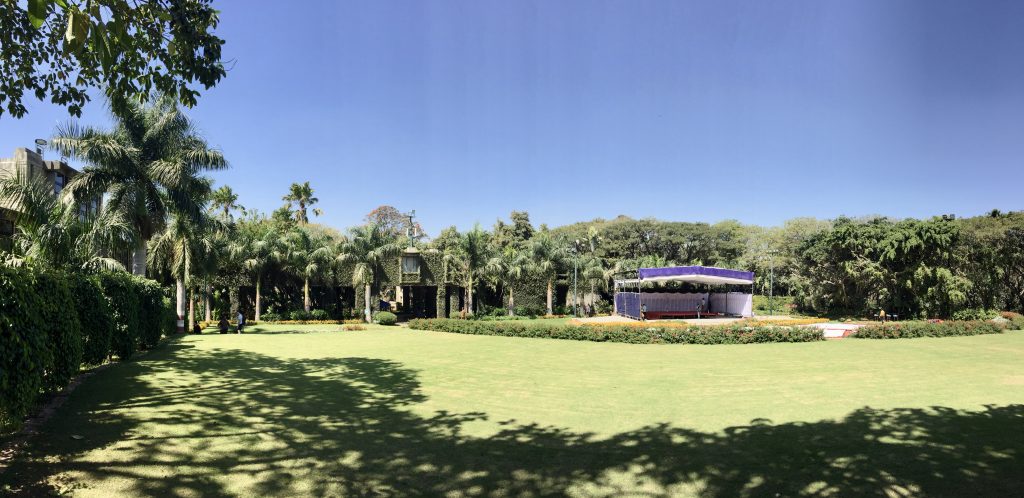
Not far from the campus of the Indian Institute of Management, Bharat’s father bought an apartment where we stayed during our visit to India. Two decades ago, when the neighbourhood, known as Mantri Woodlands, was being built, it was still an area outside the city. But today, it is surrounded by development extending several kilometres further towards the current southern outskirts of the city.
Mantri Woodlands is a gated community, or rather, it could be better described as a guarded neighbourhood. Access from the main street is secured, and entry is similar to the aforementioned institute. You can only enter if you have a valid reason. Besides being a resident or a visitor, this includes food delivery, various package deliveries, housekeeping services, home repairs, and similar. However, unless you announced your arrival to one of the at least three “receivers” who monitored the comings and goings at the entrance to the neighbourhood, you could not use the street connecting the neighbourhood to one of the main city thoroughfares. The guarding personel quickly got used to us, and they didn’t stop us but greeted us respectfully. In addition to the security guard at the entrance, the neighbourhood also has a dedicated guard for the open parking areas located under the blocks. The blocks are raised on pillars about a meter above the ground, creating parking spaces with enough daylight that you don’t feel like you’re in a basement. The ground floors are elevated half a floor above the courtyard level, and since each block has only 16 apartments, there is enough space beneath them for at least one vehicle per apartment. During the day, light reaches the parked vehicles through a sort of sanitary-light shafts that run through the buildings, with toilet windows lining the narrower shafts and kitchen windows lining the wider ones. Architecturally, this solution may be well-conceived, but in practice, it proves to be quite impractical, as these shafts in the reinforced concrete structure act as sound carriers from one window to another. Especially the narrower shaft with toilet windows creates the impression that the entire building shares one single bathroom. Sounds from the bathrooms of all the apartments can be clearly heard, whether it’s someone coughing, splashing water on themselves, or producing any other sound typical of toilets. With open bathroom doors, even louder conversations are transmitted from one apartment to all the neighbouring ones. The same applies to conversations or engines starting in the parking area under the building.
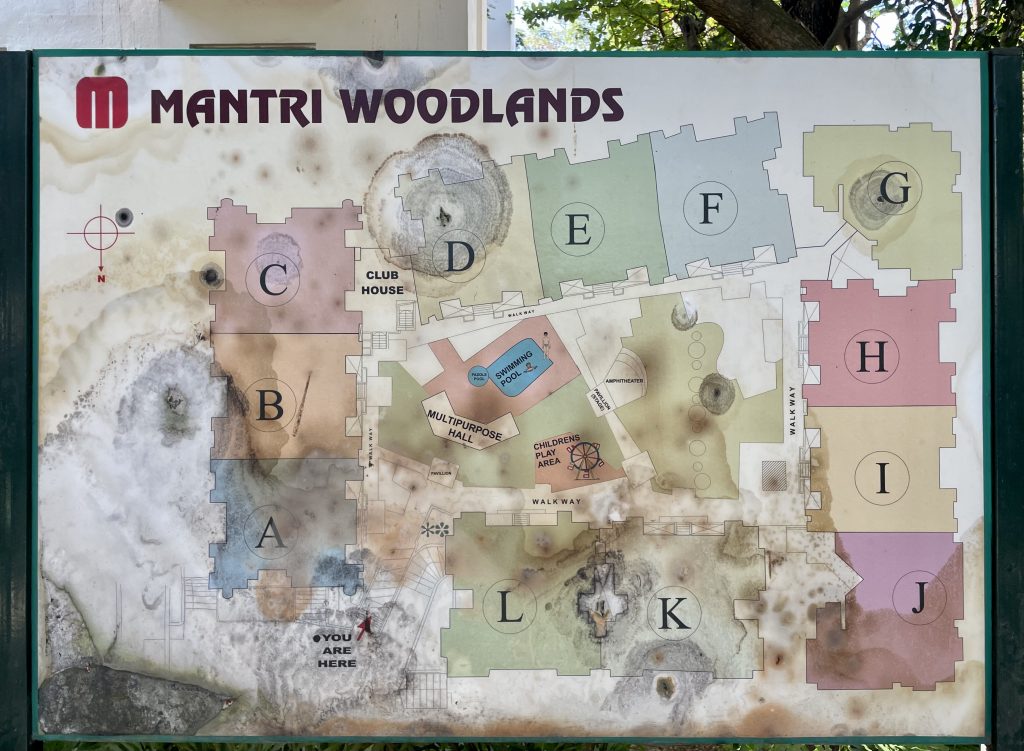
The architectural concept of the entire neighbourhood is interesting and diverse. The four-story blocks surrounding the courtyard are not simple cubes but appear as if they are composed of numerous white houses with red roofs, ascending and descending in different heights. The highest point is always the roof above the central staircase with an elevator. Additionally, four apartments are lined up on each floor. The apartment where we stayed was a duplex, with an entrance on the third floor. Internal stairs from the living area led to an additional room, bathroom, and rooftop terrace. On the third floor, besides the living area, there was a small kitchen, a bathroom, and two rooms. The fourth floor had the aforementioned room with a bathroom and a large terrace overlooking the treetops in the courtyard. The size of the courtyard was approximately 20 to 30 times 70 meters. In addition to trees and flowers, the courtyard housed a decent-sized swimming pool, a small children’s playground, two badminton courts, a small event space with a stage and bleachers, and a small enclosed pavilion for socializing while playing table football or board games. They also had several outdoor fitness machines set up in the courtyard. I often saw older ladies exercising on them, but not gentlemen. The table football in the pavilion had also seen better days and was unusable. The swimming pool was also unused, or more accurately, not used. From what I could see, it served only for the diligent maintenance staff to clean it every day, but I never saw anyone swimming in it. Maša said it’s not because the water is too cold in January, but rather because people don’t know how to swim. Considering that I showered with unheated water throughout my stay in India, I assume the pool water couldn’t have been too cold, especially since temperatures never dropped below 20 degrees at night and were close to 30 degrees during the day. However, I didn’t go swimming either; I felt awkward. Perhaps! Well, who knows.
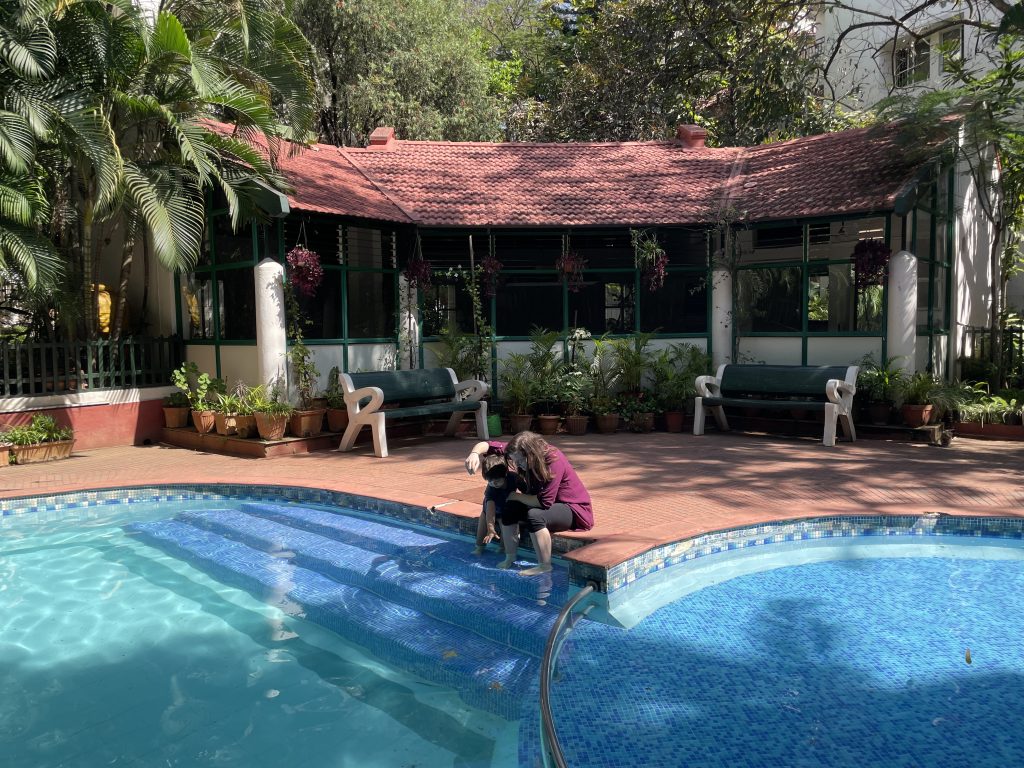
I have already mentioned that the maintenance staff cleaned the swimming pool every day. But that’s not all. They were constantly tidying up and sweeping leaves in the courtyard. While it’s all well and good, considering that there is no grass beneath the leafy trees, it might have been more aesthetically pleasing to let the fallen leaves remain on the ground and only sweep the sand in the children’s playground and paved areas. They also washed the staircases every day, even though residents only used them in emergencies when the elevator wasn’t working. However, when the elevators were operational, their noise could be heard throughout the building. Not because they were particularly loud, no! These elevators have outer doors and inner safety accordion doors that need to be closed after exiting, otherwise, the elevator remains on the floor where you left it. To prevent anyone from inadvertently leaving these inner doors open, as soon as you start opening them, a loud warning voice, a woman’s voice, can be heard repeatedly saying the same sentence: “Please close the door! Please close the door!” The “woman” doesn’t stop until you close the doors again. The building has stairwells labelled from A to L throughout the entire neighbourhood. When you reach the first block after a 70-meter driveway, you’ll find entrances A, B, and C. Behind it stretches the aforementioned courtyard for about 70 meters, with the remaining blocks lined up on both sides and at the end. There are parking lots beneath all the blocks, and a driveway about 400 meters long surrounds them. Since there isn’t much traffic on it, it’s also suitable for walking. One of the residents even cycled on it, or rather, walked on the bike, moving at the pace of a slow pedestrian. But it’s better than having to venture into traffic and navigate through the congestion to find a more attractive form of exercise. Maša and Bharath also took walks and runs around the blocks. To me, it seems infinitely less appealing than at home, where you can go running or cycling anywhere in the surrounding countryside, practically in untouched nature. Here, you have to drive at least fifteen minutes to the nearest park, and three times that to reach a slightly larger one. That’s why having those 400 meters around the blocks is all the more precious, especially because there are tall trees all around, giving the impression that you’re not entirely in a concrete jungle, but at least somewhat close to nature. In that sense, the neighbourhood is also an oasis in the midst of a densely built city. Between the neighbourhood and the main road, there is a plot of land that is almost completely overgrown with trees along the driveway. In the courtyard between the blocks, there are coconut palms, acacias, almond trees, araucarias, and who knows what other trees. Along the fence surrounding the neighbourhood, mighty tall trees are tightly lined up next to each other. All these canopies host a colourful bird community, and occasionally, local squirrels with two stripes on their backs chase each other through them.
The most abundant, as is the case in our cities as well, are pigeons. Two of them were determined to start their brood on our terrace, specifically on one of the railings of staircase A. From there, twigs for their nest and their droppings would fall onto the stairs leading from the courtyard to the ground-floor apartments and the staircase with the elevator. If the pigeons weren’t so careless and didn’t defecate wherever they pleased, coexisting with them would have been much more pleasant. As it is, unless the terraces are constantly cleaned, they can get quite dirty. Dust also accumulates quite a bit during this dry period when there is barely any rain, and many trees shed their leaves, just like in our winter.
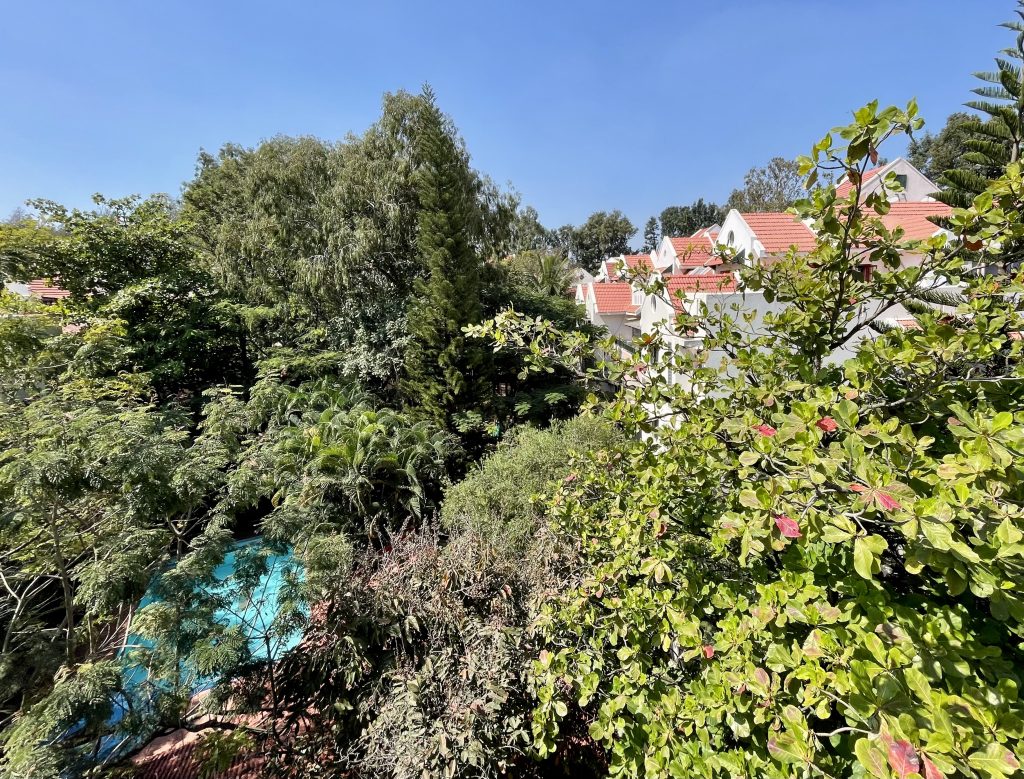
At these summer temperatures, they have another nuisance here in winter, which is very familiar to us: mosquitoes. It seemed to me that they became more active towards the evening, while for some time now, we have had no peace from them during the day or night. Well, I often sought refuge indoors to escape them, although they would still find me there and mercilessly wake me up from sleep with their buzzing. The evening battle before sleep was not very successful. In the upper room where Julija and I slept, the ceiling was aligned with the roof structure. Yes, our room had its own little roof, which was about four meters above us at its highest point. So high that I couldn’t even throw a towel to the top, let alone hit a potential lurking mosquito with it. However, every room here has at least one ceiling fan hanging from a long rod. When you set it to full speed, even the mosquitoes move away. If the roof hadn’t been securely attached, it probably would have flown away as well, as the fan blades spun so fast at the highest speed. But mosquitoes are cunning, like the devil himself, and they hide in closets, under the bed, under hats—basically everywhere. Just when you think you’ve gotten rid of the last one, you turn off the light, close your eyes, and after a while, when you’re almost asleep, you hear the buzzing. You listen carefully! Nothing. You almost fall asleep again and then you distinctly hear, as clear as it gets, the buzzing right next to your ears. You let out a battle cry and again: “To battle, courageous blood!” Probably with the same result as the first time. But I’m used to it because even back home, although our ceiling is only two and a half meters high, one always manages to slip through and feast on me. Quite literally, and with buzzing. I don’t know which is more annoying.
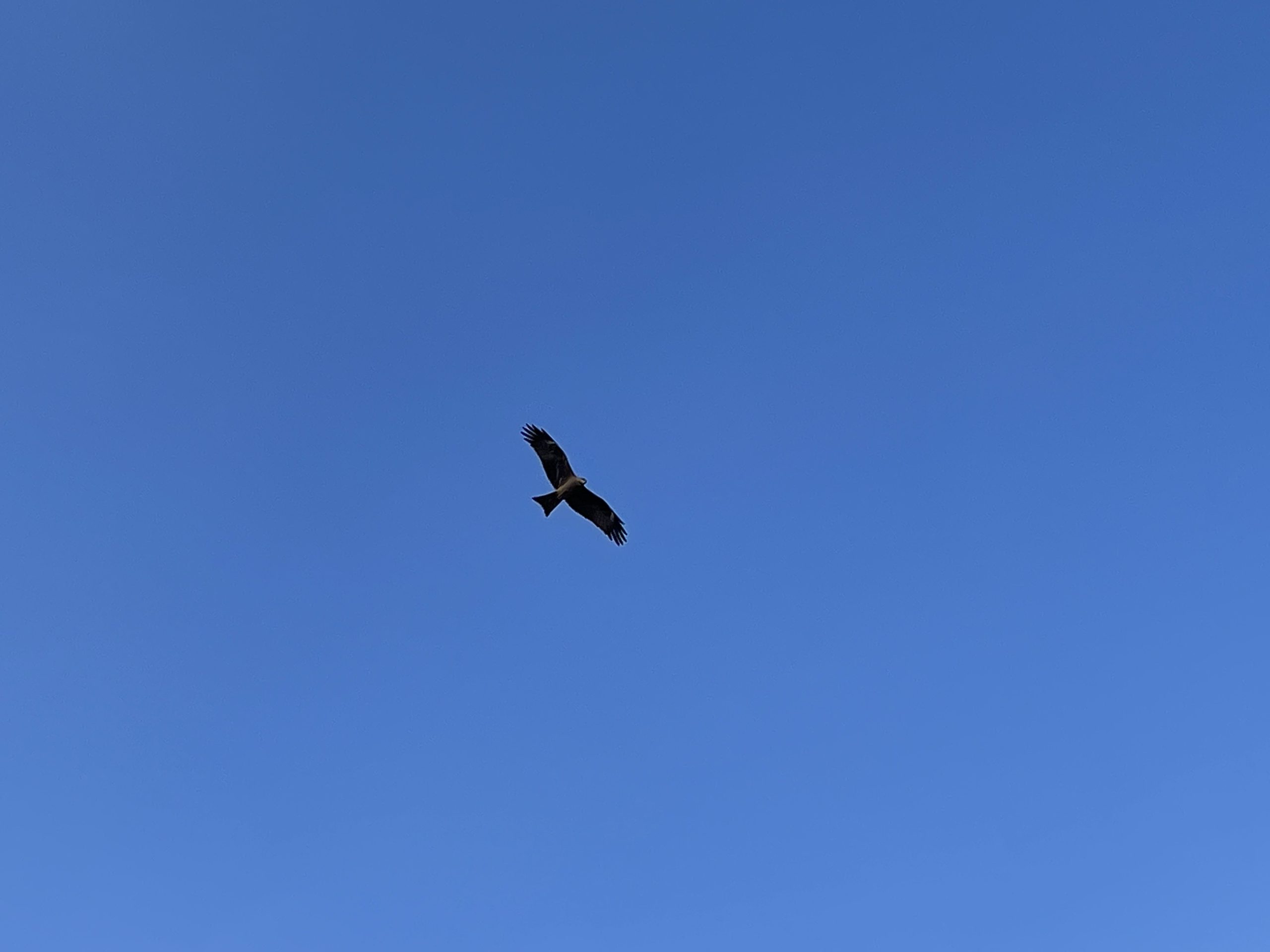
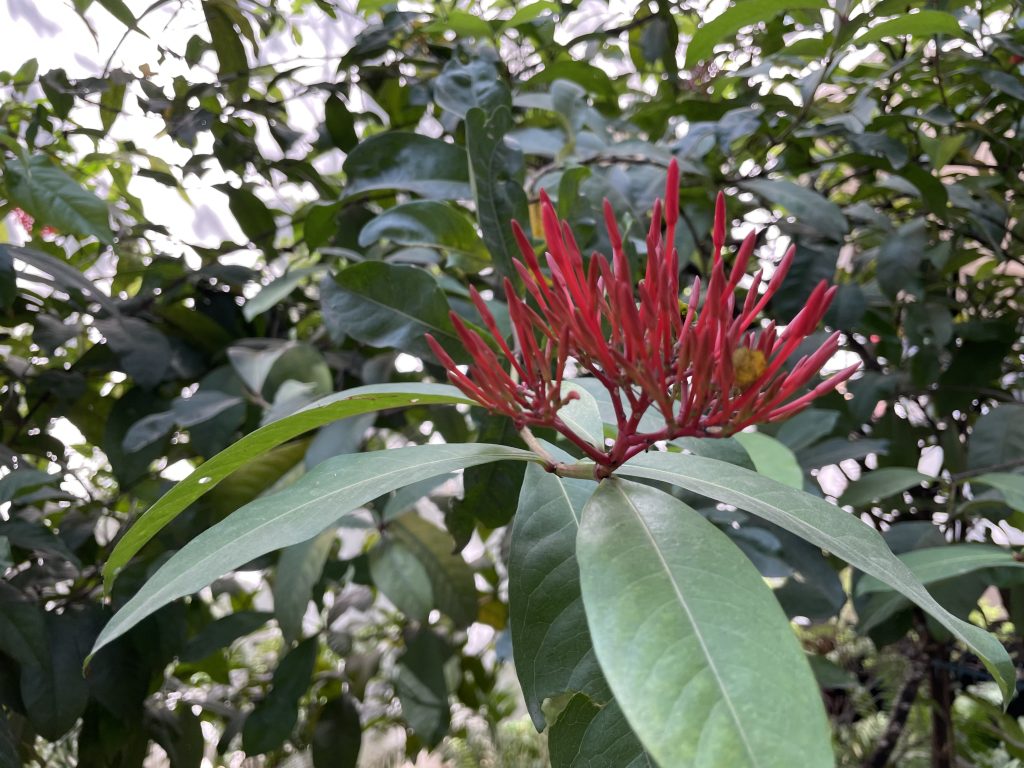
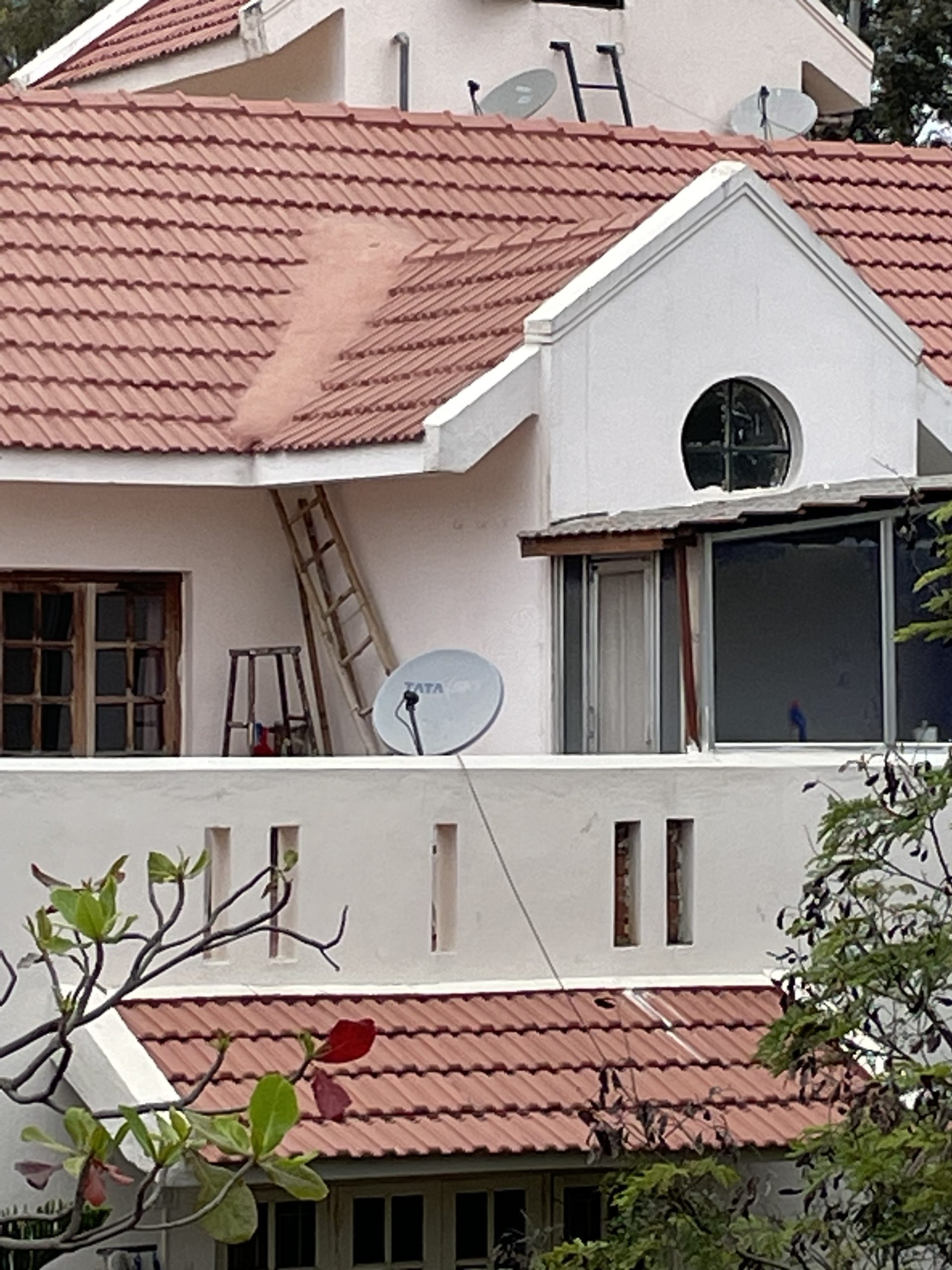
In the apartment, I should also mention that all the rooms have ceramic tiles on the floor. The doors have an additional latch on the inside and do not close tightly like they do in Slovenia; there is a gap underneath and on the sides. The hinges are also more robust and secured with screws, which is necessary because the doors appear quite heavy. The bathrooms are relatively spacious, but unlike our bathrooms, they do not have any bathtubs, even though there is enough space and the plumbing allows for installation. The reason is that they wash themselves by pouring water. They fill a plastic bucket with water and have a plastic jug next to it. Then they use the jug to scoop water and pour it over themselves. It is certainly more water-saving than showering, let alone bathing in a bathtub. The bathroom also has a toilet bowl, which, in addition to the flush tank, has a special “mini shower” with a handle to activate a jet of water, intended for cleaning the posterior after using the toilet. It is far from being as sophisticated as Japanese electronically controlled toilets, but the goal – a clean behind – is achieved in this way as well.

Life in the safe and warm haven of a guarded neighbourhood in the metropolis has several other advantages. All you need is practically just a click or a call away. You take your phone in your hands and order food from a restaurant, things from a store, and if it’s not too late at night, you can expect delivery in the shortest possible time. Delivery drivers often rang our doorbell, even at ten in the evening. Often Bharat’s sister Lakshmi would order something for us, and the delivery drivers would bring it to our address. You can also order transportation from the couch, and it will come to pick you up right in front of the building, especially if you’re travelling with luggage that needs to be loaded into the vehicle. But if you’re just going around the city, they will wait for you on the main street at the entrance to the neighbourhood. Even if something breaks or gets damaged, you don’t have to wait long and search to find a master who can fix the broken or damaged item. Within a few days, both Julija and I managed to break our supposedly unbreakable glasses. They didn’t actually break, just a screw came loose and they split into two pieces. Bharat and Maša quickly arranged for repairs with the local craftsmen, who grumbled a bit about not having the right tools for these outdated screws, so it took a little longer than expected, but in the end, the repair was successful and apparently in at least one case even free of charge. Repairing my tooth was a bit more complicated. The dentists were afraid to remove the loose fillings and fix the tooth, I’m not sure why because I didn’t quite understand them. They were definitely considering a procedure that would require at least two, if not three, appointments, but my schedule didn’t allow for that because I already had accommodations reserved for our Indian vacation. So I survived with only the left side of my mouth functioning on all these Indian journeys. As one of my teeth has been missing on the left side for a long time, that’s exactly where the sharpest pieces of food ended up, when eating which is far from pleasant, but I managed to survive without any toothache. In the Indian dental clinic, they were amazed at how a tooth in such a bad condition didn’t hurt at all, so I was a little worried about when their concerns would manifest in unbearable pain. Fortunately, that didn’t happen, and back home, my dentist Andraž successfully filled the cavity in a single appointment. Now we both hope that the amalgamation will work well.
Eating
One of the important spaces in the apartment we lived in was the kitchen, so it was possible to prepare food there, similar to what we were accustomed to at home, we just had to get the right ingredients. There was no problem with chickpeas; they have even better ones than we do. That was already a basis for me to try making vegan pancakes. Even jams were easy to find in India. You can even buy Italian bread, although it’s far from the abundance of bakery delights available almost everywhere in our home country. However, there was no oven in the kitchen for baking bread myself. Nevertheless, in India, they have various types of bread, but they are all closer to tortillas than our loaves and rolls, not to mention bagels. But when you’re in India, it’s appropriate to eat like an Indian. You can also prepare Indian food yourself if you know how. Maša is already quite good at preparing some dishes, which is not self-evident at all. India is a land of spices, and you can’t just add them to dishes as you please; the proportions have to be right to achieve a tasty dish. I didn’t venture into adding spices, but I was useful for cutting, for example, eggplants, which are called “brinjal” in India, or okra. You can prepare a dish from lentils and various vegetables, which is kind of like a sauce or stew, and they call it sambar. You eat it with rice and some of their types of bread, like “roti” or “chapati” in English. It’s made from wheat flour and water and is unleavened. You can buy it, just like tortillas here, and then simply toast it on a greased pan. In one of the restaurants on Havelock Island, they had a baker in a kind of display at the entrance, who baked such bread. He already had prepared dough balls, which he then flattened and stretched into thin round pancakes, just like a skilled “picopek” (a term for a skilled pizza-baker). He then placed them on a round grill mesh with a wooden handle and grilled them directly over the open fire. During this process, the bread puffed up like a ball, but when he placed it on a plate, it flattened again. The bread that puffs up, which is made from the same ingredients but is fried, is called “puri,” and it is mainly served for breakfast with vegetable dishes, but it can also be eaten with sweet dishes. I didn’t remember many food names, especially because the list was always long. You have options between “veg” and “nonveg” as well as North Indian and South Indian dishes. “Veg” doesn’t mean vegan, which is my current dietary style, but vegetarian, which includes clarified butter or “ghee” and milk but not eggs. Even if you know the name of the dish and its main ingredients, you can’t be sure if they haven’t added any dairy or egg products to “enhance” the taste. In some restaurants where I ate, I had the honor of meeting the head chef who, after consulting with me, had the food prepared in the kitchen according to my preferences, without dairy products and eggs. I didn’t fully understand everything he explained to me, but what was served on the table was always delicious, and I believe it was also without animal ingredients. However, at self-service breakfasts, I often had to rely on my own instincts, so it’s entirely possible that I occasionally consumed dairy products without realizing it.
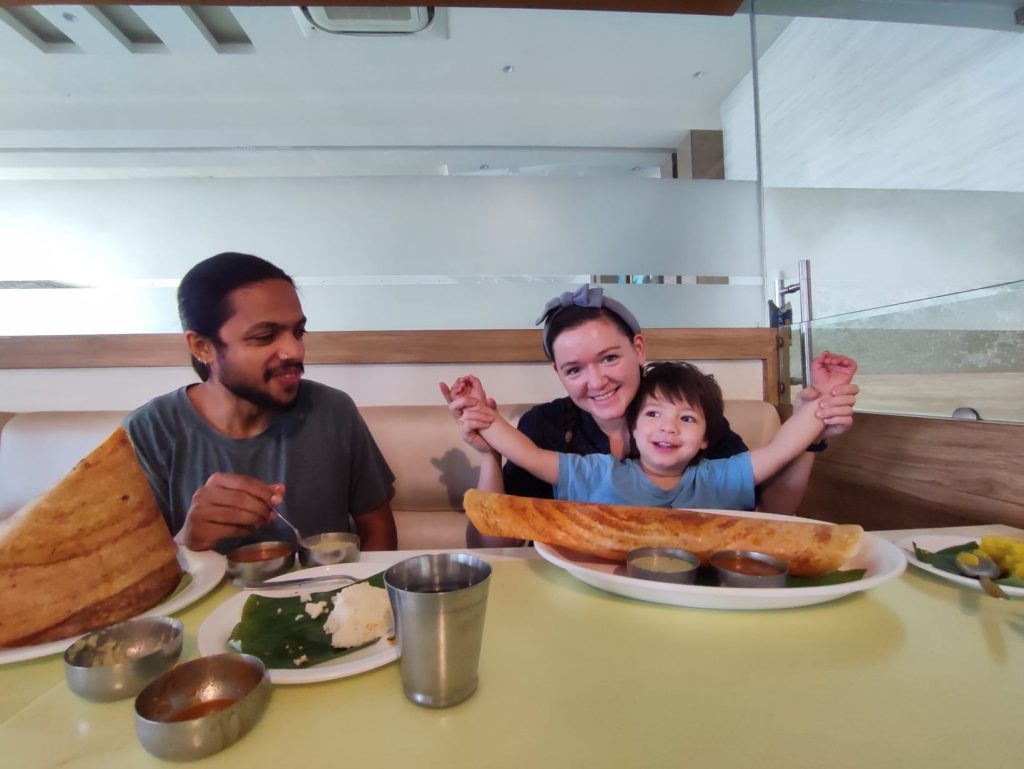
From the dishes that I still remember by name, I would mention “idli.” It is usually eaten for breakfast and is supposedly made from fermented husked black lentils and rice. It is white in colour and looks like our soup spoons, except that “idlis” are larger. While idli is a true vegan dish, the same cannot be said for “kesari bhat.” It contains both “ghee” and milk. During my first visit to India three years ago, I could still enjoy this sweet dish because I believed that “veg” meant plant-based for them, but as I now know, I was mistaken. However, after returning home, I continued to prepare my own vegan version of “kesari bat.” The main ingredient is wheat semolina, and instead of milk, sugar, and “ghee,” I added various nuts, raisins, and dates and cooked it into a thick lump. Then I sprinkled it on a plate, and it actually resembled a bit of Indian “kesari bhat.”
Another name that stuck in my memory is “chutney.” It is one of those things that you get in small, usually metallic bowls as an accompaniment to the main dish. In South Indian cuisine, coconut chutney is particularly popular since they have an abundance of coconut palms. You often come across people on the streets who chop off the top of a still green coconut, allowing you to drink the liquid inside through a straw. Then they split the coconut and make a handy spoon out of one piece, with which you can eat the soft interior. The remaining coconut ends up in a pile next to a heap of untouched coconuts, waiting for thirsty customers.
Regarding dining, it’s worth mentioning that in most restaurants, cutlery is provided, but the Indian way is to eat with your hands, or more precisely, with your right hand. For example, you press their flat, pancake-like bread against the plate using your middle finger, and with your thumb and index finger, you tear off a piece, which you then dip into one of the spicy condiments or use to eat a small handful of the main dish. Add-ons like sambar can be mixed with rice, and then you scoop up some of the mixture using the pads of your thumb, middle finger, and ring finger, pressing it against your other fingers before bringing it to your mouth and pushing it in with your thumb. With a bit of practice, even someone as bearded as I was in India can successfully eat this way. It’s worth noting that there are many bearded men in India, so I didn’t stand out with my beard at all.
From beards and “beardos” back to food. When we didn’t eat at home, we dined at restaurants. Some of them would barely deserve the name according to our standards, but none of us ever had any digestive issues as a result of dining in these seemingly modest places. However, we didn’t eat street food. At least I didn’t, although the others tried it occasionally, it was more of an exception than the rule. In India, you can see for yourself that the Slovenian saying “Looks can be deceiving!” holds true. No matter how basic the place looked, they always had sinks where you could wash your hands before eating. Filtered and bottled water was offered for drinking. We also drank filtered water, and it didn’t have any noticeable effects on our digestion.
As I mentioned at the beginning, India is a land of great differences and diversity. Among the better restaurants in the city, the ones that have a shop on the ground floor and in the surrounding areas are particularly interesting. You can find a variety of items there, from clothing and souvenirs to garden benches and wells. Exploring all these products makes the waiting time for food pass quickly, and at the same time, you can buy something nice, whether you need it or not.
Bangalore attractions
On one of the websites that advise on what is worth seeing in Bangalore, the following places are listed in order: “Cubbon Park, Nandi Hills, Tipu Sultan’s Palace, Lalbagh Botanical Garden, Bangalore Palace, ISKCON Temple, and the National Gallery of Modern Art.” Of these, Nandi Hills is not even in the city; you have to drive about 60 kilometers to enjoy peace and greenery there. We didn’t go to see it because we have an abundance of peace and greenery in Slovenia at every step, and Julija and I have already experienced that during our previous visit to India when we visited the Jog Falls. We were practically the only guests at that time in a small holiday resort of charming wooden houses amidst vast forests near a large artificial lake with crystal-clear water that doesn’t fluctuate and therefore lacks those muddy, overgrown shores typical of the reservoirs of Indian hydroelectric power plants.
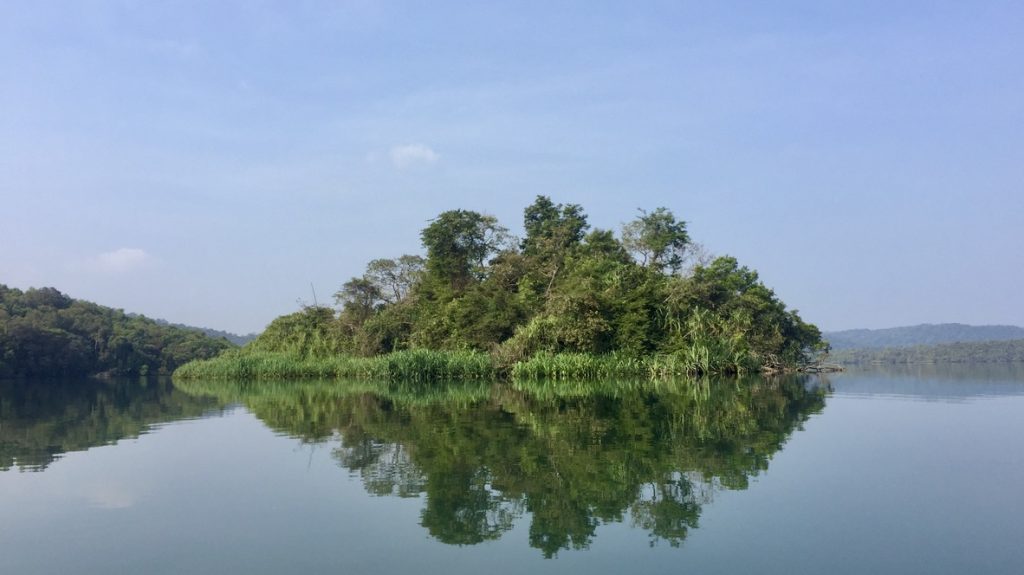
We didn’t go to see the temple and the National Gallery of Modern Art among the other listed city landmarks. On a slightly longer TripAdvisor list, there are three other temples, one of which we went to see, but it didn’t leave a special impression on me. It is built on a rock and dates back to the second half of the twentieth century. It is dedicated to Hanuman, one of the Hindu deities, and has the form of a monkey. He is an immortal being with numerous supernatural abilities. In the famous Indian epic Ramayana, for example, he can shrink to the size of an ant or grow to an enormous size. When he is sent to the Himalayas in the epic to fetch a healing herb for the wounded brother of the main hero Rama, Hanuman realizes that there are many herbs, and to avoid plucking the wrong one, he enlarges himself so much that he can uproot an entire mountain with all the herbs and fly with it far to the south of India to save the wounded brother, who would otherwise surely die. During the visit to the shrine, I didn’t know whom it was dedicated to or in which stories it appeared. This shows how important the spirit of the place is. If you come and simply look at the walls, fences, and altars, you perceive them in a completely different way than if you connect all of that with myths, beliefs, and stories that are associated with what you see and come to life in some way when you find yourself in their midst. Furthermore, the “Ragigudda Anjaneya Temple” is also characterized by its charitable activities and plays an important role in the education of the underprivileged who would otherwise be unable to attend school. And one more thing! When you enter the sacred land, that is, the area of the shrine, you have to take off your shoes and deposit them in a huge wardrobe, indicating the large number of visitors who gather here on various occasions related to their beliefs. Back to the top!
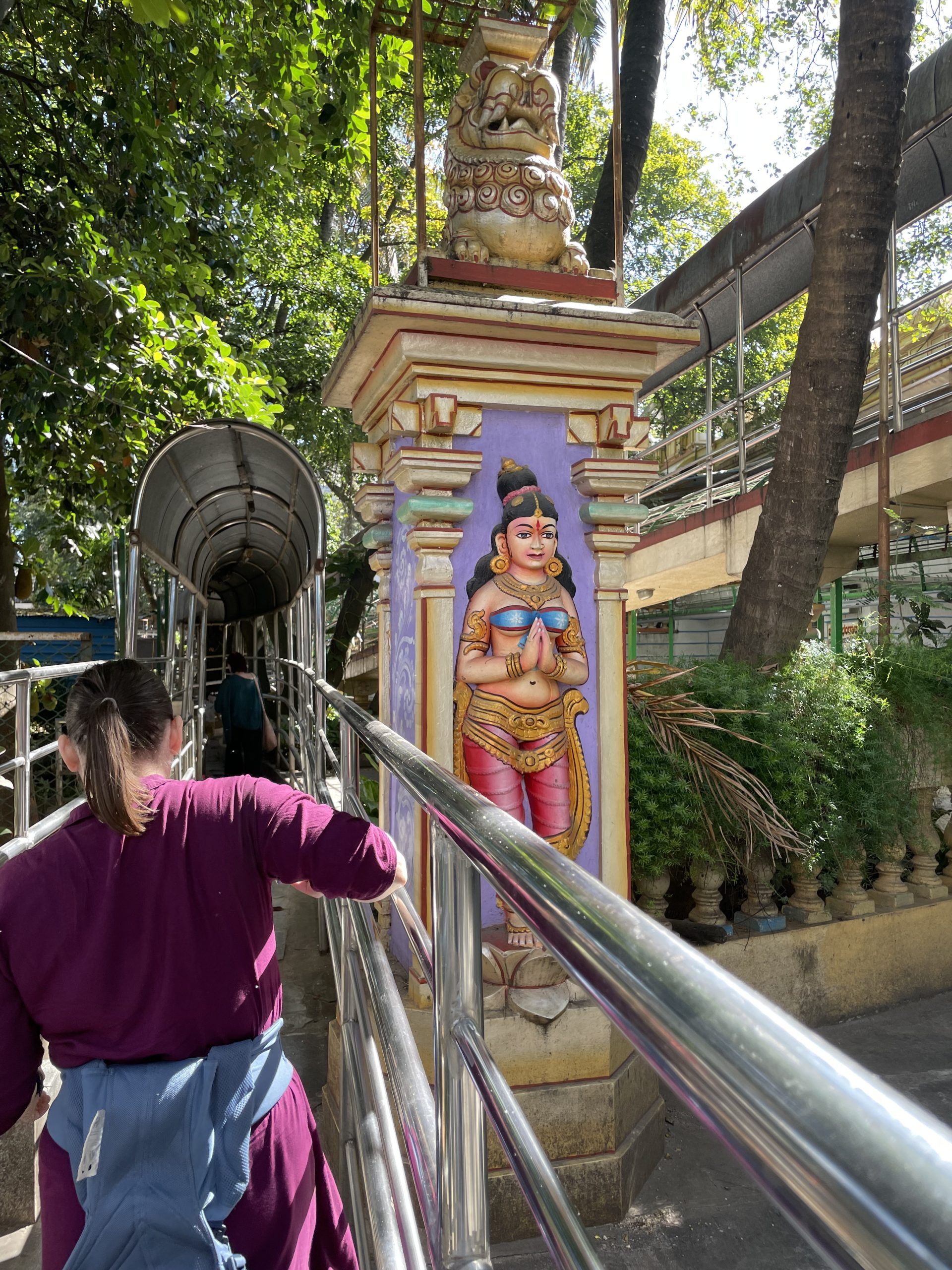
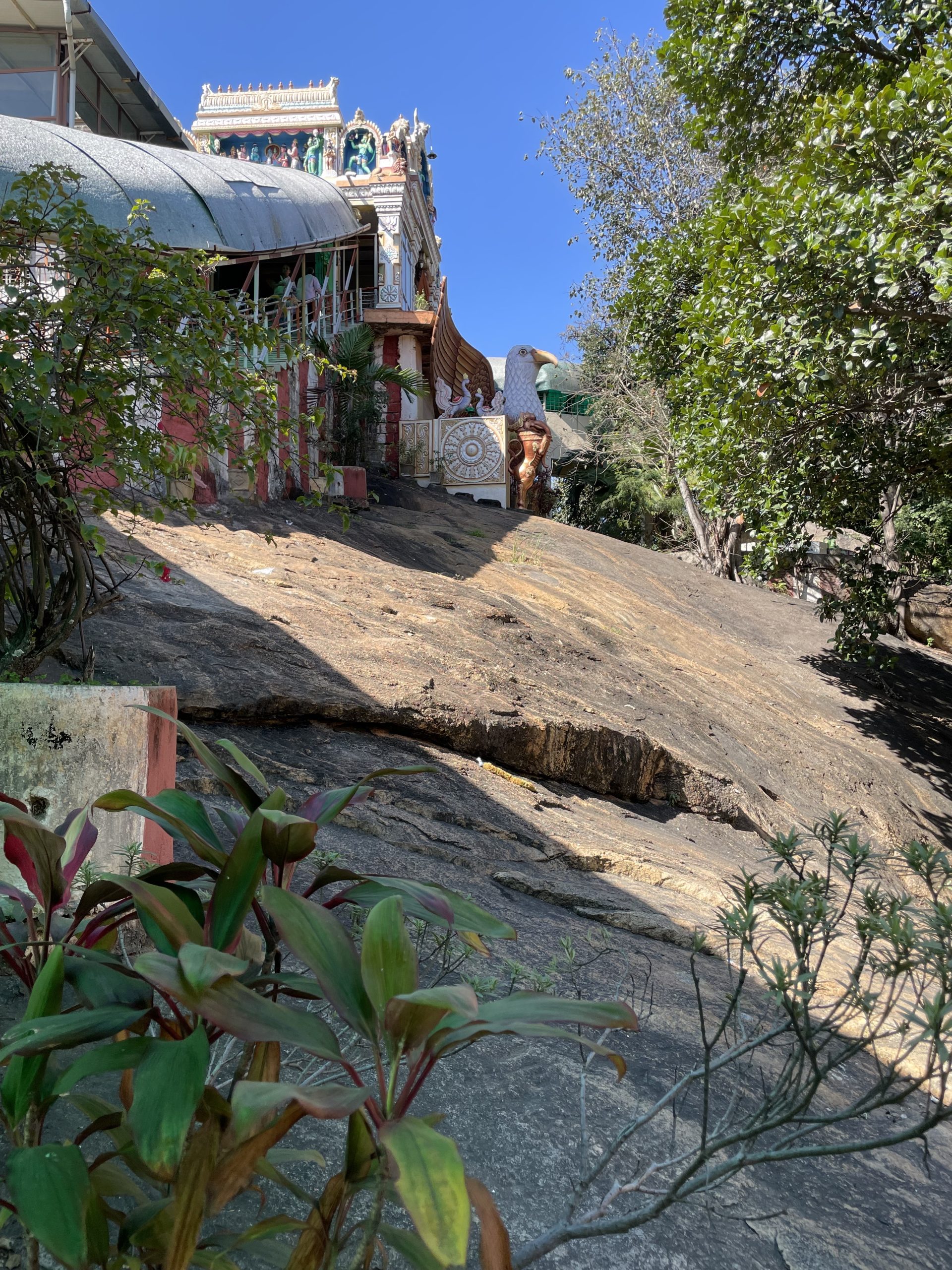
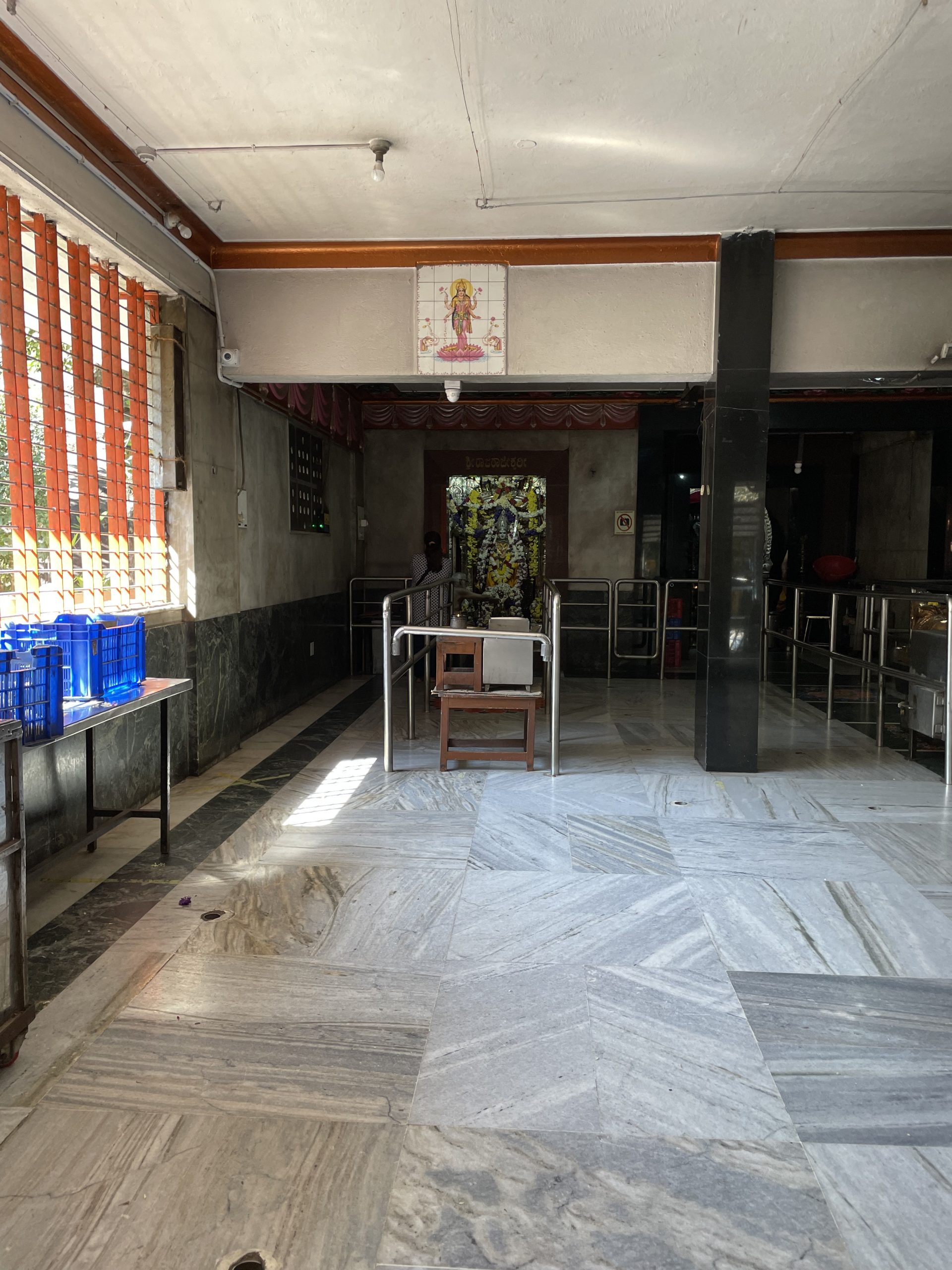
It seems interesting to me that two of the larger green spaces in the city are included among the “top attractions” on various lists. This is probably because, in such a vast and bustling city, they are places of disconnect, a break from the wild hustle and bustle, a place of relaxation, rest, or recreation if you want to run or simply walk among the magnificent trees and shrubs of Cubbon Park or the Lalbagh Botanical Garden. The latter was closer to us, and we visited it multiple times. It also has a lake, a large greenhouse (although it was closed), a wide, bare rocky hill with a small shrine on top, and countless paths, mostly pleasantly shaded by the canopies of enormous trees. I found the ficus tree avenue particularly interesting. What we know as ornamental plants for our homes and offices are truly majestic trees in southern India. Back to the top!
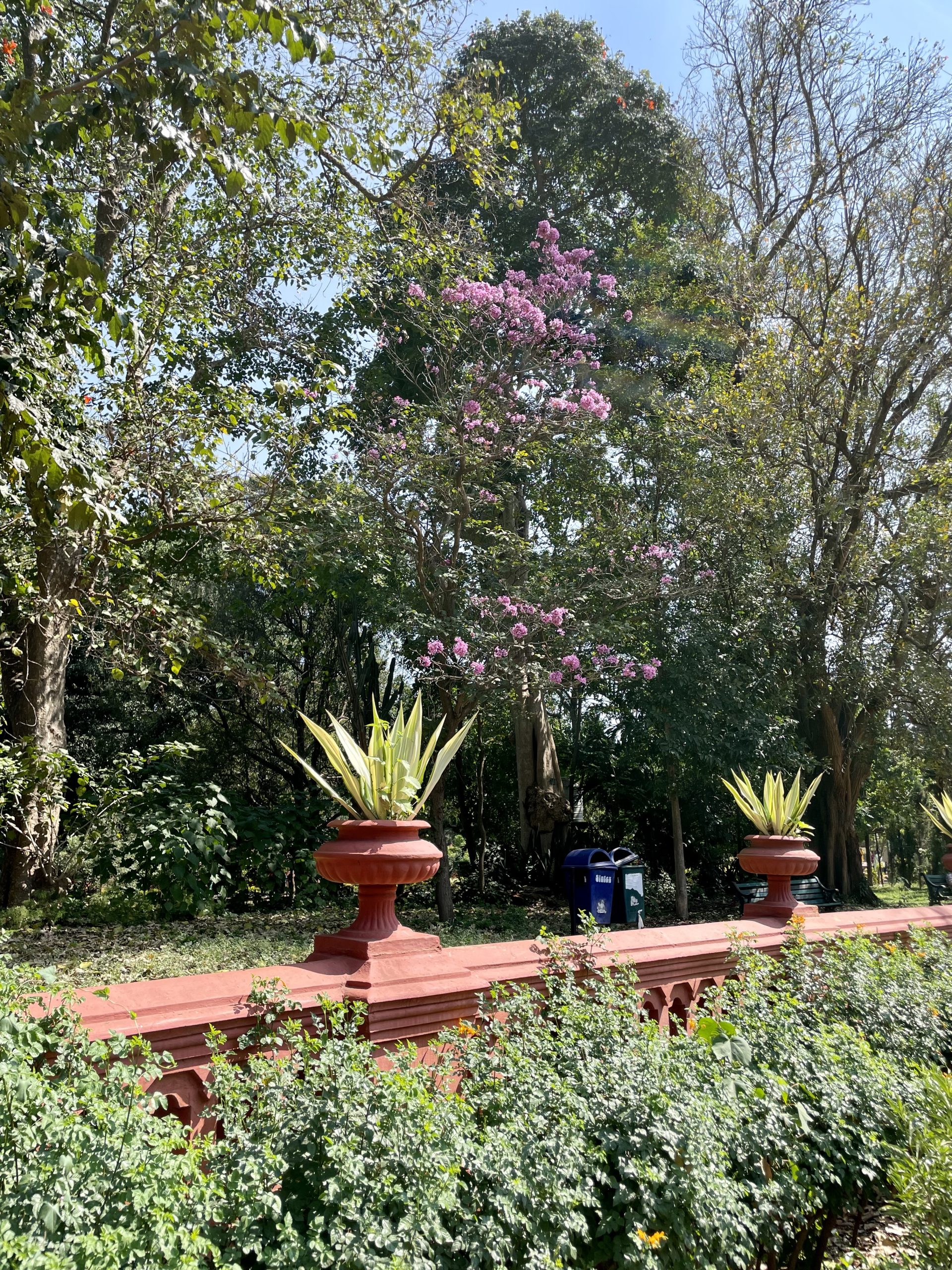
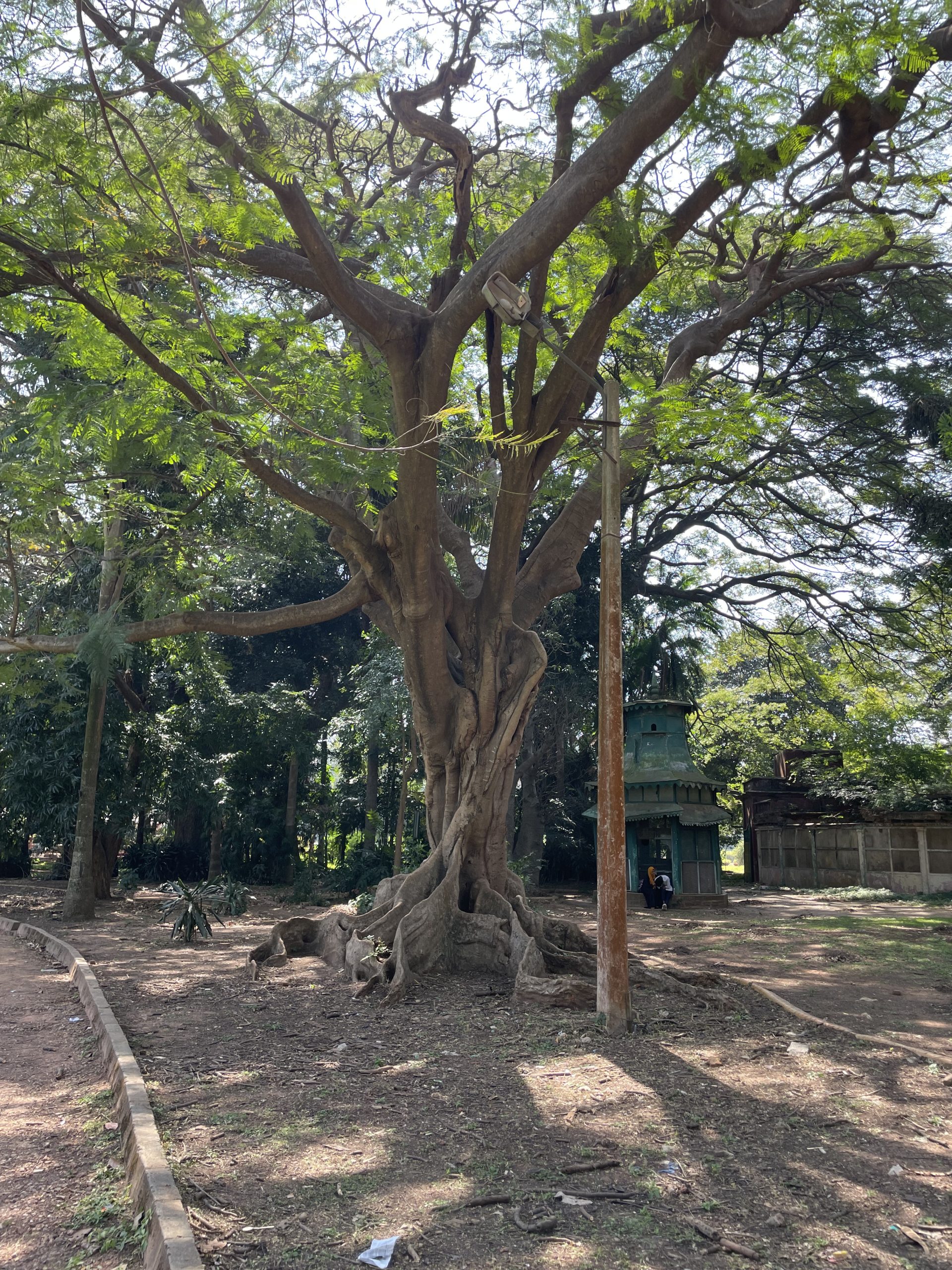
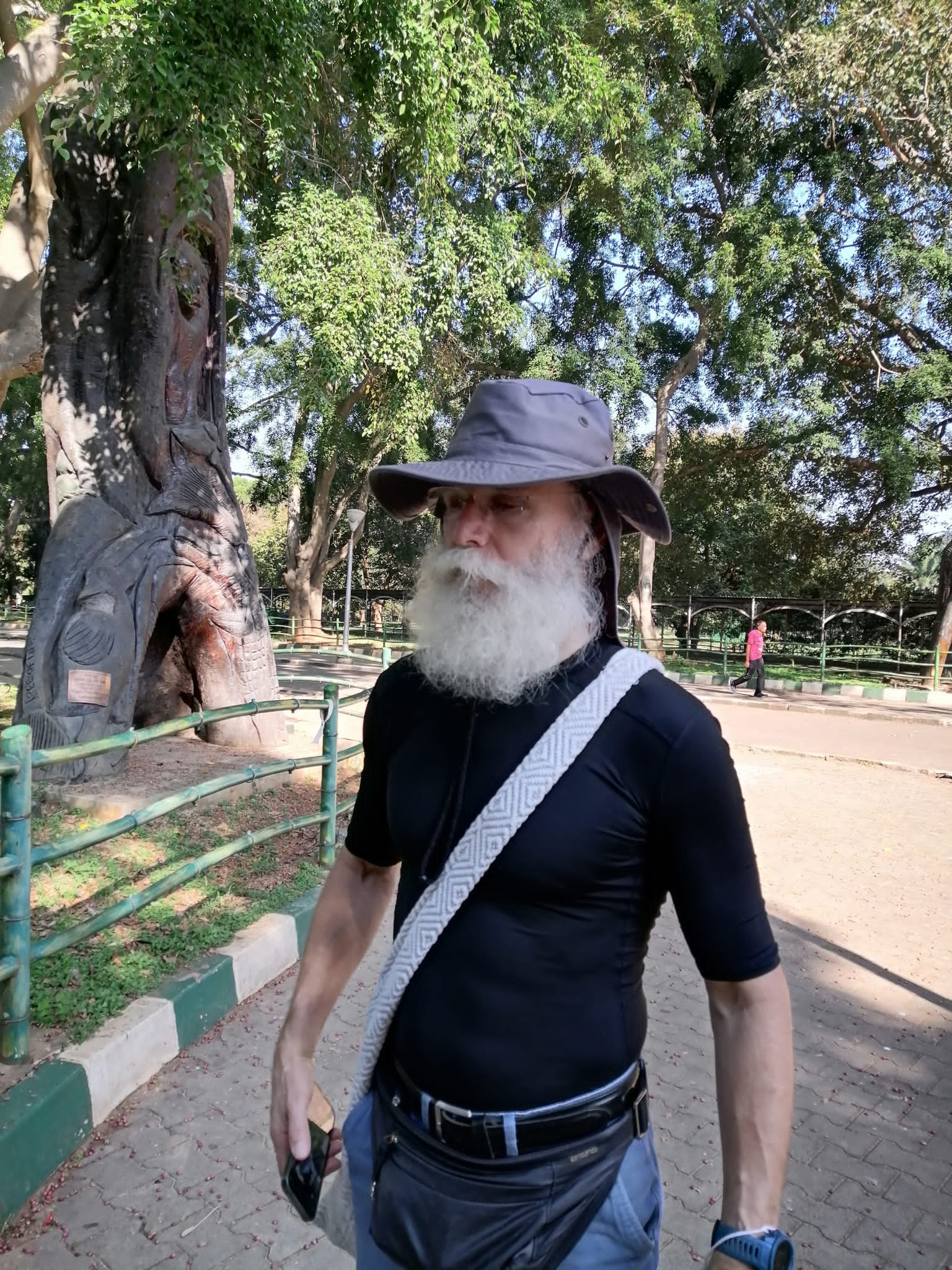
Cubbon Park is in close proximity to the Bangalore cricket stadium. Next to the stadium, the Karnataka Cricket Association has its own club with a hotel, a swimming pool, a gym, and several smaller restaurants. Bharath’s friend Ravish is a member of the club because his grandfather was one of the founders or perhaps the first presidents—I’m not exactly sure, but the essential thing is that Julija and I were able to get a room as his guests in the club’s hotel. The accommodation price was quite affordable considering the room’s standard, and dining in the club’s restaurants was ridiculously cheap. This hotel served as a good base for visiting some attractions in this part of the city, which is about an hour’s drive away from the apartment in the Mantri Woodlands. Maša would come to visit us with Sky so that we could go around together. Sky could take his afternoon nap in our hotel bed, allowing us to have more time than if we had to return to the apartment for his nap, which would take an additional hour, and then spend another hour navigating through the city’s traffic to reach places like the palace or the amusement park. Both of these are closer to the mentioned club than to the Bharath’s apartment, and we visited both. In between the two visits, we treated ourselves to lunch at one of those restaurants that have a shop attached and, to top it off, offer vegan dishes on their menu.
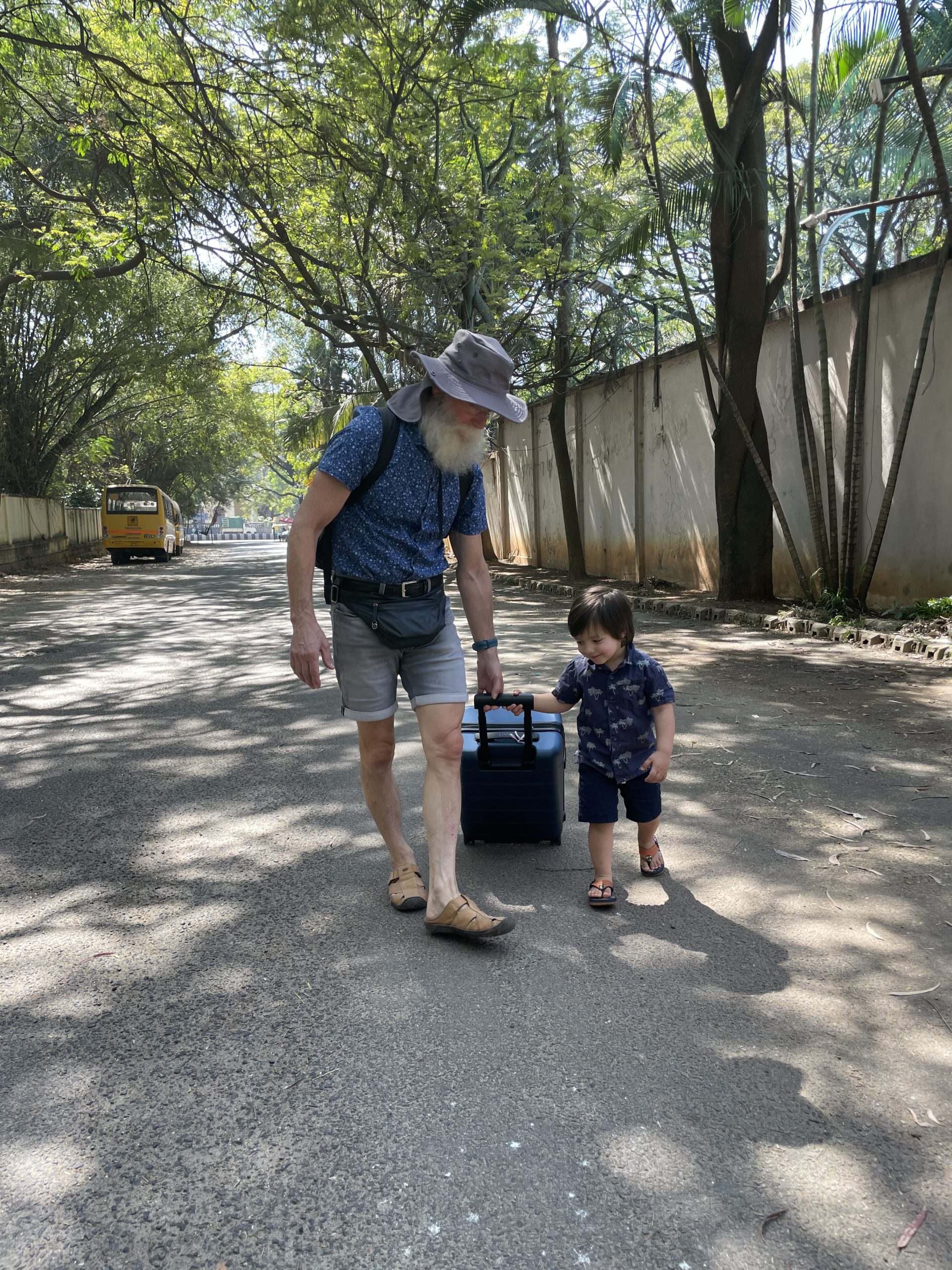
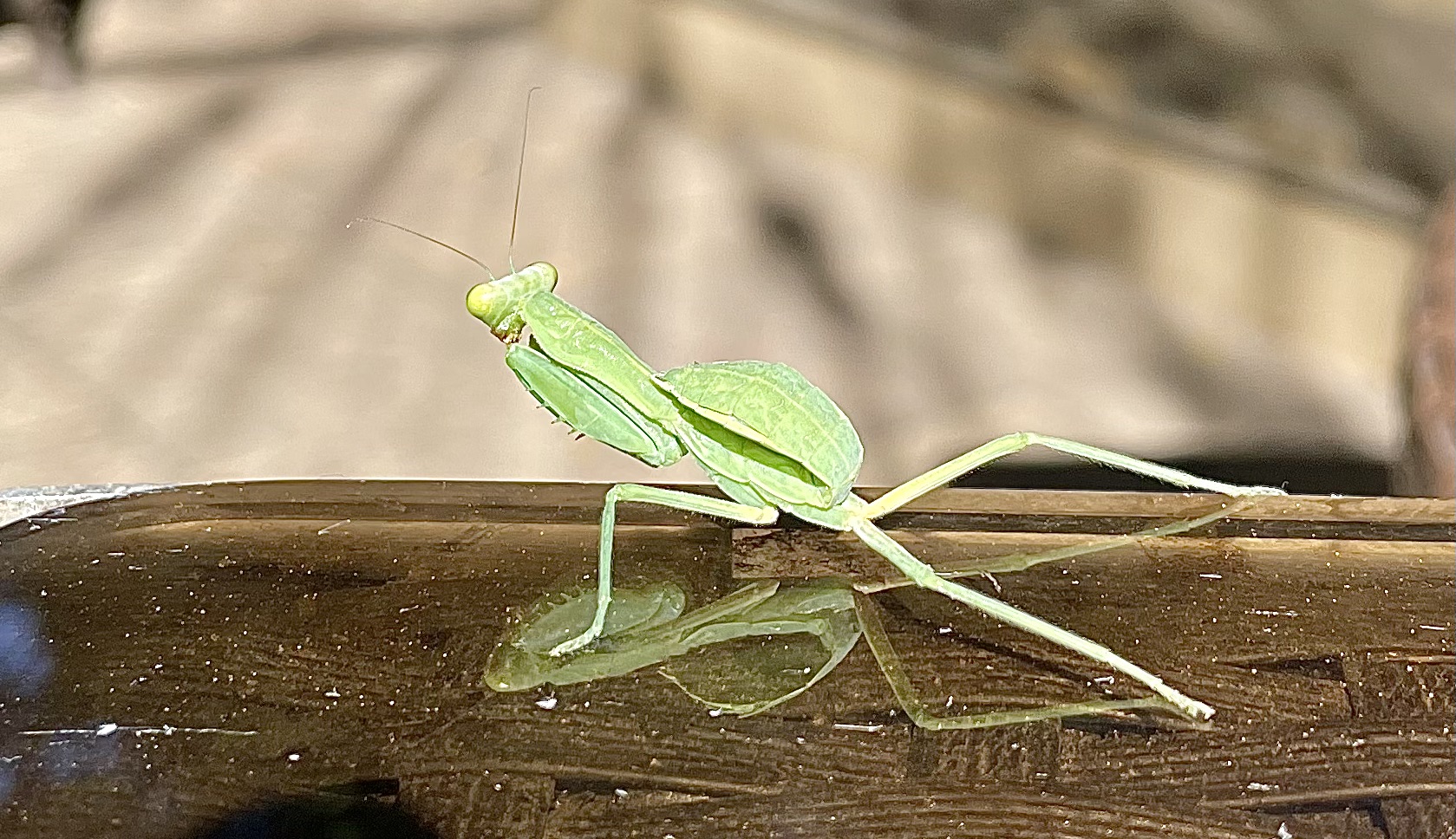
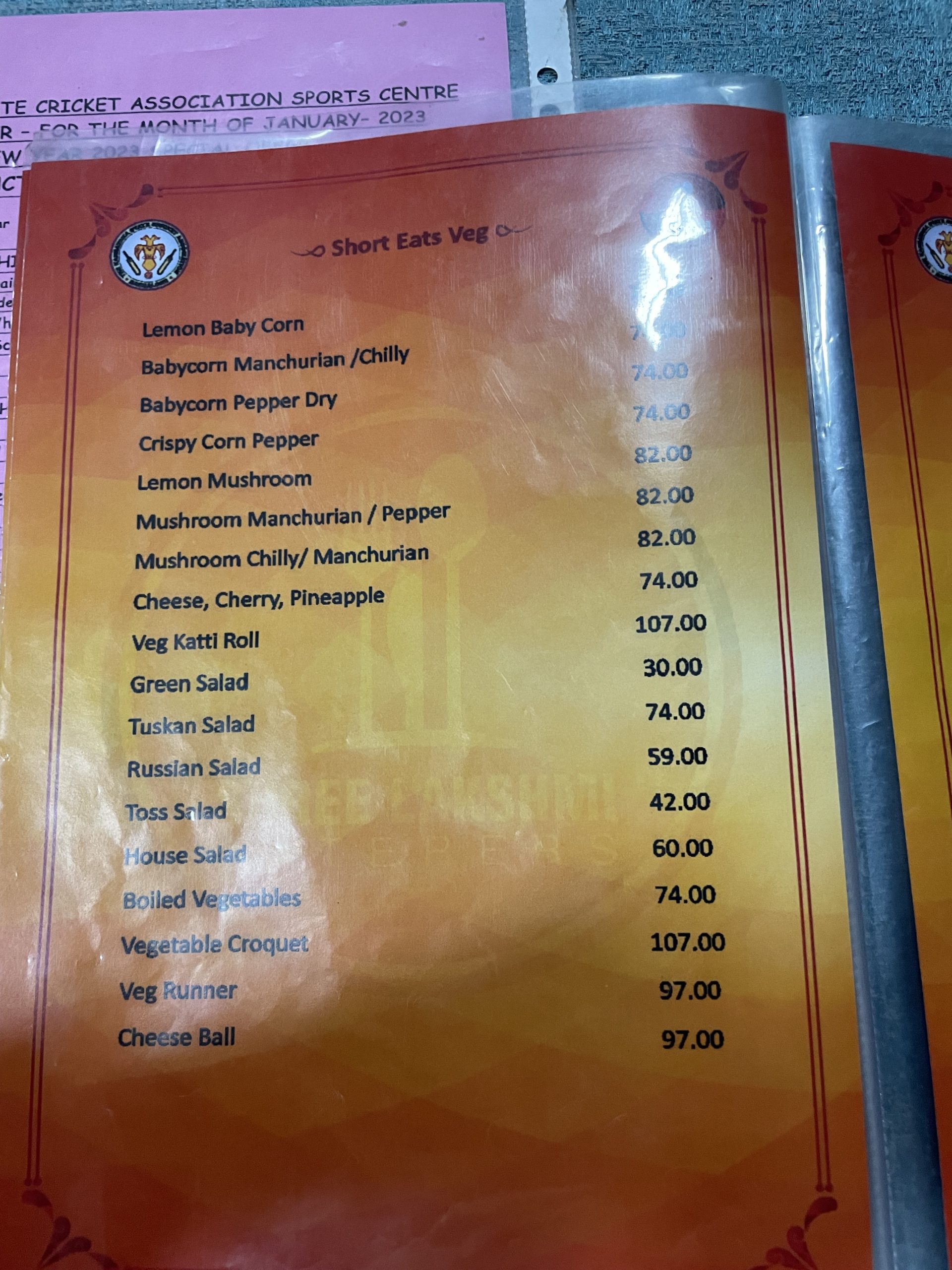
The palace in Bangalore is the royal palace of the Wodeyar family. They have their actual royal palace in the former centre of the Mysore kingdom. The present-day city, where the current descendants of the former kings reside, is also called Mysore. The most beautiful part of their residence or palace is open to tourists and is one of the largest, if not the largest, tourist attraction in Karnataka. The royal palace in Bangalore apparently served more as a kind of summer residence. Bangalore is located at an elevation of over 900 meters, so the months from March to May, when the heat is most intense, are slightly less hot than in Mysore. According to online data, the average temperature difference is only about one degree Celsius, but the difference in elevation is almost 200 meters. The royal family purchased the estate from the headmaster of the local school, and in the last quarter of the 19th century, they built the palace, which was later renovated to its present form. The builders took inspiration from none other than Windsor, the palace of the English kings. Although the Mysore kings or maharajas were subordinate to the English crown, they apparently did not lag behind the royal families of European countries in terms of wealth. Therefore, in one way or another, they had to show off their wealth and power. The best way to do that is to build a palace that is visible to everyone and clearly demonstrates with its beauty and richness that the owner is not just anyone but a powerful individual who, in addition to money, also appreciates art and beauty.
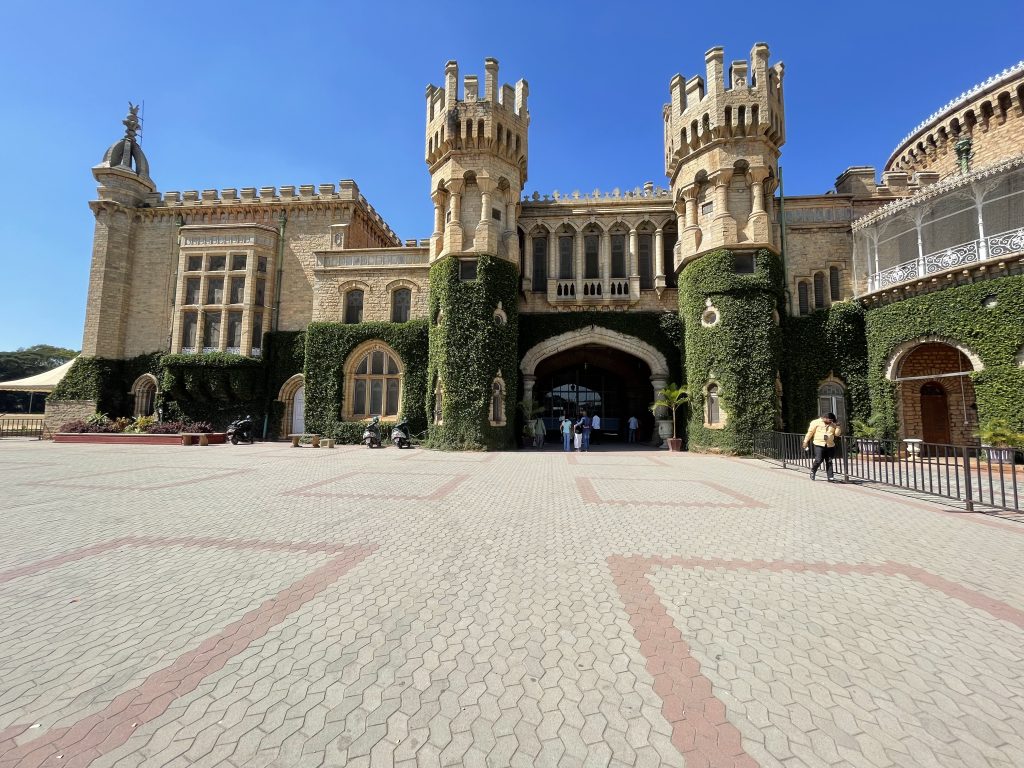
To visit the palace, you put on headphones and, if you feel like it, you can listen to a recorded explanation for each room that is open to the public. The palace also has a covered event space for weddings and public events. Apparently, even the Rolling Stones and many other world-famous music groups and performers have performed here. The palace is surrounded by extensive grounds, so it stands alone despite being in the middle of the city. Part of these grounds is dedicated to an amusement park with attractions designed for children, adults, or the whole family to enjoy. Sky tried out almost everything intended for children and clearly enjoyed himself. Even the adults didn’t suffer too much. Julija and Maša also went on a proper carousel and a big mixer that spins you in all directions. Sky and I observed from a safe distance, although he also wanted to try them out, but after being told they were only for adults, he wisely decided to wait until he grows up. The wear and tear of time were noticeable on the rides, some more than others. What I found most amusing was watching the bored operators of the amusement rides, who seemed to consider their job the most unnecessary thing in the world. Back to the top!
In addition to the royal family’s palace, there is also Tipu Sultan’s palace in Bangalore. He was the ruler who’s father ousted the Wodeyars from the throne and fought the final battles against the English. They eventually defeated him and reinstated the Wodeyars on the throne, to whom, of course, he had to submit. Tipu Sultan’s palace from where he ruled the kingdom of Mysore is actually Daria Daulat Bagh (literally “Garden of the Sea of Wealth’) and is located in the city of Srirangapatna, near Mysore.
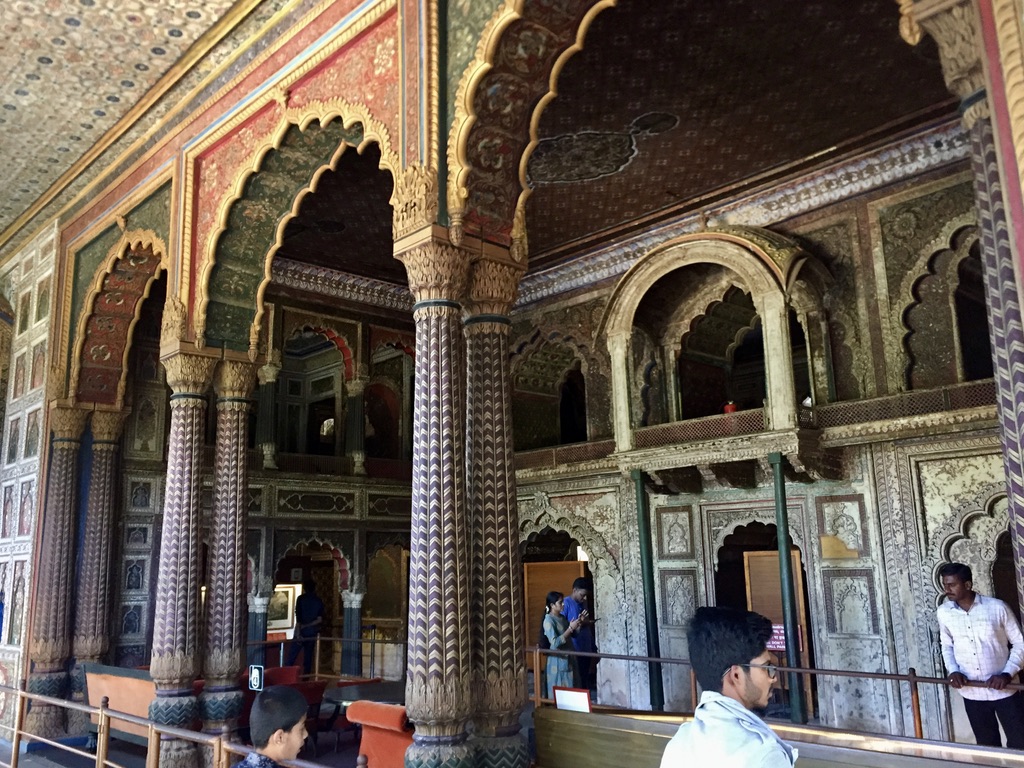
The one in Bangalore is just a summer palace and the afore mentioned that we visited three years ago is much more beautiful and better preserved. The one in Bangalore is relatively small, also made of teak wood, but it was obviously neglected for a long time and is not in the best condition. You don’t need much time for a visit, as there is not much to see, but there is also a garden in front of the palace where you can take a walk, although it is not very big either. Since there is a fort nearby, we also went there, but it wasn’t particularly impressive. The mighty, tall walls that you can walk between are mostly all there is to see. At least you don’t have to pay an entrance fee for that. Back to the top!
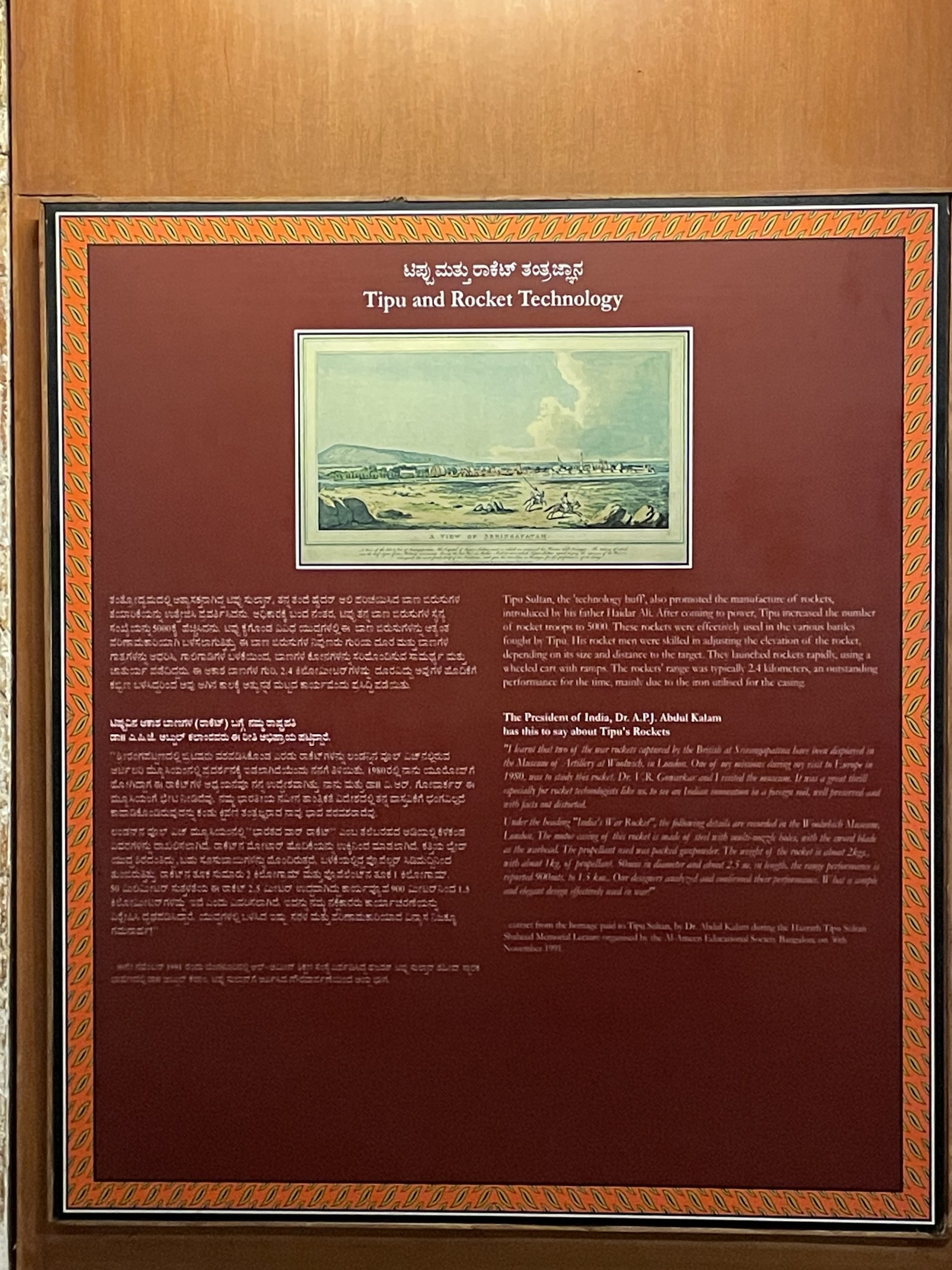
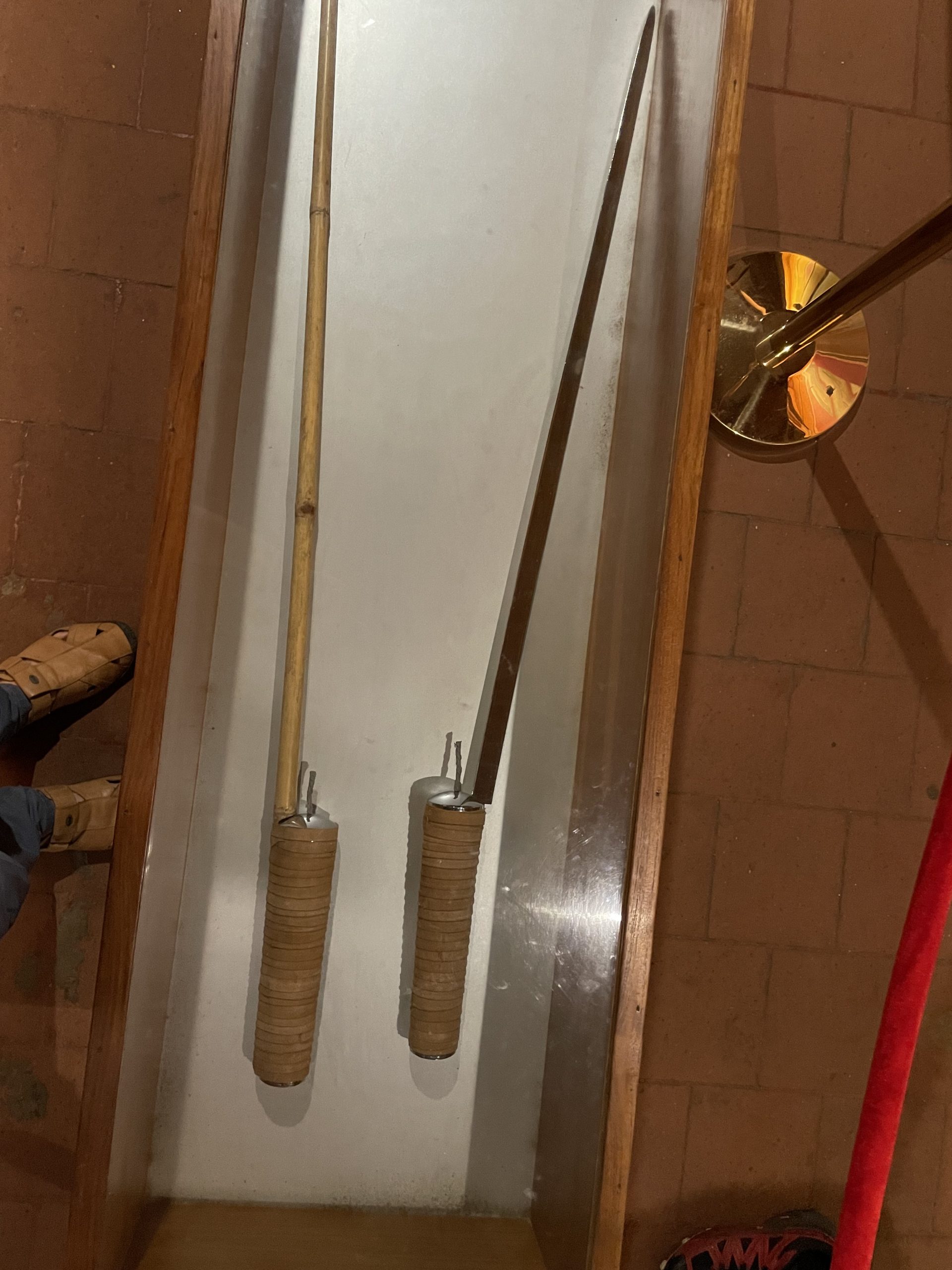
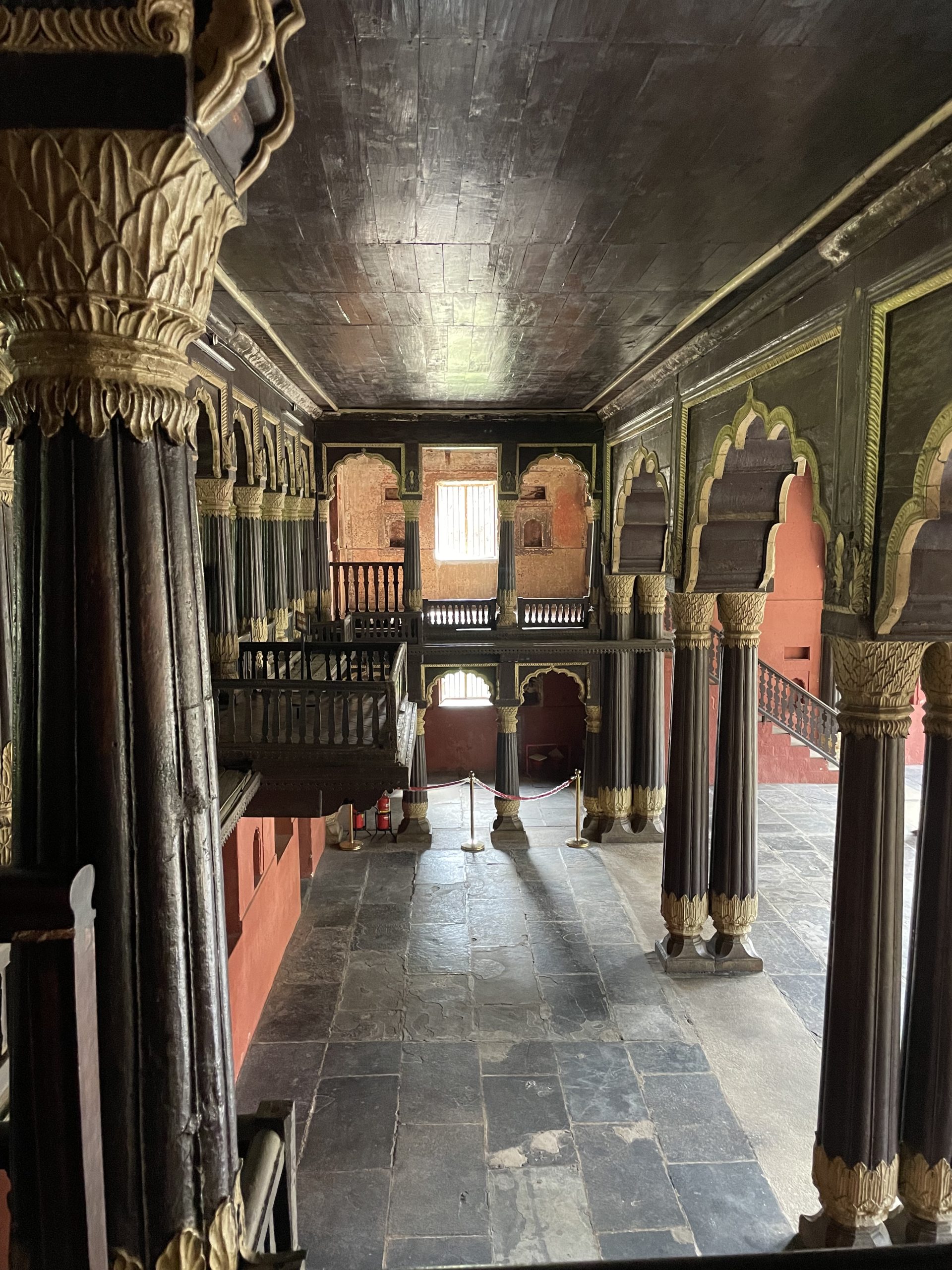
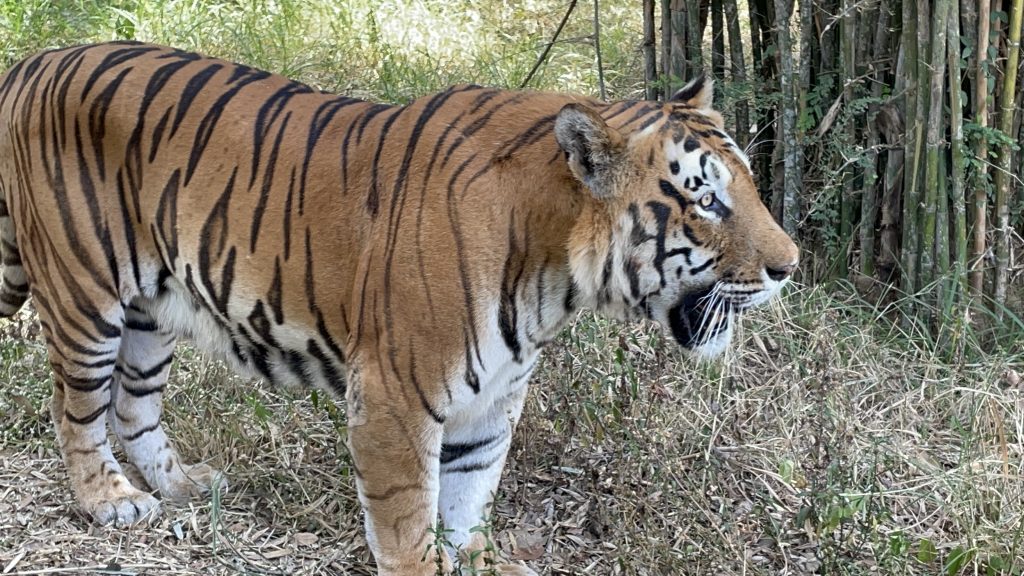
In the Bannerghatta Nature Park, you can also see animals such as giraffes, zebras, crocodiles, various birds, monkeys, hippos, and who knows what else. You can view them in the zoo enclosures after returning from the safari. To save you from walking, you can rent an electric buggy, which is the most suitable way for a two-year-old like the one we had with us to explore. Even so, he was already getting a little tired of everything. However, he particularly liked the crocodiles, who lay almost motionless and paid no attention to anything around them. Sky would just watch them and watch them. It’s worth noting that one of his favorite finger puppets, which accompanied him in India, was a crocodile. Perhaps that’s why he was so fascinated by those lazy and dirty crocodiles. This observation reminds me of Juri Muri in Africa2 and his quiet anger upon encountering a crocodile: “Such a journey and such a goal, only a dirty crocodile!” and the subsequent statement: “Although you’re famous, you’re not clean, you splendid stubborn godfather!” This did not sit well with the crocodile, and it immediately led to Jurij’s misfortune. He, who went to Africa because he didn’t want to wash, was doused with a large amount of water by an elephant as punishment for insulting the crocodile and the clumsiness that followed. The elephants we saw didn’t spray water on themselves or us, even though they were near the water. The crocodiles also had a shallow pool in their enclosure, but they preferred to lie in the dust next to it. However, none of them attempted to climb out. Unlike Juri Muri, Sky respectfully and curiously watched the crocodiles, and it never crossed his mind to offend them with any thoughtless remarks. Therefore, they had no real reason to be angry with him, let alone try to teach him manners.
2 Juri Muri in Africa is a children’s poem about a boy who didn’t want to wash and therefore went to Africa because he thought people there don’t wash. While wandering on an elephant, he reached the Nile River, where a crocodile was swimming in muddy water. Upon seeing it, Juri Muri was somewhat disappointed and straightforwardly told the crocodile that it wasn’t clean! The crocodile, being accused of dirtiness by a dirty boy on an elephant, became extremely angry. It lunged out of the water, causing Juri Muri to fall off the elephant and damaged his tusk. This also angered the elephant, who punished Juri by spraying him with water. It was the ultimate punishment for him, who despised water so much that he refused to wash with it.
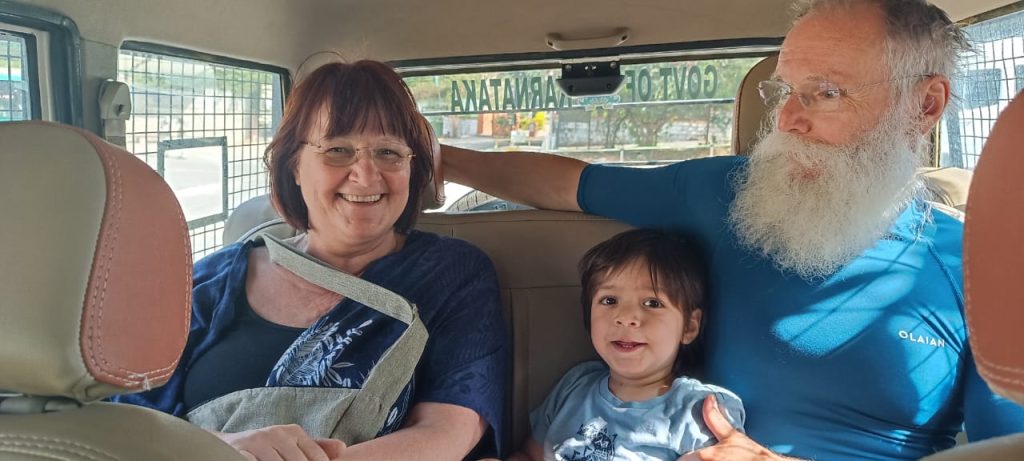
Wayanad and a real safari trip
Julija and I spent the first month of our India trip in the capital city of the state of Karnataka, known to everyone as Bangalore, but officially named Bengaluru. For our first journey out of this metropolis, we embarked on a five-day excursion planned and organized by Bharat and Maša, who, for some unknown reason, referred to it as a honeymoon trip. Perhaps because the first place where we had a two-night stay is popular among newly-weds. We had a hired taxi driver at our disposal for five days, available for transportation anytime and anywhere, as long as it was within a daily limit of less than 300 km. We could have gone further, but additional charges would apply. However, we didn’t have such a need, especially because covering a 300-kilometer distance in India requires a considerable amount of time. On the first day of our “honeymoon” trip, we had to reach the romantic holiday resort of Mountain Shadows in the Wayanad district. Initially, I thought that was our destination, but it turned out that the area was larger than a tenth of Slovenia. To add some cultural and natural value to our trip, I searched the internet during the drive to find out what else is worth seeing in Wayanad and how far it is from the holiday resort where we were going to spend the night, to the shore of the Arabian Sea. If it would turned out to be close enough, we could have taken a short trip to the coastal towns. We hadn’t been to that sea yet. I quickly realized that the distances between the various attractions were quite long. We had to choose the ones that were closest to the route to our evening destination. To visit more interesting nearby points along the Arabian Sea coast, we would have had to allocate a significant portion of the next day to driving. However, based on my calculations, it seemed possible to catch the sunset on the way back from the road that leads through the Western Ghats to the Deccan Plateau. We still had time to decide whether to go to the sea or not, but we had to make quick decisions about the stops along the way to the holiday resort to avoid backtracking and wasting time. I chose two recommended attractions that didn’t significantly lengthen our journey and were listed as truly worth seeing in Wayanad. First, we made a detour to visit the cave “carvings” in Edakkal Caves. The oldest carvings were allegedly made in the Stone Age around 8,000 years ago, while the youngest, dating back three millennia, indicated that the people who sought shelter in these caves had connections with the famous civilization of the Indus Valley.
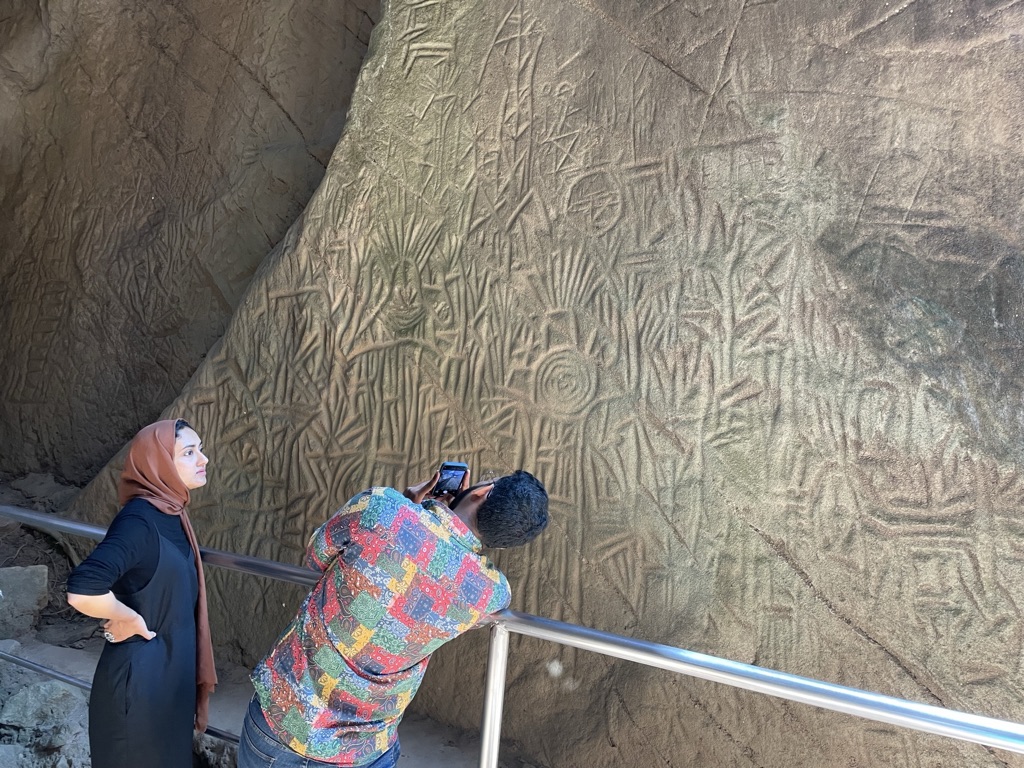
Actually, the “caves” are not caves at all, but rather spaces covered with a massive broken rock block. They are located at an altitude of around 1,130 meters and are evidently well-known attractions in Wayanad. We realized this when we reached the wooden building where tickets are sold. It was located at the entrance of a steep path that leads to the caves. There, a large crowd of people was gathered. Fortunately, not everyone was waiting in line for tickets, as some already had them but were not yet allowed on the path since it was already filled with those who entered ahead of the waiting crowd. To make matters worse, the ticket sellers took a little break, and we had to wait for the ticket sales to resume. While waiting, two women went from person to person, and anyone who had a plastic bottle had to pay a deposit, and a sticker was placed on the bottle. If the person returned with the bottle and sticker, they would receive a refund of the deposit. Such a form of discipline that hits people’s pockets seems to be effective, as there were hardly any discarded bottles on the path to the caves, unlike in other places where you find them at every step.
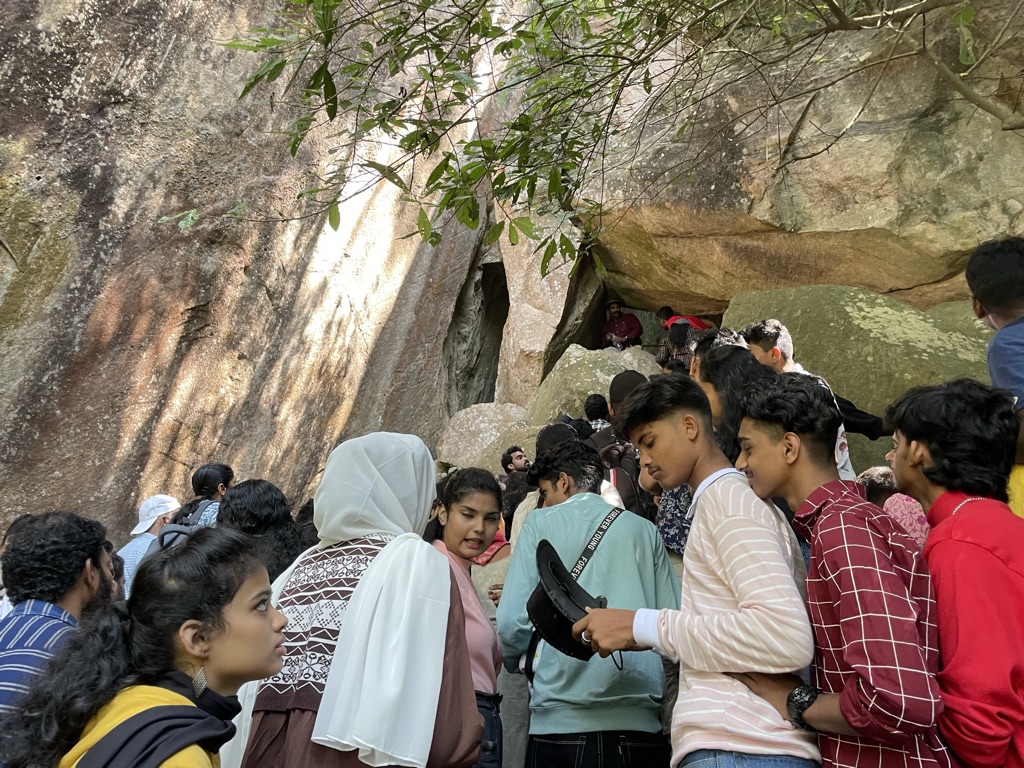
From the entrance, the path ascends steeply into the cave, and in the first part, you also encounter those coming down, but not in the second part because the path goes in a circular route. The higher we went, the more crowded it became, as access to the cave was a bottleneck. We had to squeeze through a narrow opening between rocks, almost climbing to reach it because it was so steep. There was already a crowd of people eager to see it, and they almost carried you away. Some, especially young men wearing completely inappropriate footwear, were looking for shortcuts and climbed up the steep rocky slopes like wild goats to reach the entrance. This time, everyone made it safely, and no one slipped. While a fall wouldn’t have resulted in plunging into a precipice, it definitely wouldn’t have ended without scratches. It’s possible that a limb could have been broken as well. But what can you do? Even in India, youth is foolishness, they jump on rocks where the path is worn because there are too many people on the path and they don’t move. For us, who are not accustomed to crowds, our Indian companions took care of us and kindly pushed us up the high rock steps towards the cave entrance. Otherwise, we would have remained outside until the visitors ran out. While it is said that the English will line up if there are two people waiting somewhere, in India it is completely different. It rarely happens that there are only two people somewhere. And to imagine standing in line and moving one after another like in “Our Troop Marches On…” is beyond me. Pushing and shoving is more of a rule than an exception if you want to get anywhere. If you’re not used to it, you won’t get anywhere, neither on the streets of the city nor on the paths that lead to attractions like the Edakkal Caves, for example.

When we finally entered a large and relatively bright area covered with a rocky block, the crowd somehow dispersed in all directions, each person marking their climbing achievement in their own way and taking selfies of various kinds, some even with the Paleolithic drawings or inscriptions carved into the rock. We then took more photos from scenic viewpoints before embarking on a steep descent and, as I mentioned, circling around on the other side from where we ascended. To reach the parking lot where our taxi driver was waiting for us, we had to descend about two hundred meters in altitude together, and most importantly, pass by all those shops where the sellers hoped to entice some of the passing visitors with their merchandise. Of course, there were also small local establishments along the way where you could have something to drink or eat. However, being characteristically frugal as a person from Gorenjska (Julija is actually from Štajerska, but she has been living with us in Gorenjska for so long that she also occasionally has bouts of frugality), we didn’t succumb to the temptations of food, wooden products, or local produce, and quickly continued on our way, as according to my plans, we still had to visit a nearby lake before evening. The lake was located close to the route to our holiday resort, where a warm bed awaited us in the evening. Back to the top!
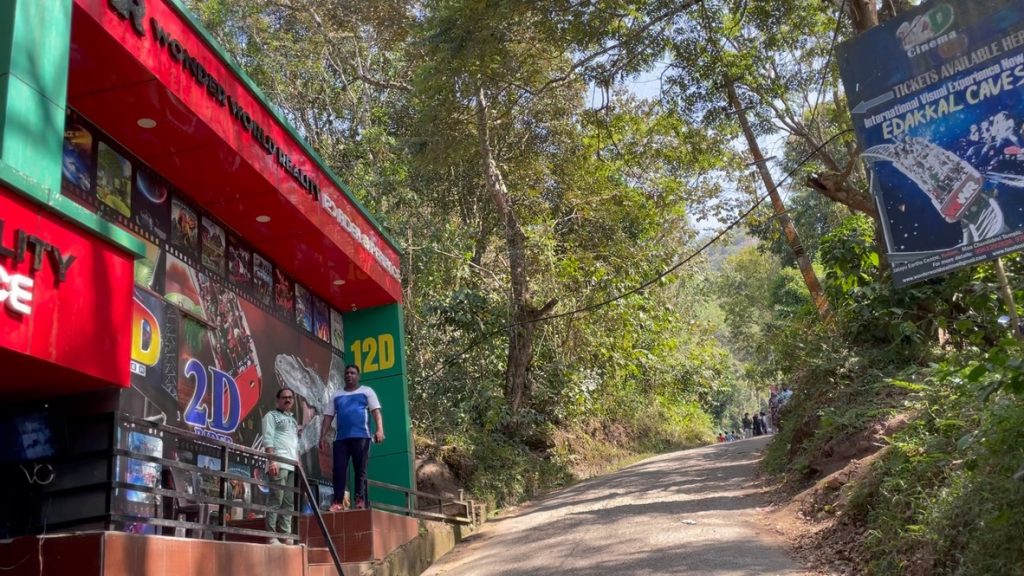
Slightly off the path, but not too far, lies Pookode Lake. I didn’t have time to check out why it’s worth visiting, so we decided to “let ourselves be surprised!”. The fact that there was a crowd at the ticket window was no longer a surprise. That they charge an entrance fee for a lake that is a little larger than our ponds, neither. Even less so that there were more visitors than walkers around the entire Lake Bled at the peak of the season. But now we knew that they were having a religious celebration, which was the reason for the crowds of hikers everywhere where it says on the internet that there is something worth seeing. The lake, around which you can walk in half an hour, is really nothing special. For us, who have plenty of such waters. For Indians in the state of Kerala, where this lake lies, it is the highest lying natural lake, surrounded by forested hills. It is said that there is also a fish in the lake that is not found anywhere else, but I didn’t know about that during the walk along the shore, and it was not possible to see it either. Otherwise, a fence has been built around the lake, a shop has been built at the entrance, there is a children’s playground with a few rides between the entrance and the lake, and a boat rental on the shore, and there were more visitors on the boats than there were walkers around the lake. They came to this, for them idyllic, place to enjoy the fresh air and enjoy nature. A Muslim mother with a little girl who was about six or seven years old approached Julia. After a short introduction, in other words finding out who is from where and similar, she of course expressed her desire to take a picture together. It is interesting that women wanted to take pictures with her, while men mainly asked me to do so, because they found me “fit” for my age, presumably judging my age based on the greyness and length of my beard. I found it quite amusing when one of the young men on the way to the Edakkal Caves explained to me that he wanted to take a photo with me because of my “six-pack.” Another person who took a photo with Maša, Julija, Sky, and me in Lalbagh said it was because we were so white and looked like dolls to him. I’m not sure what he meant by that, but I assume he was expressing his admiration. In India, the idealization of fair skin is still evidently present. The fairer, the more beautiful, or at least more exotic. However, I could be mistaken, and it may have just seemed that way to me because that’s how I perceived it. Back to the top!
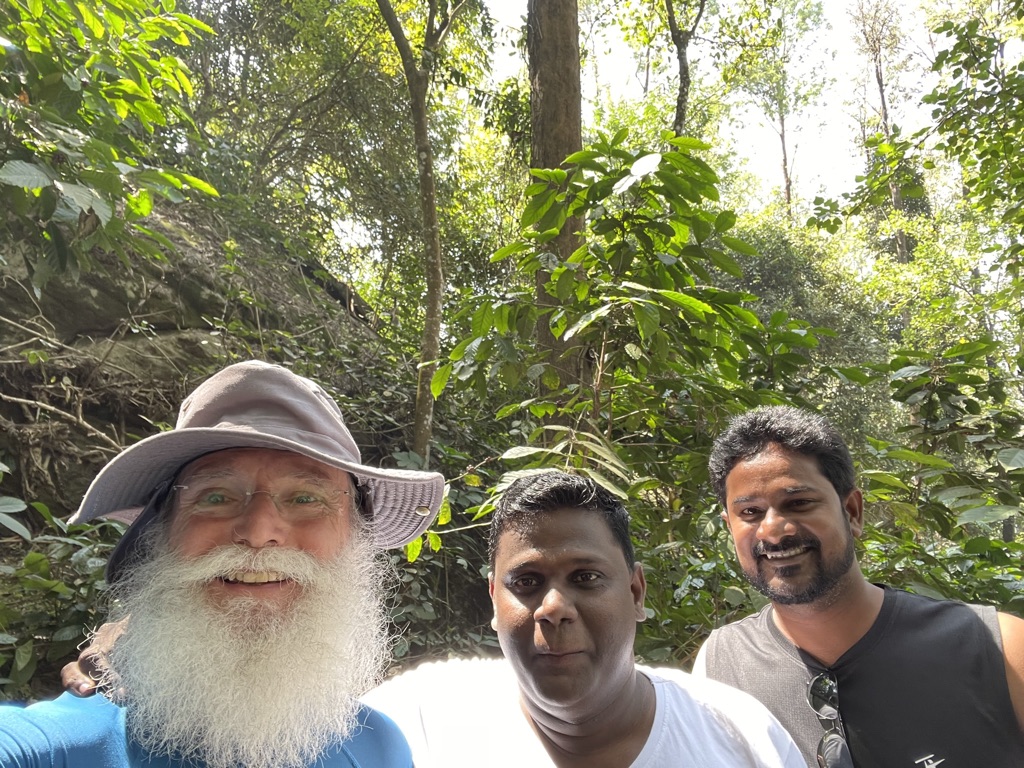
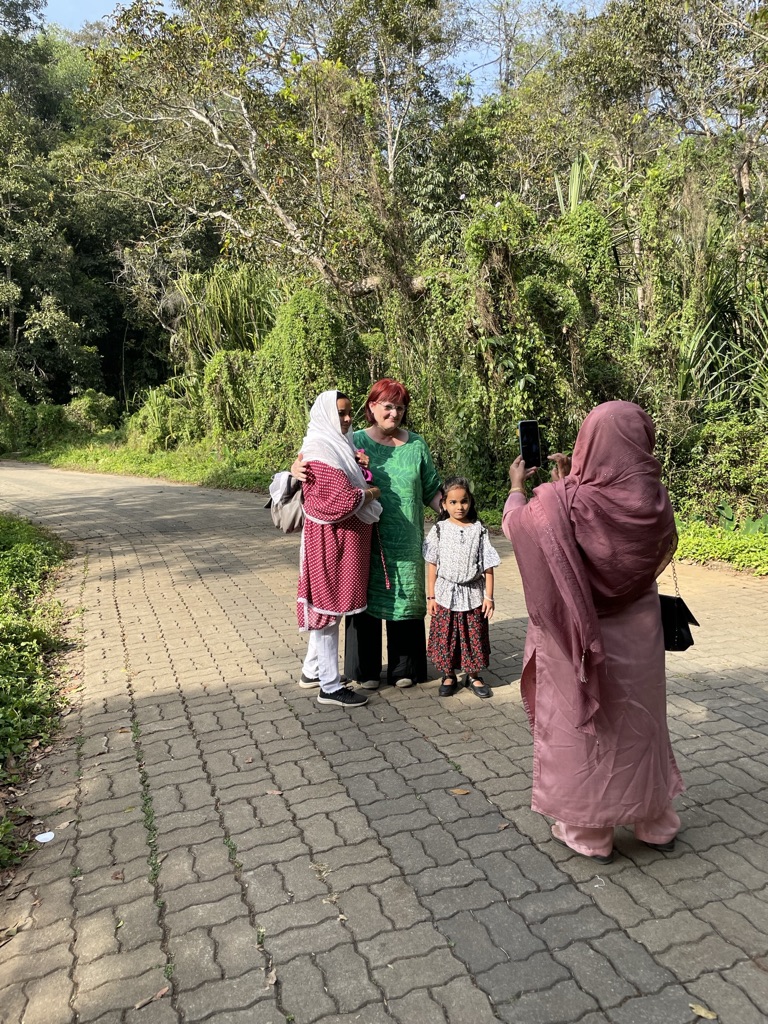
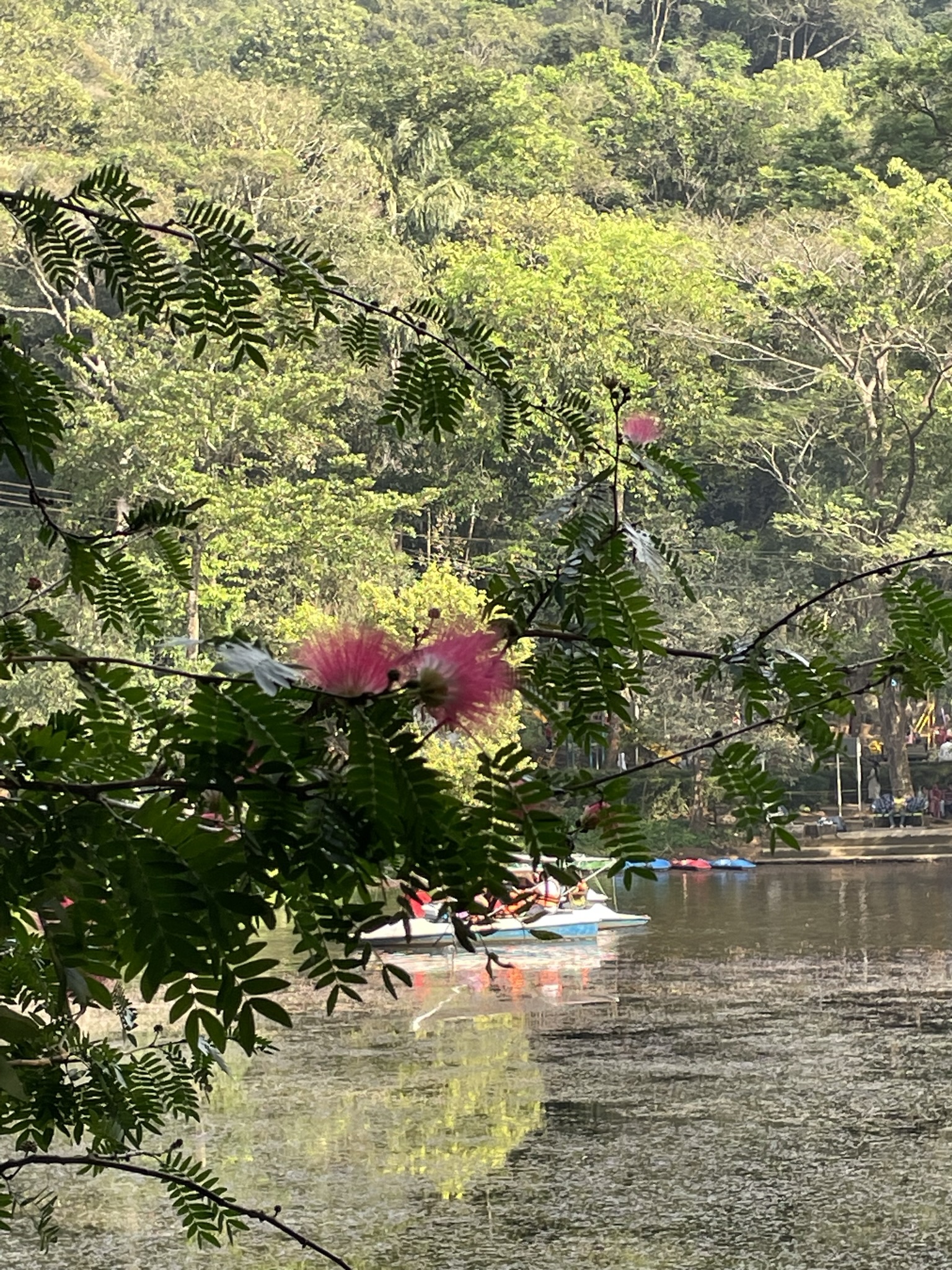
From the lake to the holiday resort, there was a little over 30 kilometres to cover, but according to Google, it would take over an hour to drive. The reason became apparent in the last three kilometres, where the rocky road was so bad that a regular car couldn’t go faster than about 10 kilometres per hour. We all trembled in the taxi, fearing that some vital part of the chassis would hit the rocky ground at any moment. During this arduous final stretch, I firmly crossed out all plans for a trip to the Arabian Sea because I didn’t want to burden our taxi driver with two more rides on this rough road. Thus, we were condemned to two days of idling in the Mountain Shadows holiday resort. Only those mountains around us were not excessively high. They reached heights similar to our Blegoš, which we consider a hill rather than a mountain. Therefore, the time when the shadows of these mountains stretched across the holiday resort was not very long. The peaks of these mountains were not close enough to cast their shadow over the wooden cottages in the resort by mid-afternoon. These places are too close to the equator for such occurrences, and the sun sets much more vertically than it does in our region. Additionally, the difference in day length between winter and summer is much smaller.
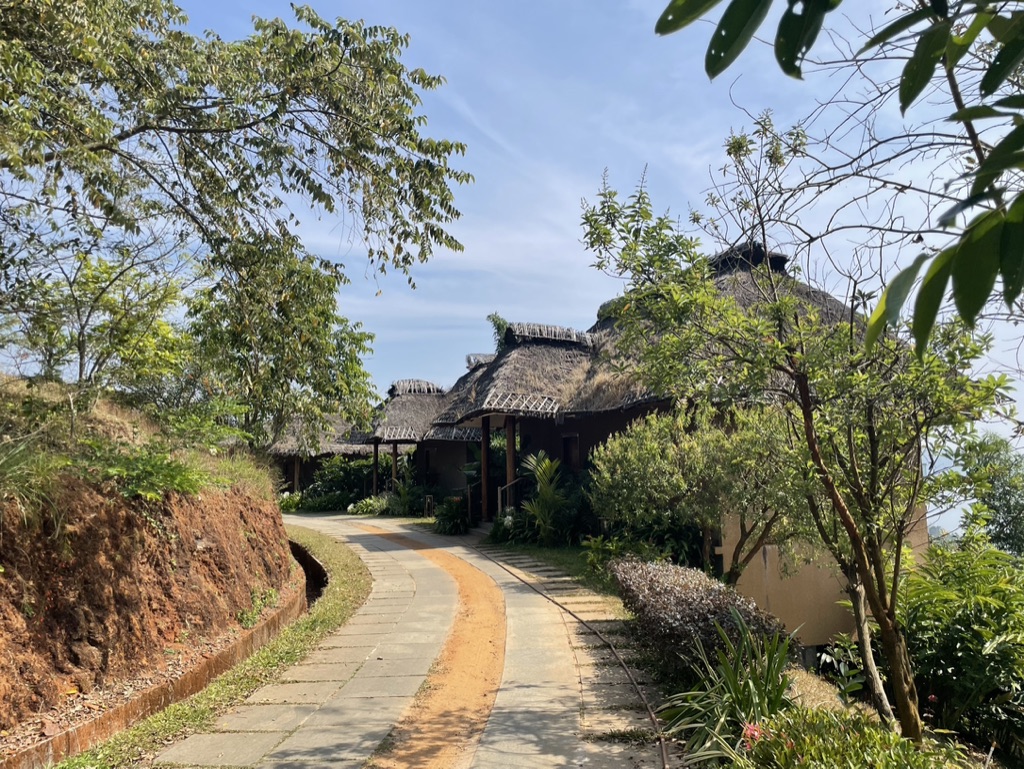
The holiday resort is situated on the slopes of a hill, surrounded on three sides by the artificial reservoir of Banasura Sagar. The water level of the lake undergoes significant changes throughout the year. During the southwest monsoon season, which brings the highest rainfall to the region between June and September, the water level reaches its peak. However, over the next eight months, it gradually recedes as the amount of rainfall decreases month by month. From December to March, there is hardly any significant rainfall at all. The fluctuation in water level results in barren, muddy banks since the trees and shrubs in the occasionally flooded zone quickly deteriorate. The banks are also quite steep because after the construction of the dam, the water flooded the valleys that were surrounded by hills with steep slopes. And on one of these hills is the Mountain Shadows holiday resort.
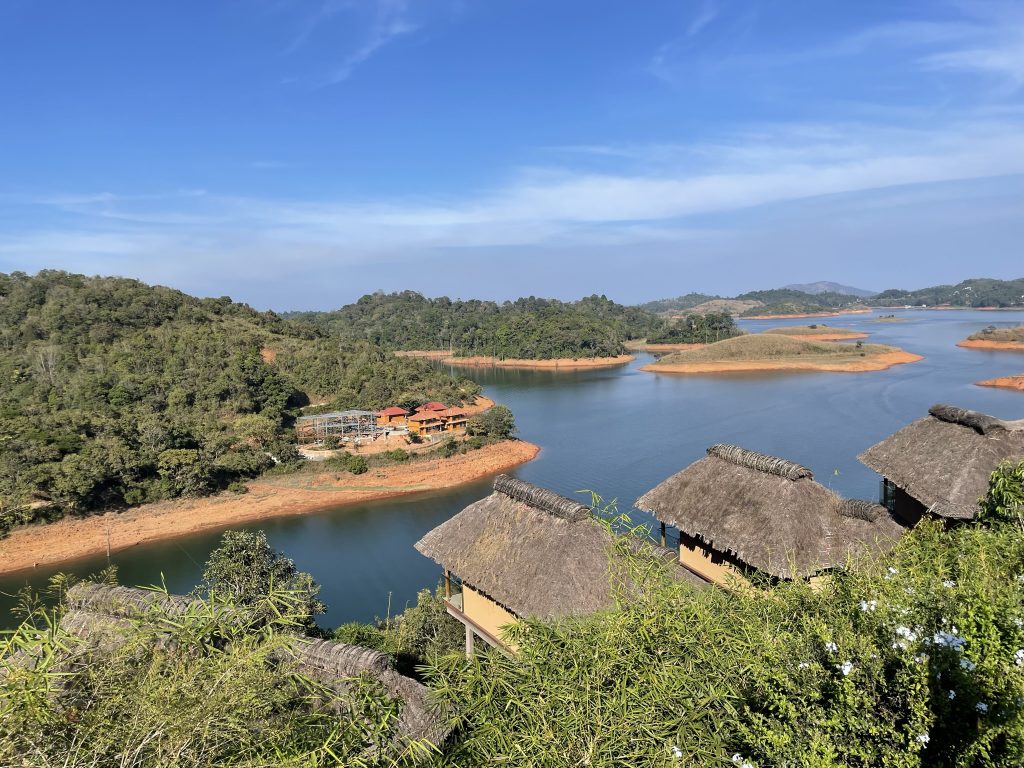
The hill between the two flooded valleys is the lowest and narrowest at the entrance to the resort. It looks as if you’re crossing a natural bridge to reach the island. One would expect a reception at the entrance, but there is only a kind of guardhouse. Of course, the holiday resort is a kind of gated community where only “invited and chosen” guests can enter. There is also a parking lot at the entrance where guests leave their cars. However, our taxi couldn’t park there because there are no budget accommodations in the resort, so our driver had to go back on the rocky road to the nearest suitable bed and breakfast. He waited there the whole next day, hoping we wouldn’t need him. Instead, an electric buggy, one of those open electric vehicles with small wheels, four seats, and a flat roof attached to some poles, arrived to pick us up. It was more for sun protection than rain, at least in the dry month of January, it seemed that way to us. These vehicles are meant for transporting guests and their luggage within the resort.
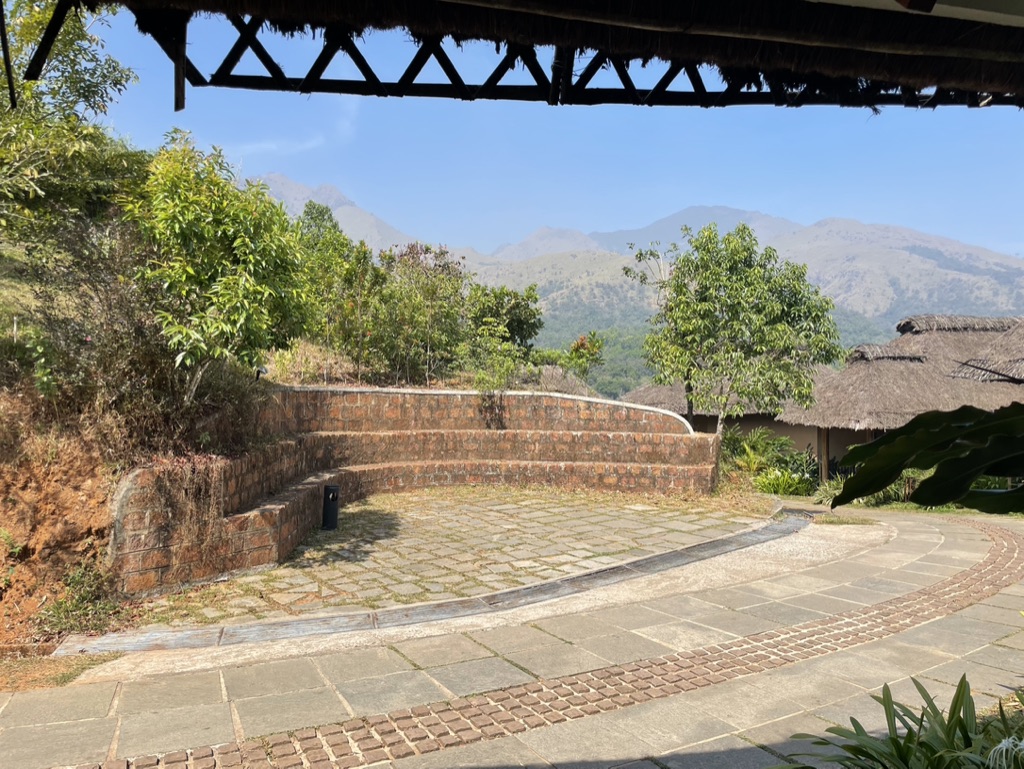
The resort consists of charming wooden cottages with thatched roofs, arranged along paved pathways. These pathways ascend around and upwards along the slopes of the hill. Right at the top of the hill is the reception, underneath which is the restaurant. A bit further, on the edge of the plateau at the hilltop, the pool reigns with a stunning view of the lake. From a distance, the lake looks absolutely idyllic, not just during high water levels when it extends all the way to the lush green forests covering the hills surrounding the lake, including those where only the peaks emerge from the water, forming islands. As the water level decreases, a vegetation-free strip is revealed, adding to the beauty of the lake with its red-brown colour, contrasting with the green islands and shores. From a distance, the lake presents an exceptionally attractive image. And that is precisely what they sell as hot tourist commodities in this holiday resort. Since you cannot swim in the lake, there is a pool with a view of the lake. You can even choose a cottage with its own private pool, offering a beautiful view of the lake. The view of the lake is also the main attraction from each cottage. It is so important that one entire side of the cottage facing the lake consists of nothing but a window, with a terrace in front of it, allowing you to enjoy the view of the lake. You can admire it as the morning mist rolls over it or as it bathes in the evening sun. The view of the lake greets you as soon as you enter the cottage. And so that you can enjoy this unique view even when attending to certain physiological needs, the bathroom with a toilet features a large window that opens up the view across the bedroom and through the full-length window, across the terrace, to nothing but the lake. The cottages are positioned on steep slopes, with the entrance accessible from the upper side of the paved paths. The entire living space is at the level of the pathways, so underneath the terrace, which is supported by pillars and located on the opposite side of the entrance, there is already at least one additional floor of space. This space was entirely unused in the cottage where we stayed. However, considering that the main attraction is the view of the lake, it cannot be utilized as the lush vegetation covering the slopes beneath the cottages obstructs the view of the lake from down there.
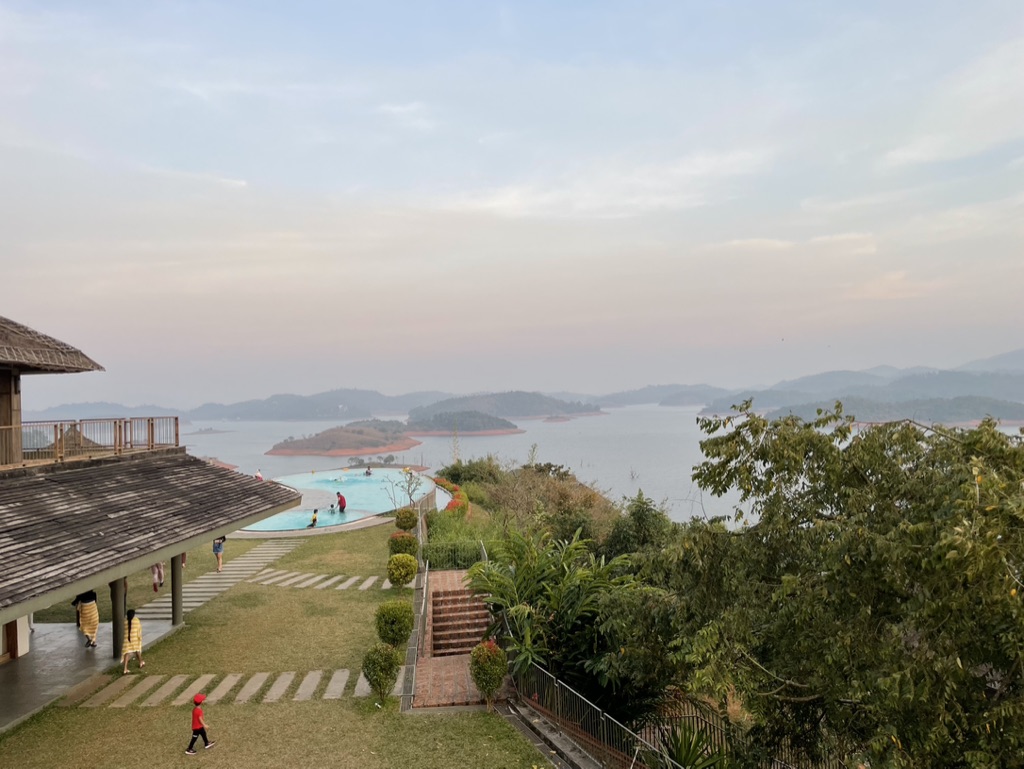
Because one cannot solely live off enjoying the view of the lake, the resort also has a restaurant. It left an impression on me for at least two reasons. The first was the overly loud music during dinner. They had live singers accompanied by pre-recorded music. The music varied, with the singers performing traditional South Indian songs, contemporary Bollywood hits, and Western favourites. However, it was too loud. So loud, in fact, that I had to ask the waiter to repeat himself every time he spoke to me. The same applied to the head chef, whom the waiter sent to my table to coordinate my vegan menu. I already had difficulty understanding him, and the loud music made me miss whatever I might have understood. However, this had no significant impact on my dining experience because without exception, the food they prepared for me was delicious, and that’s the other thing that stood out in my memory. Perhaps I should also mention the friendliness of the staff and their duty to engage in small talk with the guests, inquiring about their well-being and whether they had everything they needed, if everything was as it should be. However, I couldn’t bring myself to mention the excessively loud music to the staff. I felt that amidst all their kindness, I would come across as a spoiled complainer.
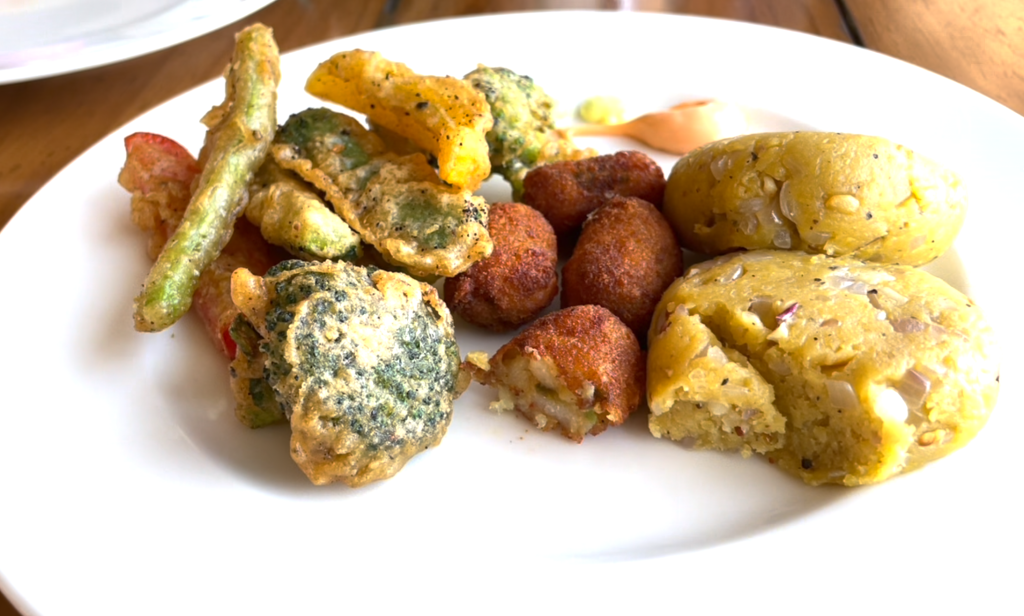
When you’re full and content, you start thinking about what you could do here. Above the reception, they had a space with games for children, a table for table tennis, table football, billiards, and similar activities. But we were more drawn to the pool. You can get everything you need from the pool attendant, who takes care of order and cleanliness and caters to the pool users. Sun loungers and towels await you, and since the water was pleasantly fresh in the morning, perfect for swimming, we even had the privilege of having the entire pool to ourselves. The previous evening when we arrived, the pool was full of children dressed in swimsuits that covered much more than what we, Westerners, typically wear when swimming.
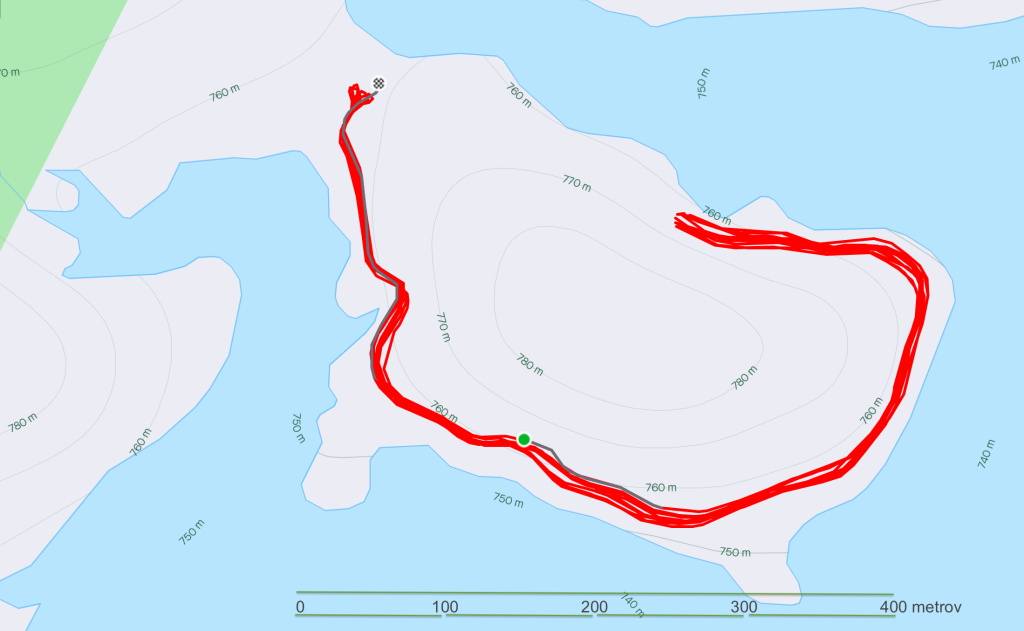
While contemplating what else there was to do, I remembered that they mentioned at the reception that it was possible to rent a bike. I was already counting the kilometres to the dam in my mind and thought that on the empty stone road, I wouldn’t be in great danger with a mountain bike since the cars moved at a pedestrian’s pace. There wasn’t much traffic on the roads leading to that stone road the previous day either. I checked if it was possible to rent a helmet as well, and since the answer was affirmative, I headed towards the entrance of the resort where they supposedly rented bikes. However, the bikes were scattered around the parking lot. When I asked the attendant who was watching over the parked cars and bikes where I could arrange to rent a bike, he told me to just take whichever one I wanted. When I asked him about the helmet, he gave me a strange look as if he had never heard that a helmet is used when riding a bike. It quickly became clear that my plan to embark on a 10- or 15-kilometer ride to the dam or maybe to the motorboat port went down the drain, or rather, into the lake. We both realized that I could only ride within the resort and not even on the pathways leading to the cottages, but only along the lake shore, and even that didn’t complete a full circle because after about 800 meters, the path along the fenced steep shore ended, and you had to turn around and ride back to the parking lot. The view of the lake was mostly obstructed by vegetation along the way, except for a small viewpoint that was set up in one spot. Along the path, I noticed a small soccer field and half of a basketball court. The path didn’t ascend or descend. You either rode or walked a few meters above the lake’s surface, and most of the path was flanked by steep overgrown slopes on both sides. That reddish-brown desolate muddy strip above the lake’s surface couldn’t be seen from the path. Or maybe it was only invisible to those of us who feel the need to ride as fast as we possibly can.

I had the opportunity to choose a bike that would suit me best. However, among all of them, there wasn’t a single one that was even remotely similar to mine. They were all in much worse condition than my bike just before it urgently needed the attention of Master Ivo for a “major” service. So, I sat on one of the bikes that seemed to fit me the best and rode back and forth five times. As it turned out later, despite everything, that was my longest bike ride in India. And if I was already convinced that it was impossible to find a worse bike, it became apparent just over ten days later that it was indeed possible. Back to the top!
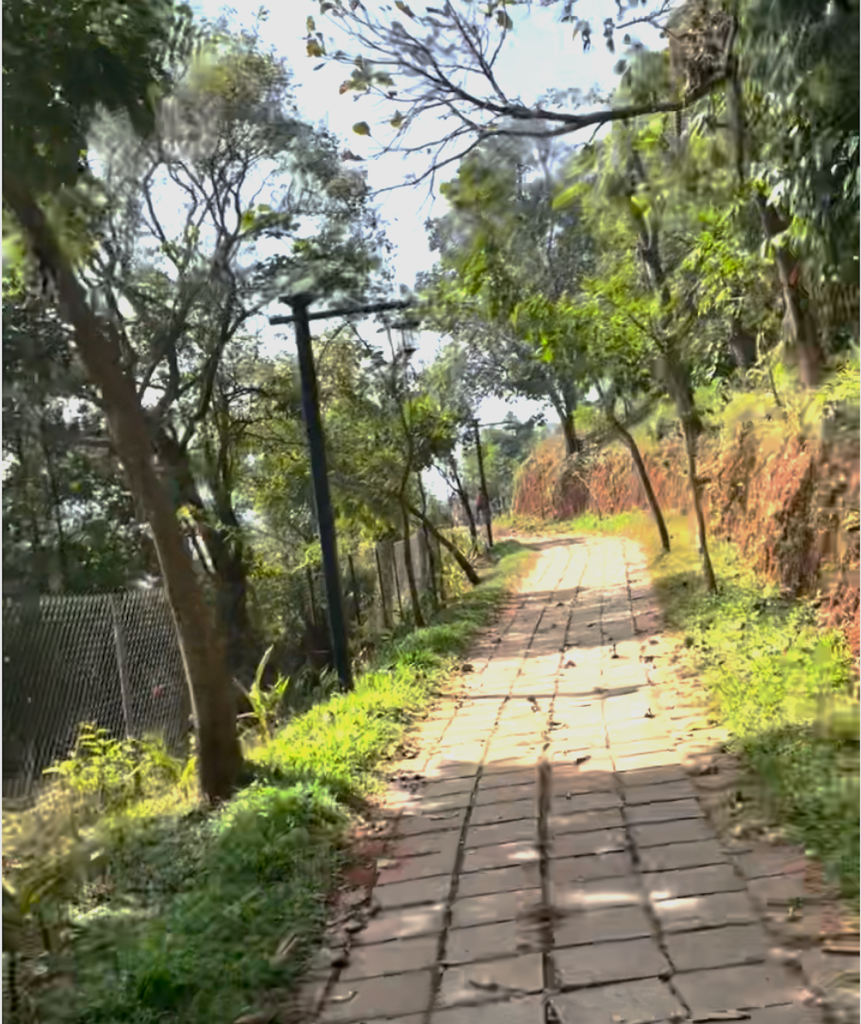
Mountain Shadows was our home for only two nights, which means we spent just one full day there. Considering that it offered practically nothing in terms of real action, that was enough. We enjoyed the views of the lake, swimming in the pool, dining at the restaurant, and the comfort of the cottage where we stayed before moving on. Actually, backtracking, because our second destination was closer to our temporary Indian home than the first. Wayanad is located in the state of Kerala, and Kabini River Lodge, where we had reserved our second set of accommodations, is on the other side of the border in the state of Karnataka. The Kabini River flows into Karnataka from Wayanad. There is a dam on the river, creating a large reservoir behind it. Along the reservoir is the Nagarhole National Park, and if you don’t know what to do at Mountain Shadows, the days you spend at Kabini River Lodge are filled with activities. The main one is safari. The first afternoon safari takes place right after you settle in and have lunch. It’s a classic safari in large Indian off-road vehicles that transport you through the forest trails of the national park, where, if you’re lucky, you can spot the local wildlife. The following morning, you can choose between a water safari or another vehicle safari, with the option of another morning safari if you so decide. We opted for the vehicle safaris because we had already taken a boat ride on the lake during lunchtime and the afternoon safari.
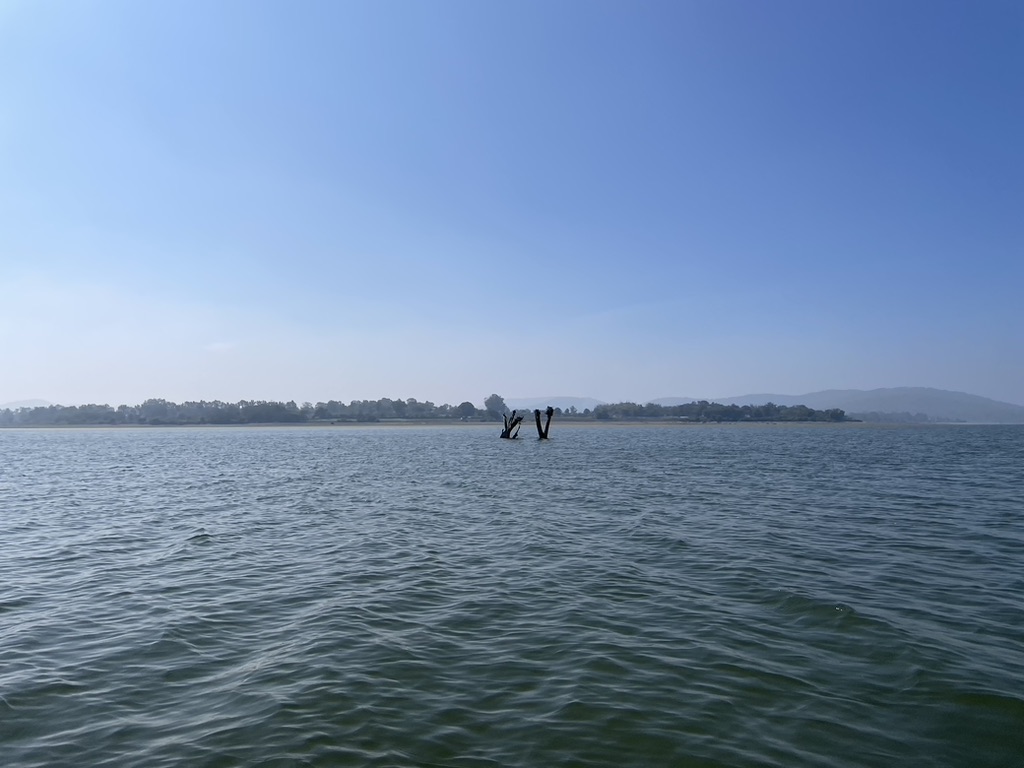
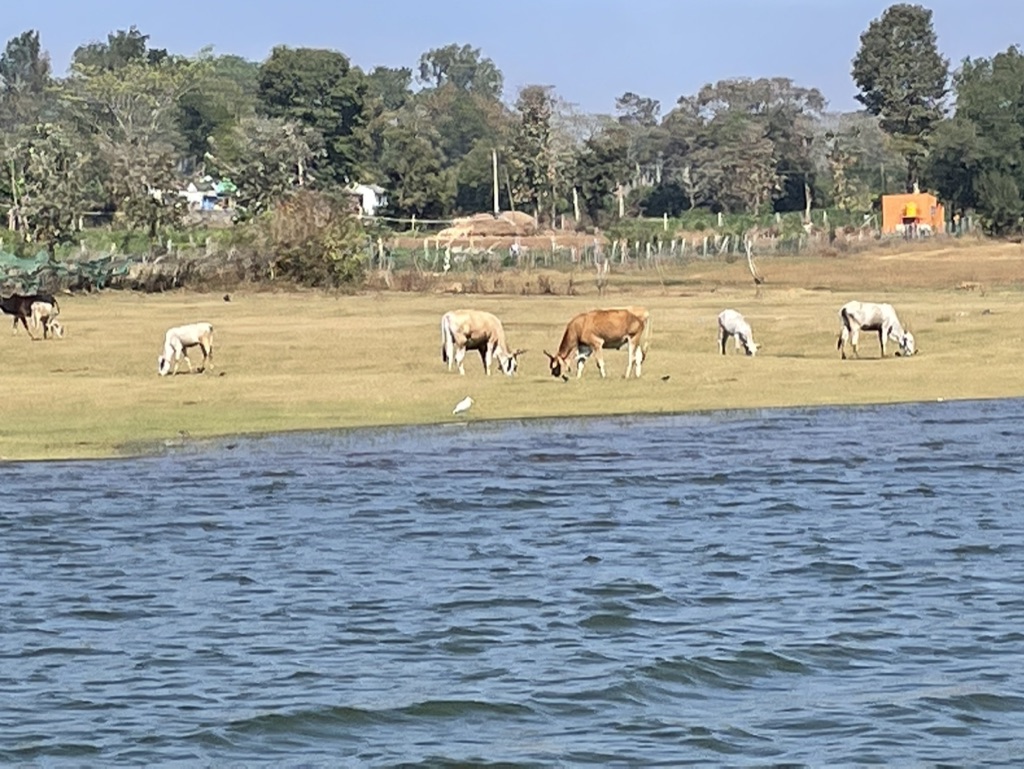
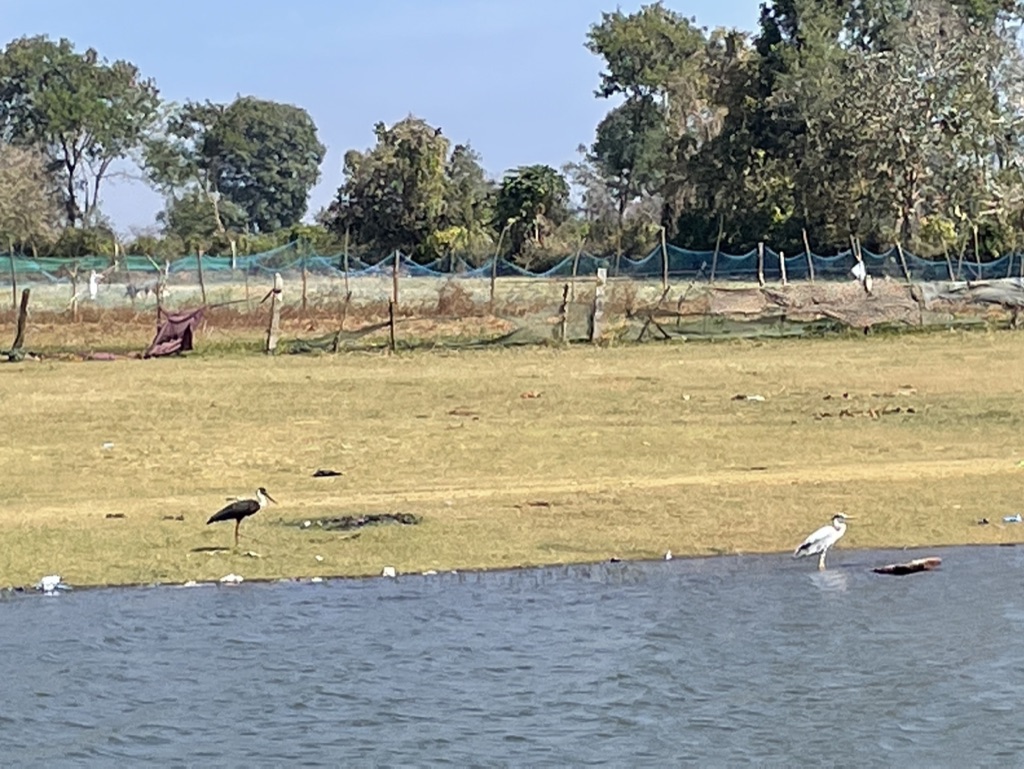
This arrangement from above (the resort staff) has an interesting aspect. Strangers share the same off-road vehicle and spend several hours together daily, inevitably getting somewhat closer as they share the same fate – to see or not to see the main attraction, the tiger. Spotting a leopard, which is considered an even more prized sighting, is as likely as winning the lottery. Even the drivers who transport tourists day after day rarely see one, if ever.
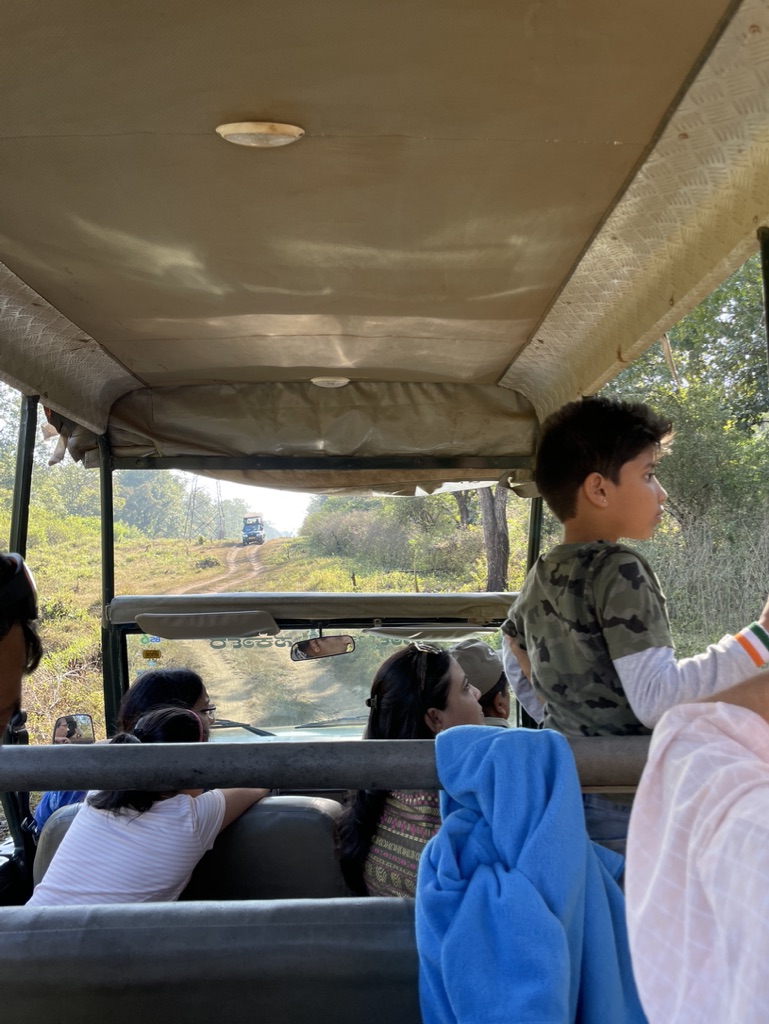
Vehicles for safari, just like the accommodations, are not particularly comfortable or luxurious. The long single-story building where we stayed had room entrances from the outside. The doors to the rooms had latches on the outside and were locked with a padlock. Yes, it’s the kind of lock that lovers attach to bridges with wires. On the inside, such a lock is of no use because the latch is only on the outside. At first, I thought that once inside the room, there was no need to lock it. But upon closer inspection of the entrance door, I realized that there was also a latch on the inside, not at the height of the doorknob but above and below it. Locking it was unnecessary because from the outside, through the closed door, it couldn’t be pulled out of the hole where it was fastened. The standard of accommodation was therefore on par with a military barracks. Even the daily schedule of activities resembled that of the military, and you had no special influence over who would transport you and with whom you would ride. You were simply given the information on where to report and when. We had to walk along the circular road, where the holiday village accommodations were sparsely lined up, to reach the restaurant. There, a long line of safari vehicles was arranged before each safari. One of the staff members with a long list of participants would then inform you of the vehicle’s registration number and the direction in which to find it. Once you found it, you climbed inside and waited for departure.
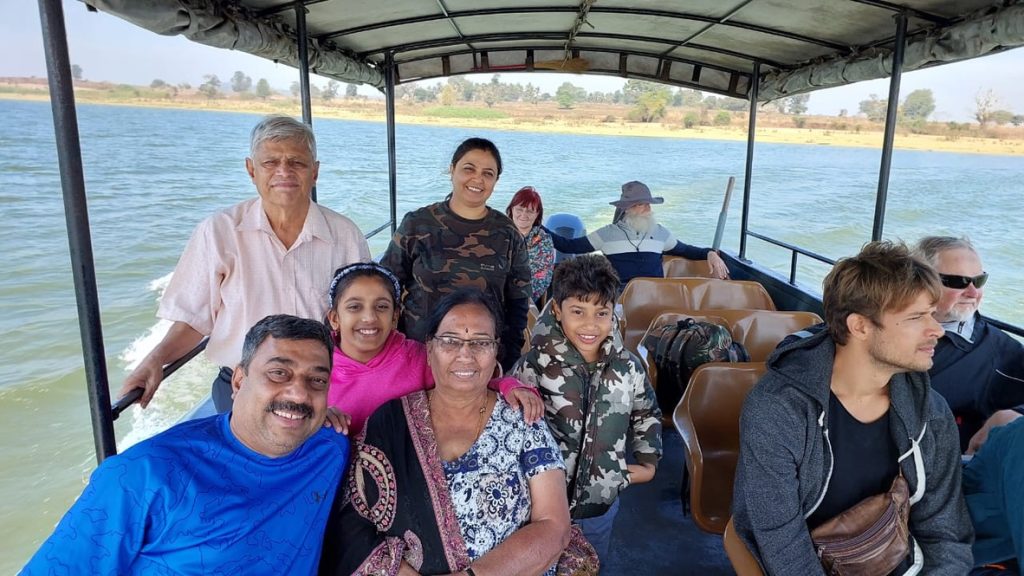
When we found our safari vehicle, most of the seats were already occupied by an Indian family. A boy of about seven or eight years old, during lunch just before the safari, pushed his way ahead of me in line, loaded food onto his plate, and then changed his mind and threw it back into the serving dish. I barely restrained myself and suppressed my instinct to discipline him, silently avoiding the dish with the “contaminated” food since there were plenty of other dishes to choose from. Unless the “contaminator” had been there before. Well, this boy was part of the family of our fellow travellers. With him were his older sister, parents, and grandparents. His father Yogesh was clearly the head of the family. He knew how to take care of everyone, especially showing attentiveness to his mute father. The grandmother appeared to be around our age, while the father was slightly older, and we assumed they were Yogesh’s parents and not his wife’s. Julija immediately surmised that his ability and willingness to take care of others stemmed from his childhood, as it seemed very likely that he had to assume more responsibilities as a child due to his father’s deafness and muteness. As the last member of our expedition, an Argentine living in the US joined us. He was attending a medical conference in Bangalore and was granted a one-day safari opportunity as an enthusiastic amateur photographer. While the rest of us relied on our smartphones to capture beautiful wildlife shots, he had a proper camera with a serious telephoto lens. Such “telephoto enthusiasts” were allocated to vehicles dominated by us “smartphone geeks” who relied on the versatility and reliability of our smartphones. However, smartphones failed us as soon as the wildlife was a bit farther away or very small, such as birds, or both. In such cases, we could only watch, while our American Argentine “clicked” and captured amazing shots. Although we exchanged email addresses, we didn’t receive any of his photos, while Yogesh had already shared his photos with us before the end of our last safari. It seemed that he had developed some kind of connection with us. On our second safari, we learned that he had arranged for us to ride together until the bitter end, meaning until the end of our tourist package. Moreover, he organized a boat ride on the artificial lake for us, so we had already experienced a water safari the day after lunch, so we didn’t have to go on the real one in the evening or morning. Yogesh was also convinced that we would meet again in Bangalore, but it didn’t happen. Perhaps the reason was that we didn’t settle who would call whom, or maybe it was more of a polite gesture than a serious suggestion to meet.
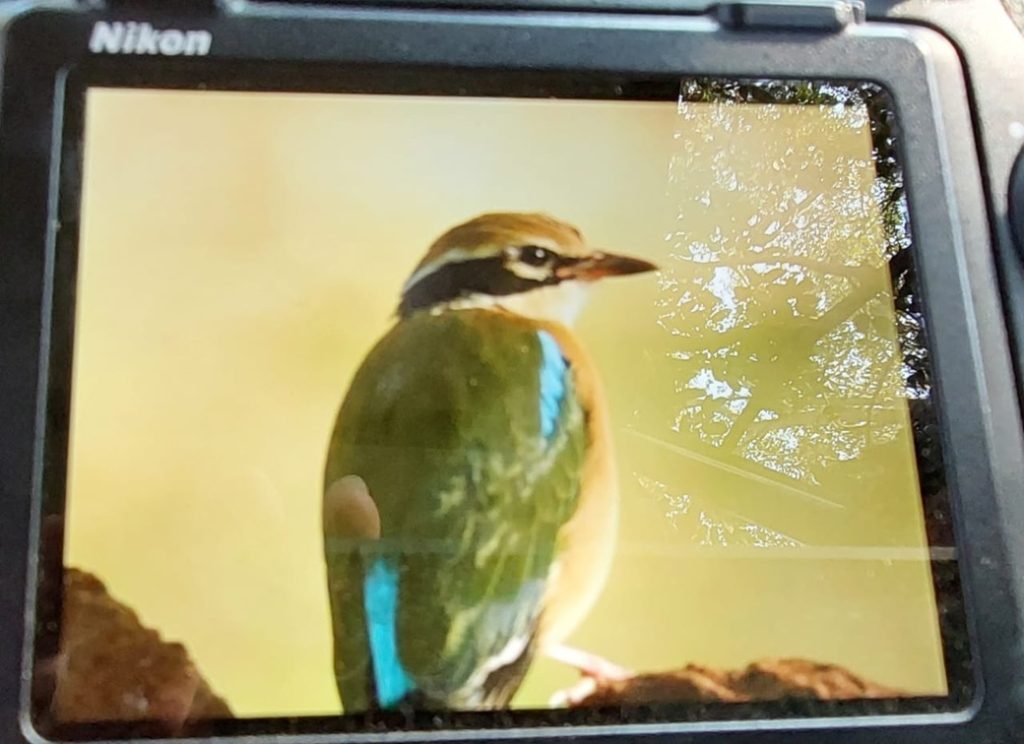
The American Argentine brought us luck, as we were able to see the tiger and even capture it on video and photograph it on the first day. He had been on a safari in India several decades ago and was greatly disappointed. They drove him around all day, but there was no sign of any tigers. Now he had a new opportunity that he didn’t want to miss, and he certainly didn’t. Three years ago, Julija and I were also on a safari not far from here, and not only did we not see a tiger, but we saw more wildlife on an evening drive along the main road through the national park than on that afternoon safari. It’s interesting how you initially get excited about every little deer along the way and take pictures of them from the front and back. But after realizing that you come across them at every turn, you just think to yourself, “Oh, more deer again.” Unless one of those rarer and larger deer called sambar happens to appear. The elephants also garnered a lot of approval and, of course, photographs, whether we encountered an individual enjoying a meal or a family group that paid little attention to the curious onlookers in the rumbling metal box on wheels.
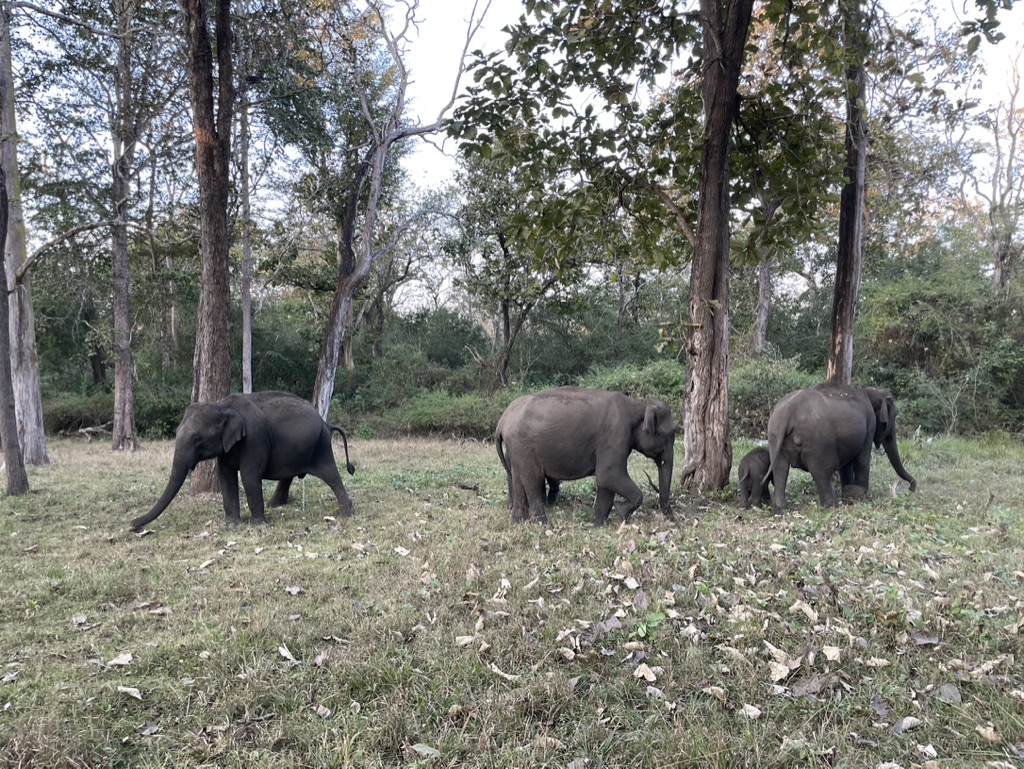
As I mentioned, our first wilderness drive provided us with almost everything worth seeing. Monkeys, deer, various birds, elephants, and of course, a tiger were all checked off the list, but that didn’t mean we didn’t want to observe them again on our next three excursions. However, hopes and what awaits you in the thickets are two completely different things. Our second safari began in the pitch dark at six in the morning. In theory, this should have been a more suitable time for wildlife observation compared to the previous afternoon when we returned before nightfall. But it wasn’t the case. To make matters worse, I was freezing to the point where the pressure in my bladder was becoming unbearable. It’s important to note that getting out of the vehicle is strictly prohibited in the national park. When we were driving through the Bolivian deserts in off-road vehicles, you could simply mention that you needed to use the restroom, and they would offer you an opportunity to go to the “Inca toilet,” meaning relieving yourself in nature. You would step out, take a few steps away, and the problem was solved. Here, among tigers and elephants, such a thing doesn’t even cross your mind. I couldn’t hold on until we reached the holiday resort, so I confided in the driver about my troubles. Of course, we had to wait a little. And when the need is urgent, a little wait feels like an eternity. We drove and bounced along forest paths until we finally reached the asphalt road that runs through the park and is the same road we took back to the holiday resort after each safari. At that point, they let me use something other than their Indian “Inca toilet.” But then, back into the wilderness, where there was mostly nothing interesting or exciting waiting for us. In less than half an hour, my urge to visit an Inca or any other type of restroom was just as strong as before. However, this time, I calculated that we were on the verge of returning, so I held on until we stopped at the resort and rushed to the restroom at the restaurant. For the next morning safari, based on this experience, I prepared accordingly. Since Julija and I didn’t have any winter clothes with us in India, we had to improvise. We put on everything we had, and on top of that, I took a double bed blanket from the bed so that we could both wrap ourselves in it. But no matter how much we bundled up, the morning cold somehow managed to seep through here and there, so we focused more on battling the cold than observing wildlife. In the end, we were quite successful because I didn’t have to beg to be taken out of the forest to the road again for relief. However, it’s true that this time we had a stop at a semi-abandoned outpost where we could get out and use a proper restroom. I gladly took advantage of it, even though it was more of a precautionary measure than a pressing need like the one that tormented me the previous morning.

On this second and final morning safari, we were once again driving around without seeing anything particularly thrilling or interesting. Just when it seemed like we had seen it all, Yogesh suggested to our driver that he should take us back to the resort along the path next to the power lines, where we had a brief opportunity to see a tiger on the first day. And lo and behold, a tiger or more likely a tigress was there again. She leisurely walked in front of our vehicle, clearly demonstrating how tigers in India also use the “Inka toilet,” and then she casually veered off the path and disappeared into the thickets. Yogesh hit the nail on the head with his suggestion, and Instagram was enriched with at least one more photo of a tiger from Nagarahole Reserve.

Andaman islands
Upon returning from the safaris and after an unsuccessful attempt to “repair” my badly damaged filling, Sky, Maša, Julija, and of course, myself, set off on a vacation to the Andaman Islands. The Maldives are much more well-known to the average European tourist, and as a geographer, I also heard about the Andaman Islands for the first time during my first visit to India when Bharat suggested the possibility of visiting this part of India. Once you know that these islands exist and belong to India, it’s natural to want to find out where they are and how to get there. Since they are islands, there are two options: by boat or by plane. The faster and more practical option is by plane. Bangalore is not located by the sea, so we would have to travel for about six to seven hours to reach the port, and then spend two and a half days on a boat. In short, out of the ten days we dedicated to our Indian vacation, more than half would be spent just on the journey to and from the islands. They say that the journey can be as enjoyable as the destination itself, but I’m not sure if that applies in this case because spending five days gazing into endless blue doesn’t particularly appeal to me. Certainly not enough to choose a boat over a plane. I hope passionate sailors won’t hold it against me. As for the question of where it is, I’ve partially answered it: it’s quite far away! Considering the length of the journey, it’s definitely not close. But how far and in which direction? Very far, around 1,000 to 1,400 kilometres from the Indian mainland, towards the east. The archipelago is closer to Myanmar, in the Indochina region, than to India. The distance from southern India to the islands is almost as far as from Ljubljana to Stockholm, and even further than from Ljubljana to Istanbul. Therefore, the flight from Bangalore to Port Blair in the southern part of the Andaman Islands takes almost two and a half hours.
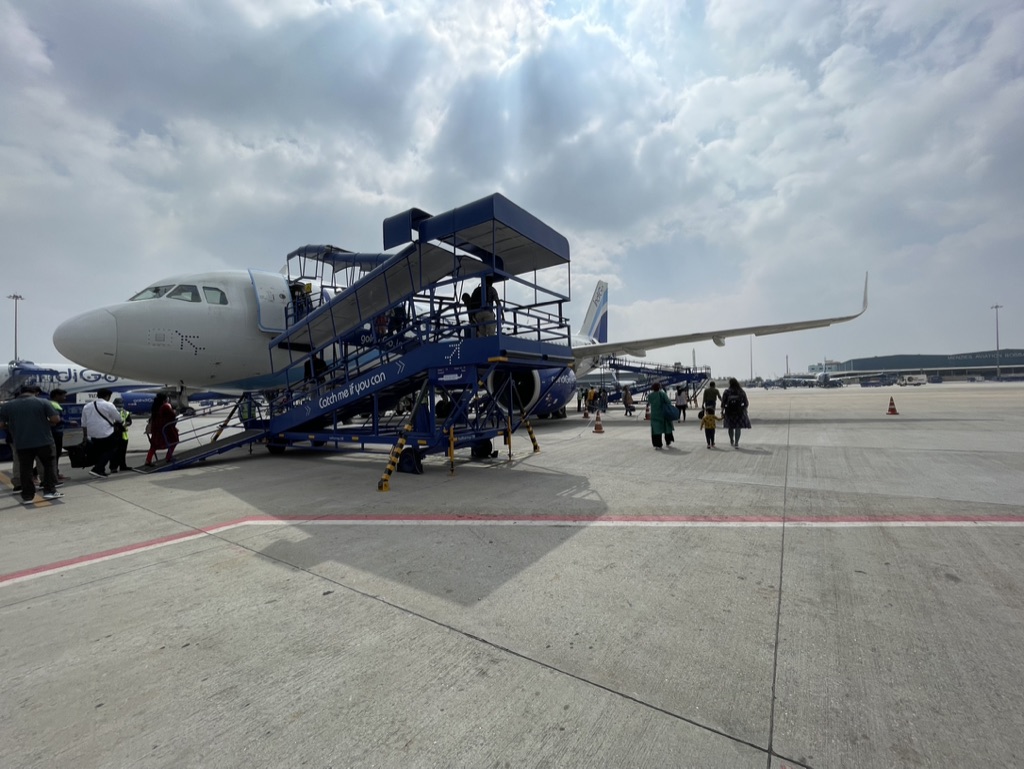
Since we went to the Andaman Islands, it would be somewhat misleading if we spent all the available time only on the main and largest island. However, since we were also on vacation, it would not be appropriate if we spent all the days just travelling from one island to another and exploring each of them extensively. The compromise plan included staying overnight on two islands and in four hotels. Upon arrival and departure, we stayed overnight twice in Port Blair, where the airport is located. The rest of our vacation was spent on Havelock Island, where we stayed four nights at the Sea Shell Resort and two nights at Taj Exotica Resort. Of course, it would have been more suitable for lounging on the beach and enjoying the warm sea waves if we had stayed the entire time at Taj Exotica Resort, but even two nights there cost us a fortune, although we never regretted treating ourselves to a beach-front stay at one of the world’s top-rated beaches. On the TripAdvisor list, where I first came across the name Radhanagar, it was ranked 6th, and at the time of writing this, it was still ranked high at 7th place. In their rankings, it is considered the “best of the best traveller’s choice.” Seeing this admired wonder and not dying became one of the significant reasons for deciding to go to the Andaman Islands for a beach vacation.
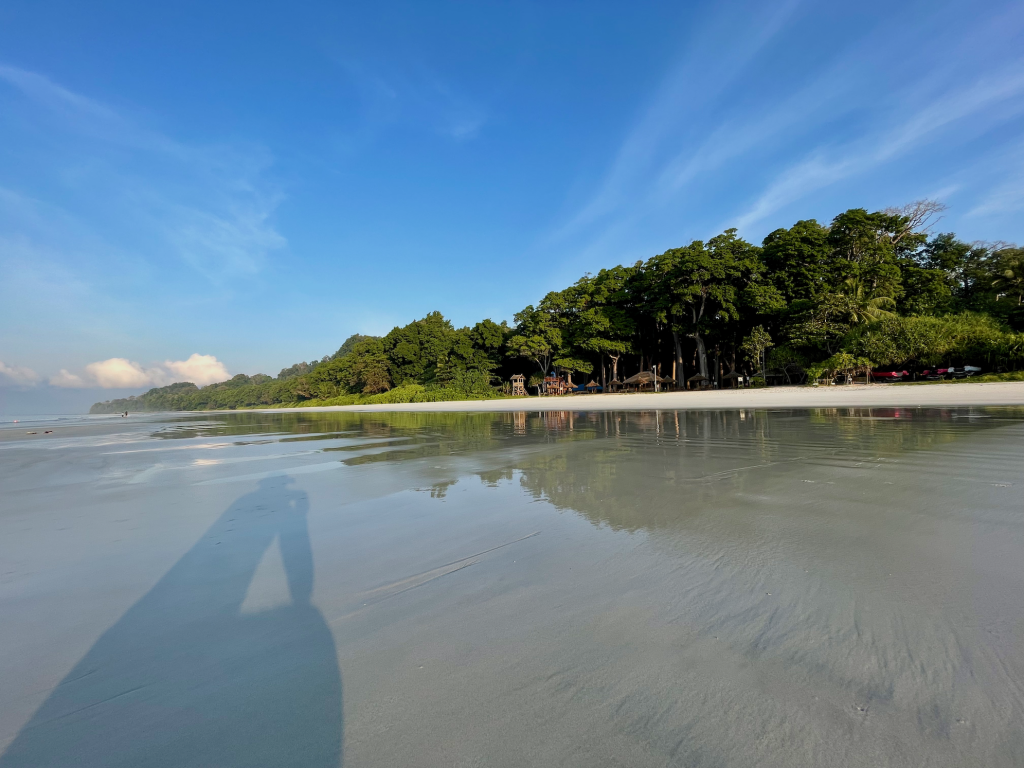
But let me start from the beginning. Upon arrival, we had a hotel reservation in a part of the city that was not far from the main attractions of Port Blair. The hotel was called City View. Maša arranged for a taxi to pick us up from the airport, and they did. The airport is relatively small, similar in size to the one in Ljubljana before the construction of the new terminal. But as we could see, they are already building an additional international terminal, which will put the Port Blair airport on par with “Jože Pučnik” Airport. Unlike the one in Ljubljana, the Port Blair airport is located in the city itself. Before the construction of the Brnik Airport, it was the same in Ljubljana. Now, in the place of the former Ljubljana airport, there is the BTC City shopping centre, and on its edge, we can still see a small airport tower and the former hangar. The street name in that area, Letališka cesta (Airport Road), also reminds us of the airport. If you have an airport in a city that is not very large, it is not excessively far from any part of the city, as long as the traffic is not too congested. In our experience, the traffic in Port Blair was relatively heavy, but it flowed smoothly all the time. I don’t remember any major traffic jams. However, we immediately noticed the difference in cleanliness. There were hardly any visible litter along the roads, and we could see that there were well-maintained side-walks where you could actually walk without being obstructed by all sorts of rubbish, as is often the case in Bangalore. According to the latest population census, Port Blair had a slightly larger population than Maribor. However, recent estimates suggest that there are now more people living in Port Blair than in Maribor and Celje (second and fourth most populated city in Slovenia) combined, approximately 150,000.
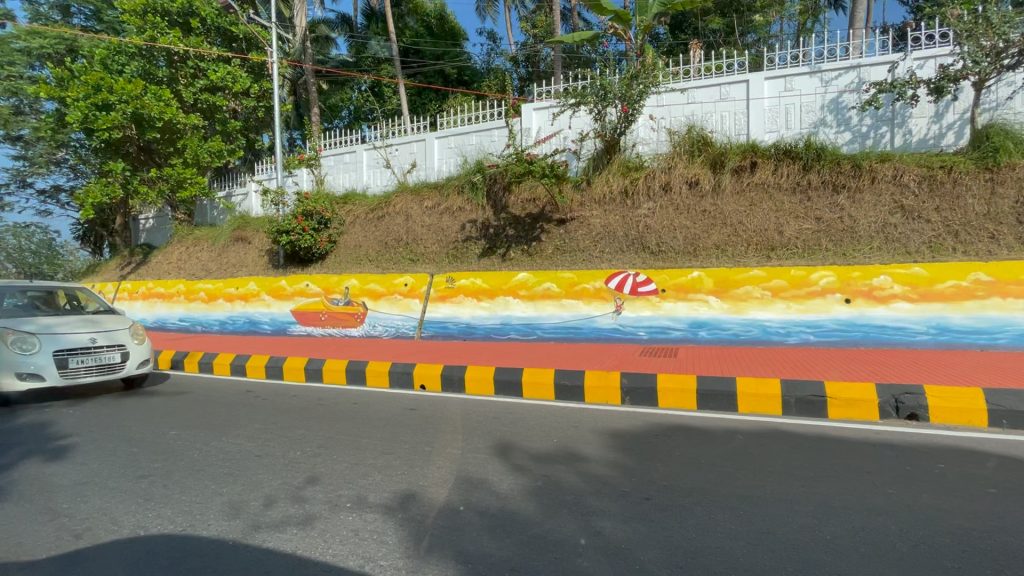
We didn’t have much time to observe the differences between the million-person metropolis we came from and this island centre, as we quickly arrived in the central part of the city where our first hotel was located. However, when the taxi driver stopped on the street claiming we had arrived, I was convinced he had made a mistake. There was nothing resembling a hotel in sight. Small, seemingly unimpressive shops lined the ground floors of narrow single-story buildings, giving the appearance of ordinary Indian streets typical of any small village or town. Upon closer inspection, we did notice that between the crumbling building on the left and the slightly more presentable one on the right, there were steep stairs leading to the entrance on the first floor, where our three-star hotel or “Bed and Breakfast” was actually located. From the outside, it didn’t promise any comfortable accommodation, but we allowed ourselves to be surprised. Upon entering, we encountered footwear at the entrance, as those inside had already taken off their shoes to maintain cleanliness. It was almost as if entering a sanctuary. I also had the opportunity to see that they followed the same practice when entering a shop. They would remove their sandals at the entrance and walk in barefoot. I hesitantly entered the hotel without taking off my shoes, feeling a little guilty. In the small space between the staircase leading to the upper floors and one of the rooms assigned to me and Julija, there was the reception. The room was hot and slightly humid compared to the outside. However, the two guys working there were friendly and accommodating, and the rooms were air-conditioned, clean, and well-maintained. We didn’t even have to complain about the internet connection. Everything was in line with the three stars that this small hotel had. Maša and Sky’s room was above ours, and one floor above that was the breakfast area. It seemed like we were the only guests there. There couldn’t have been many others, considering the relatively narrow building and the small number of rooms. Apparently, the owners also lived on the upper floor. At the reception, one of the guys who welcomed us was present day and night, so I assumed that running the hotel was a family business. In addition to room rentals, they were also happy to assist with planning visits to tourist attractions or arranging taxi services.
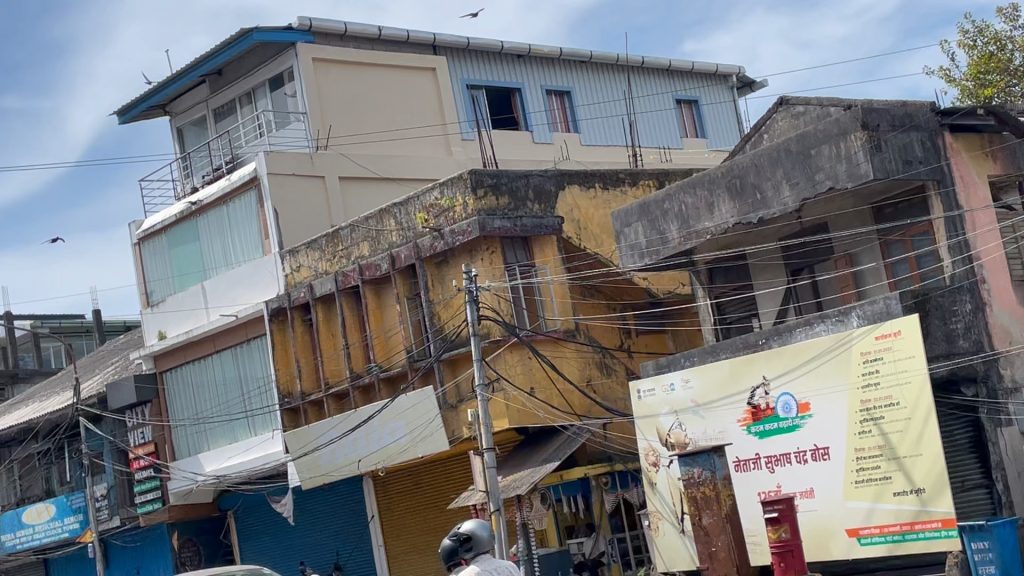
Hotel City View was our ideal starting point for the planned visit to Ross Island and the Cellular Jail, as well as for exploring that part of the city. Both of these mentioned landmarks are connected to the colonial past. The archipelago was colonized by the British only in the 19th century, and they built a massive jail with wings extending from a central small circular area in all directions in Port Blair. Most of these three-story buildings were destroyed. According to Wikipedia, not in the earthquake that struck the islands in 1941, as I read in another source. It is said that they were demolished by the island administration in 1960. Three remaining wings were reportedly saved from destruction due to protests and petitions by independence fighters who were imprisoned there and could not accept the erasure of important evidence of the cruelty of colonial rulers and the suffering of those fighting for Indian independence. Another explanation states that the jail was damaged in the earthquake, and the Japanese demolished two wings to build bunkers, while two wings were later demolished to make way for a hospital. Today, three remaining wings are open to visitors. It is enough to vividly illustrate the cruelty with which the colonial authorities confined freedom-seeking Indian patriots in small cells with heavy iron bars, bare walls and floors, where they ate, slept, and fulfilled their needs within a few square meters. Today, the idyllic garden between the imposing main administrative building of the jail and the prison cells is a place that was once filled with suffering, torture, and killing. The preserved gallows had the capacity for three executions at once. In front of the jail, there is now a park with statues of the martyrs who ended their life paths here in one way or another, inevitably cruel. Back to the top!
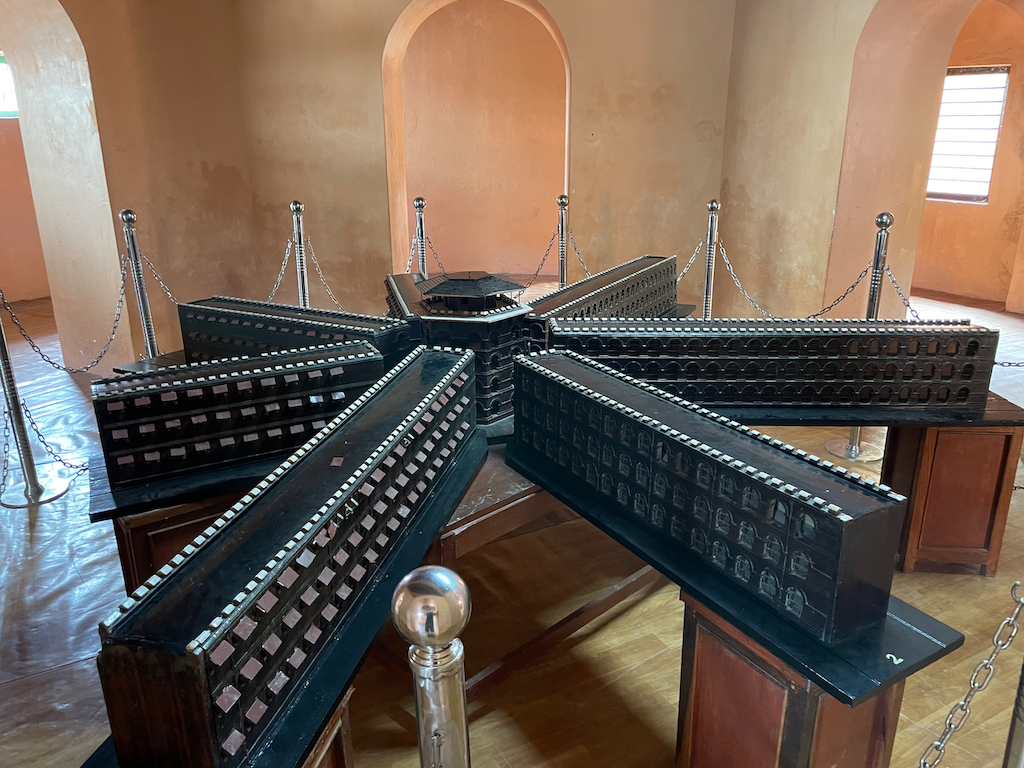
The British colonizers also built a number of buildings for their army on Ross Island. These buildings were also abandoned shortly before the Japanese occupation and were never used again after their departure. The Japanese built a few bunkers on the island, and after their departure and the departure of their Indian collaborators, the island and the buildings on it no longer served their original purpose.
The most recent trace of the colonial-occupational past is the name of the island. The island was renamed from Ross Island to Netaji Subhash Chandra Bose Island. The first word of the name in the Hindi language means “respected leader”, and the remaining words are the name of Gandhi’s contemporary and for a time also collaborator, who, unlike the famous leader of peaceful resistance, was much more hostile to the British colonizers and wanted to get rid of them with fire and sword. During World War II, he fled to Berlin, and from there he came to Tokyo by submarine and plane and founded the Indian National Army. Almost like the Yugoslav People’s Army, but unlike the Yugoslav Partisans, this Indian military leader was on the wrong side of history, or he fought for the right thing shoulder to shoulder with the wrong allies – the Japanese. The latter enabled him to establish a kind of independent India on the Andaman Islands, which had its own government and army. When the Japanese lost the war, this respected Indian leader was on the run from the victors for his life. Gandhi achieved independence with his movement two years later, and over time, many names of settlements, administrative units, islands, and so on fell out of favor with the new government and the official renaming began. The well-known Bombay became Mumbai in 1995, Kolkata (English Calcutta) became Kolkata in 2001, and Madras in the once-named federal state became Chennai (Chennai) in 1968.
In recent years, a more nationalist political trend has been in power in India, and the island named after Daniel Ross, a hydrographer who became an honorary president of the Royal Geographical Society in Bombay during his lifetime, has also been on the list for renaming. He was replaced by Bose in the name in 2018.
In 1941, the Andaman Islands were hit by a catastrophic earthquake, but it is said that it did not destroy the abandoned buildings of the British army. After their occupation, the Japanese built their bunkers on Ross Island, and it is likely that they used the abandoned island buildings as building materials. For the island, which was the administrative center of the entire British penal colony on the island, the departure of the British before the looming Japanese occupation was a rather cruel end to its former glory. Because of the luxury and comfort in which the high officials lived there, it was called the “Paris of the East”. But despite all the luxury, the island was also in the time of its greatest rise almost in the middle of nowhere and the deployment of military and administrative personnel to the island was considered a punishment. Just in accordance with the saying: “A cage is a cage, even if it is golden!”.
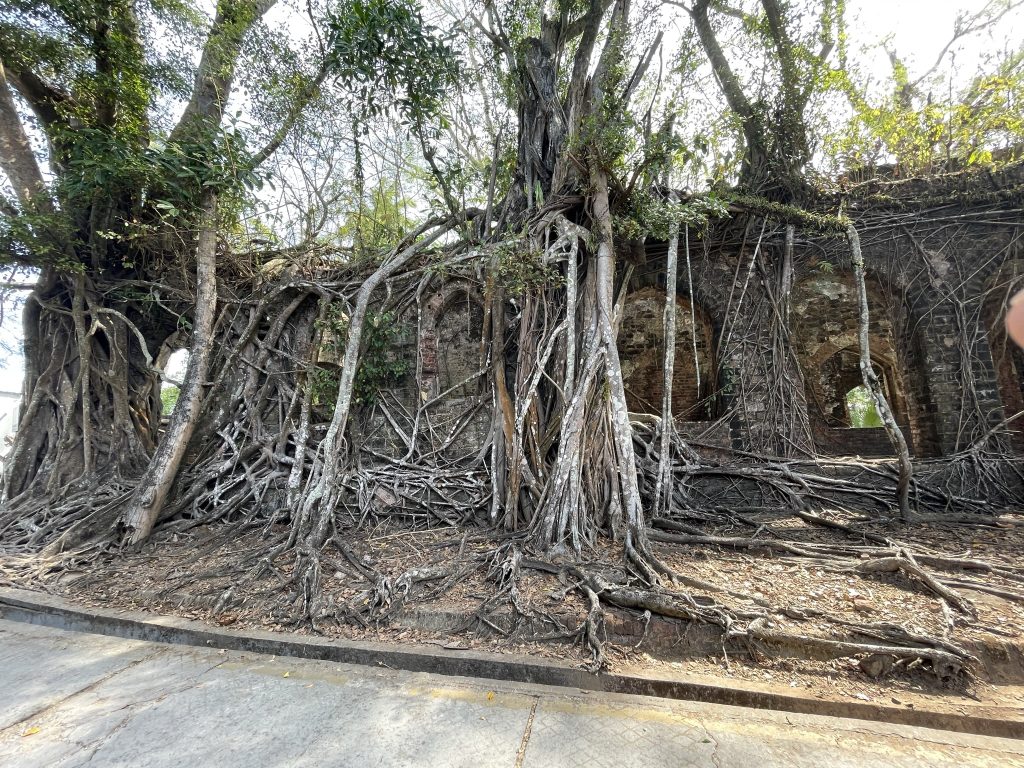
Today, despite its new resonant name, everyone still knows the small island simply as Ross Island. It is shorter and more practical, after all. Moreover, even the Indians on the Andaman Islands are not indigenous inhabitants but rather immigrants. According to estimates, there were around 7,000 members of the Andamanese tribes in the mid-19th century, but today there are reportedly less than 500, living in some places with little contact with the outside world. From the perspective of the remaining indigenous population, these immigrants from the Indian subcontinent are also a kind of colonizers, foreigners who exploit natural resources and beauty for their own economic benefit. Therefore, naming it after the Indian version of Croatian leader Ante Pavelić is controversial on one hand due to his collaboration with the Japanese, but on the other hand, from the perspective of the indigenous population, this name is just as artificial and foreign as the naming after the explorer and mariner Ross.
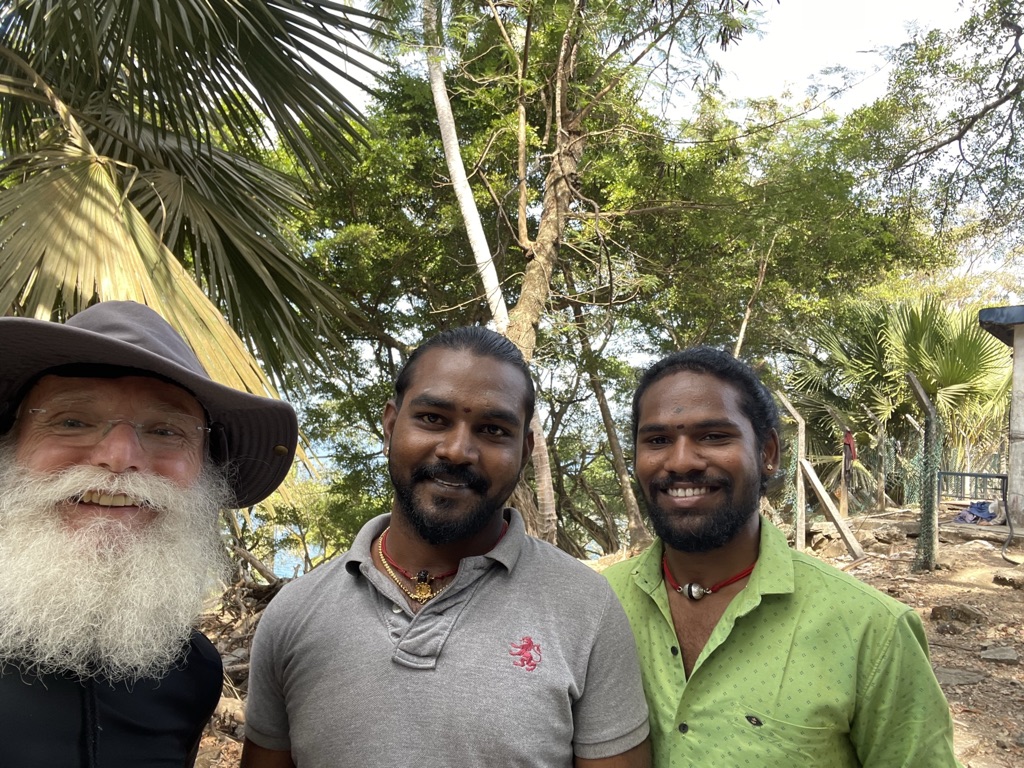
Whether the island is called one way or another, you have to reach it by boat. For Sky, it was his first boat ride, and he enjoyed every minute of the 20-minute journey. On the island, we then took a ride in an electric vehicle, similar to the one Julija and I experienced on our trip to Wayanad. We rode to the top of the island, passing by the remains of once luxurious buildings. From there, it was possible to walk down to the other side to the lighthouse. There was only enough time for a few photos and to explore the preserved walls of the barracks complex, which has been engulfed by mighty trees over the past eight decades, making it look like a set for a Sleeping Beauty movie—minus the thorns, of course. We then returned to the port on the open electric vehicle, where we had a chance encounter with a herd of deer while sipping juice on the terrace of a local café. Feeding the animals is strictly prohibited, but as soon as the rustling of candy or cookie wrappers is heard, the deer and hinds gather around you in anticipation of a treat, resembling zombies. It’s easier to ask tourists for food than to forage for meagre vegetation on the island, which is the natural food for these animals. However, it didn’t seem like there was enough for all the members of the numerous herd that had thrived on the island. The whole scene is reminiscent of Tito’s Brijuni. You are taken on a tour, where you can also observe wildlife, and once it held much greater significance than today, when it is merely a tourist attraction. But the fact is that in every aspect, the Brijuni Islands far surpass Ross or Bose’s Island. Back to the top!
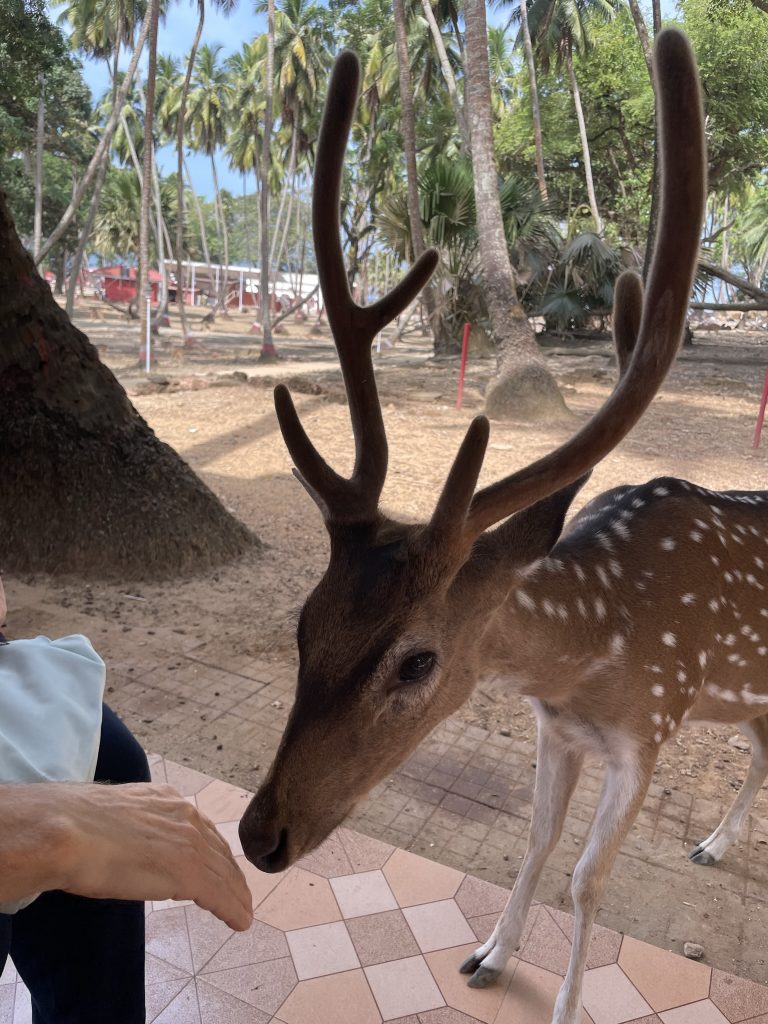
But enough about the island where we spent less than two hours. The most important part of our vacation was spent on Havelock Island, where the journey alone on a comfortable catamaran takes almost as long as we stayed on Ross Island. Havelock Island was also renamed during the time of the current Indian Prime Minister Narendra Modi and is now called Swaraj Dweep. The second part of the name means “island,” while the first part, “swa,” means self, and “raj” means rule or governance. This is how Gandhi referred to his concept of liberation from British rule, and a similar term and concept were used long before him. However, among the locals, this island is still much better known by its old name, Havelock. It is actually the surname of a long-forgotten British general, known probably only to historians who specifically study the time and places in which he lived and operated. Outside of India, this island is not widely recognized, even though it boasts one of the world’s best-rated beaches. It is mainly visited by Indians, while foreign tourists, especially after the outbreak of COVID-19 and subsequent lockdowns, are rare, almost as rare as tigers on Indian safaris.
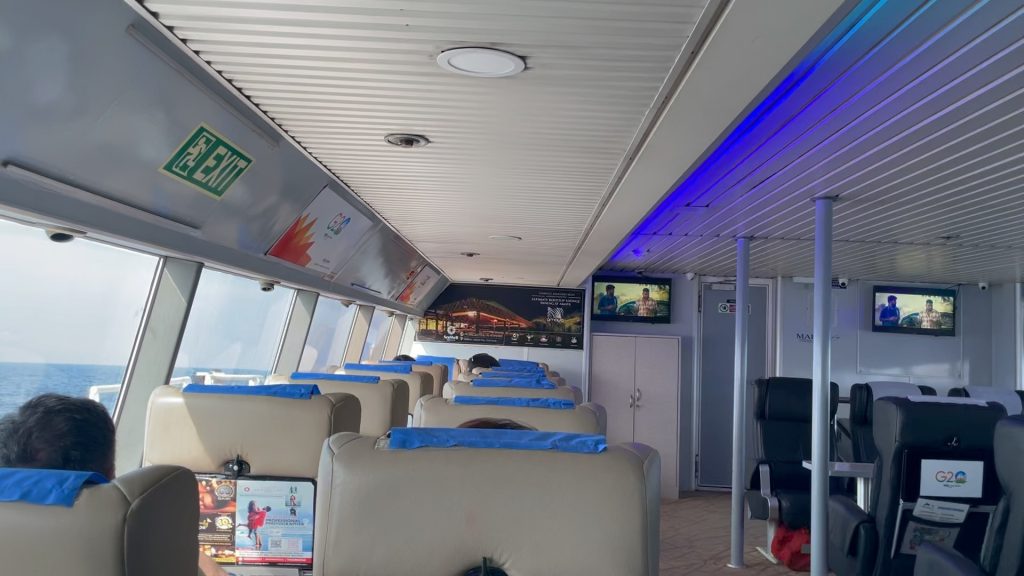
The only way to reach the island is by water, either by ferry or by catamaran. The options are quite diverse, and Maša chose the most comfortable one for us. Before we could enjoy the spacious comfort of the modern catamaran’s upper deck, where only a handful of local tourists were travelling alongside us, we had to go through port formalities, which were quite similar to those at airports. We had to carry our luggage ourselves to the ship; they didn’t take it and transport it for us. We mostly waited in the port building for about an hour without any serious need until the boarding began. Everywhere, there were signs strictly prohibiting photography because the Andaman Islands are a place where all three branches of the Indian armed forces can be found, and the naval branch has some of its vessels and infrastructure in the port from where we set sail towards Asia’s most beautiful beach.
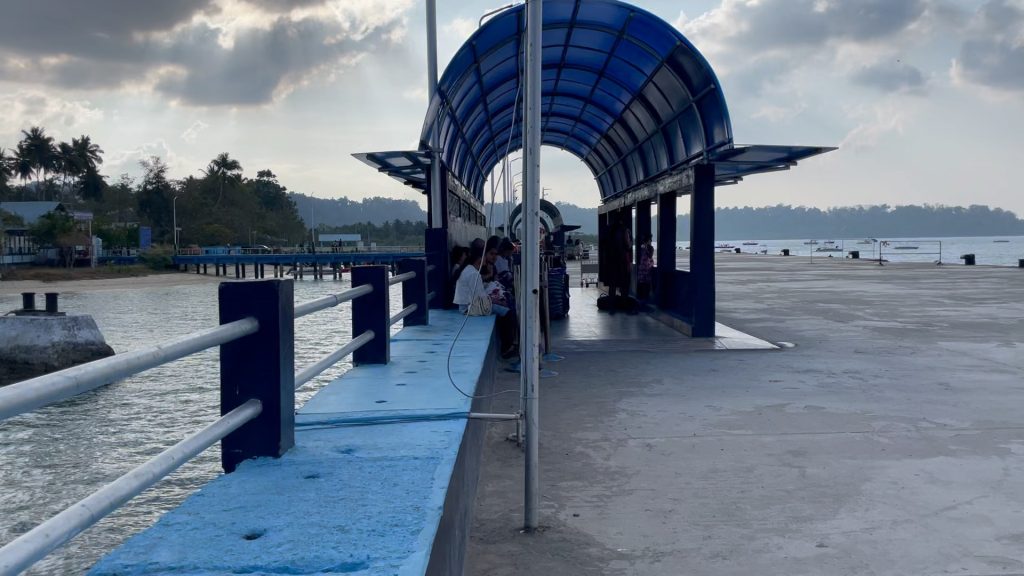
The port on Havelock, where we arrived after about an hour and a half, hardly deserves the name. There is no sign of a port building, but there is a long shelter on the jetty where you can wait for the departure of the ship in the shade. Upon arrival on the island, you simply search for and drag your luggage across the worn-out surface of the jetty, and then you choose a mode of transportation among the waiting drivers. Or sometimes the driver chooses you, as transportation is always a matter of negotiation and mutual decision. We weren’t successful with the first taxi driver because he demanded too much according to Maša’s standards. He mentioned that we also had the option of a rickshaw for half the price, but since there were four of us with a lot of luggage, it would be the same because we would have to travel in two separate rickshaws. However, the man was mistaken because our rickshaw driver managed to fit all our luggage into his vehicle, and we squeezed ourselves onto the seats behind him. We were used to this arrangement since in Bangalore, we often travelled with three adults side by side and one child on our laps, which we referred to as “three plus one.” We even had an experience with “three plus two,” which meant three adults side by side, Maša, and Sky on our laps. One of our smaller suitcases, for which there was no space behind the seats, ended up under the driver’s feet since he doesn’t use them while driving since he has everything he needs to operate the vehicle on the handlebars, or as we say, on the “balance.” We were so impressed with his resourcefulness and helpfulness that we granted him exclusive rights to transport our tourist group for the entire duration of our stay on the island.
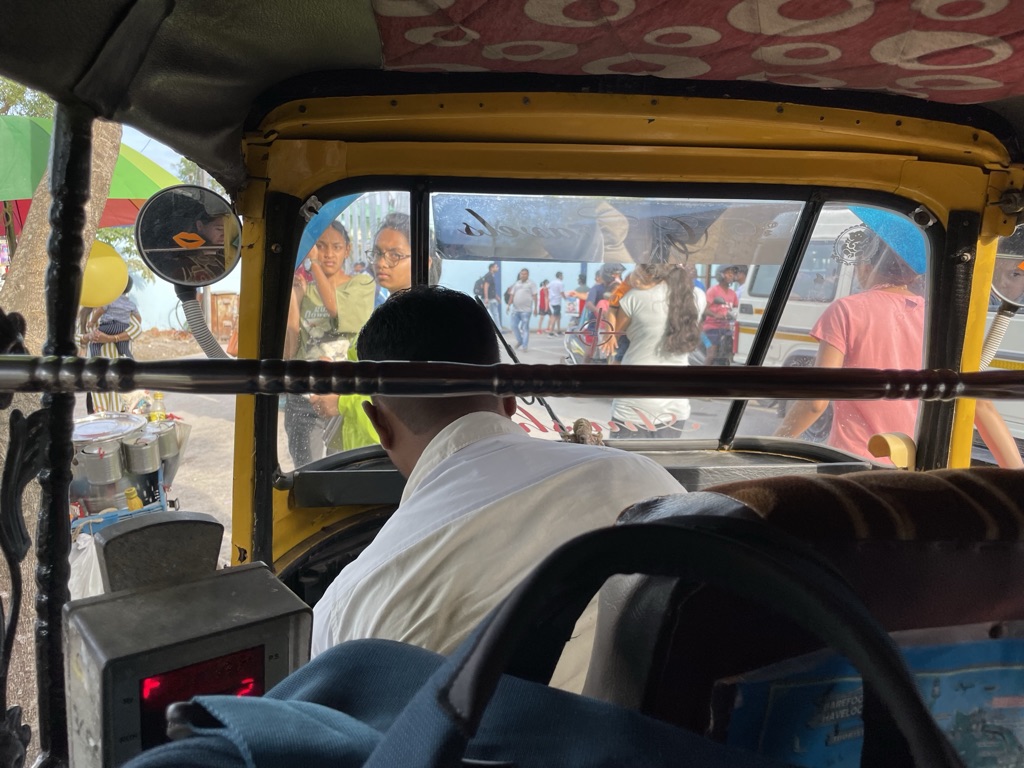
He took us, for example, to our first swim in the sea, to a beach that was so littered that despite all the efforts, it couldn’t be cleaned even remotely. The waves kept bringing plenty of grass, leaves, and branches, all mixed abundantly with various plastics and other waste that our “civilization of garbage collectors” throws into the seas, rivers, and nature in general. Despite it all, we spent a pleasant morning there, enriched with interesting experiences or two. The first was realizing that it’s possible to swim even in a polluted sea, and the second was that Indian tourists overlook the litter and see the beach only in all its natural beauty. While I was angry and disappointed that such a beautiful beach was so full of trash, they seemed to simply ignore all the disturbing waste or were so accustomed to it that they no longer even noticed it because it was part of their everyday scenery in the cities they came from.
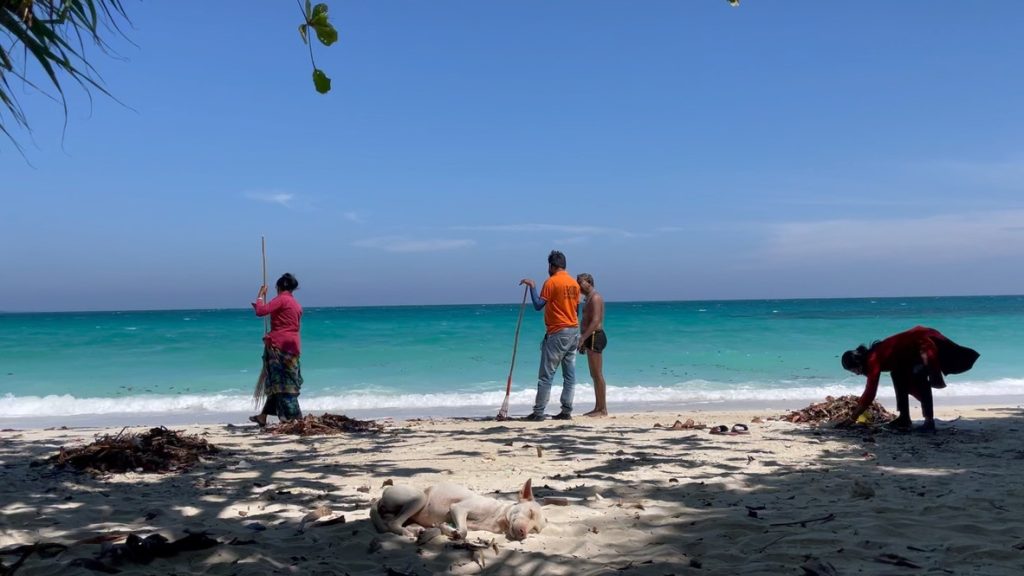
We also went with him to another beach, which we only visited as it was already a bit late for swimming. In fact, he took us to a private beach of a holiday resort and told us to just go in, as nobody would know that we weren’t their guests. Indeed, nobody checked who entered or left the beach, as is customary elsewhere. The beach was beautiful and well-maintained, with swings hanging from tall trees nearby. The beachside bar in the resort served only exotic cocktails, nothing that suited our taste. However, we were especially glad that we hadn’t chosen this holiday resort for our longer stay on the island because as soon as the sun dipped below the horizon, swarms of mosquitoes invaded the beach. We quickly called our driver and made a tactical retreat to our Sea Shell. Back to the top!
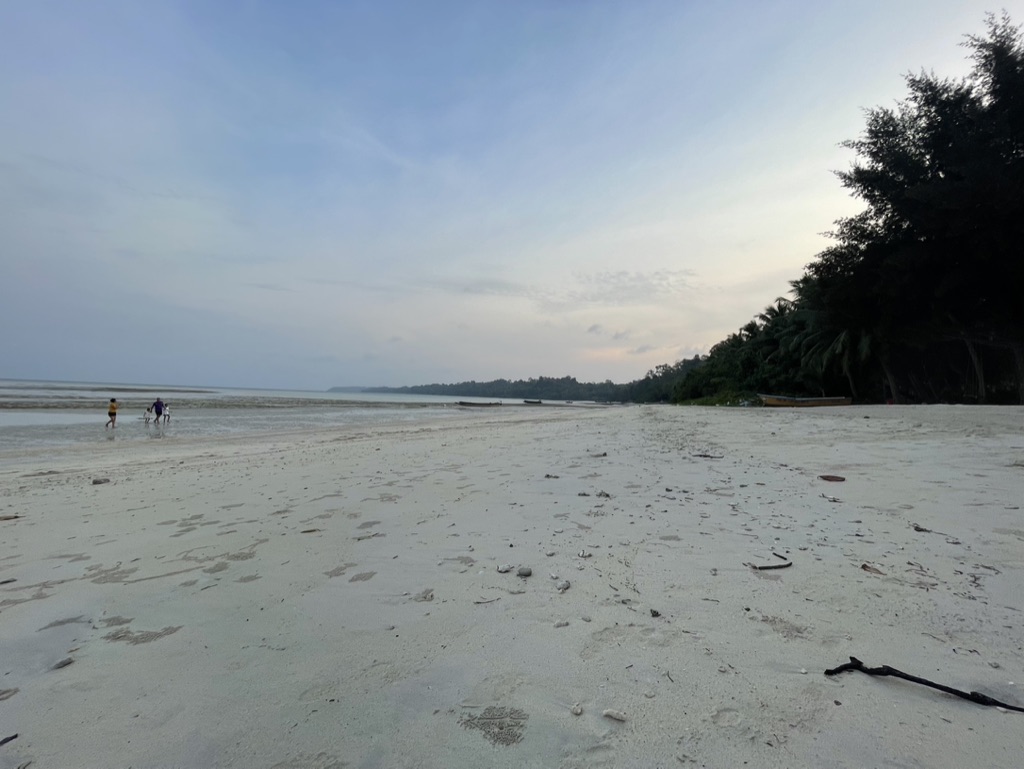
“SeaShell Resort” is a true paradise for vacationers, with one or two flaws. The second flaw probably depends on the location of the cottage where you stay. If it is exposed to the noise of the generator that provides electricity for the entire island, like ours was, then the blissfulness of staying there is slightly diminished. The first flaw is that despite the resort being located on the coast, you are not allowed to swim in the sea. Whether this is to protect the coral from swimmers or swimmers from the coral, I do not know. However, every morning, across the shallow area that was dry during low tide, tourists and instructors would venture out for diving. First, before sunrise, the diving instructors would arrive and load the equipment onto the boats, and then the participants would join them. For those of us who didn’t have diving ambitions, we simply explored the marine life in the shallow sea among the remnants of mangroves, and even that was a pleasant experience, especially in the early morning before the sun emerged from the other side of the Andaman Islands. For swimming, we had a pool near our cottage, which we almost never had to share with more than a few random individuals. Often, we had it entirely to ourselves. Around the pool, there was a wooden deck with lounge chairs, and palm trees provided shade for relaxation, although it wasn’t overly hot even in the sun. There was always a pool attendant ready to provide us with towels and a swim ring for Sky. What more could one wish for? Well, except for not having to listen to that annoying noise from the small diesel power plant on the romantic wooden balcony of our apartment.
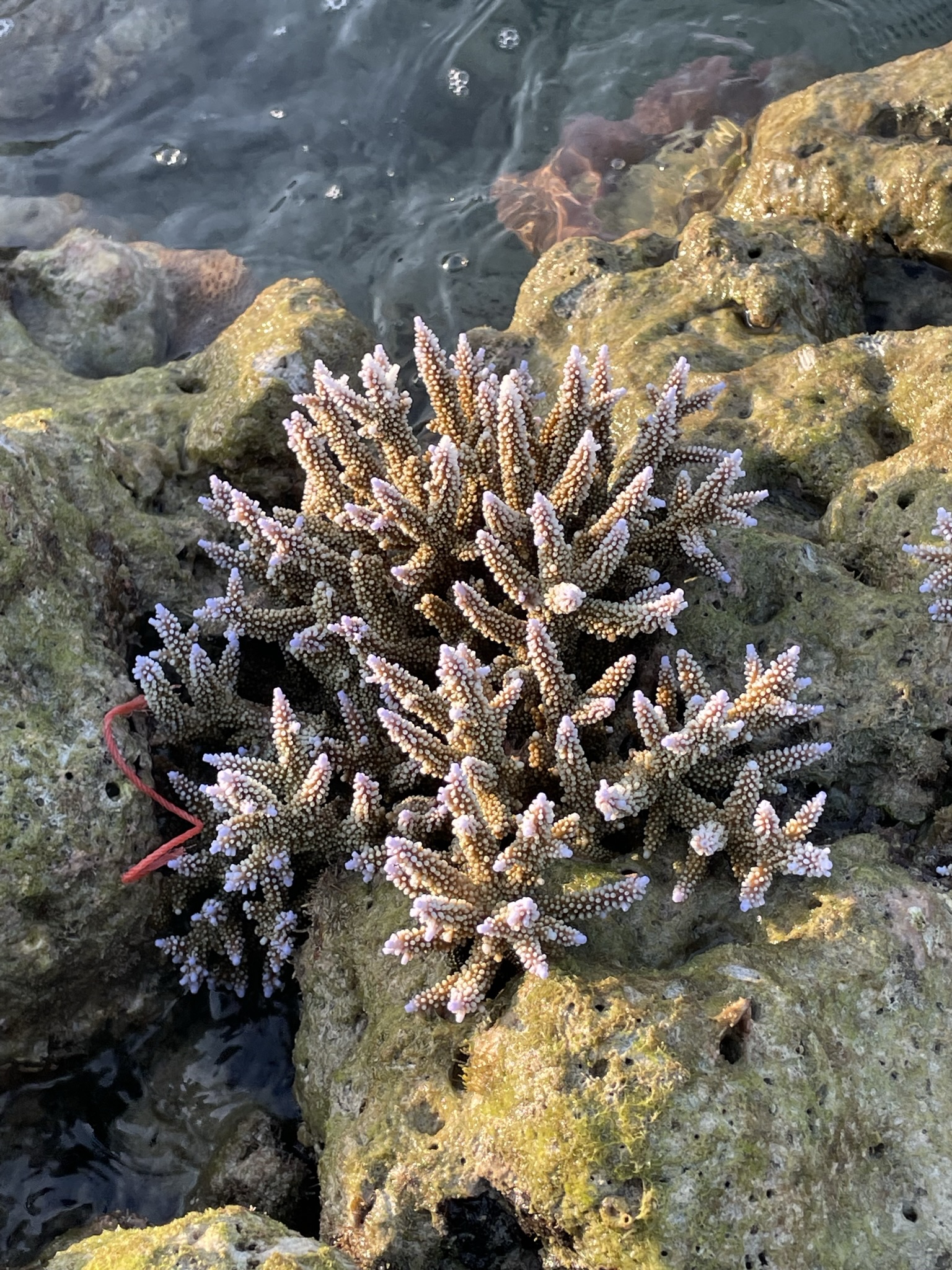
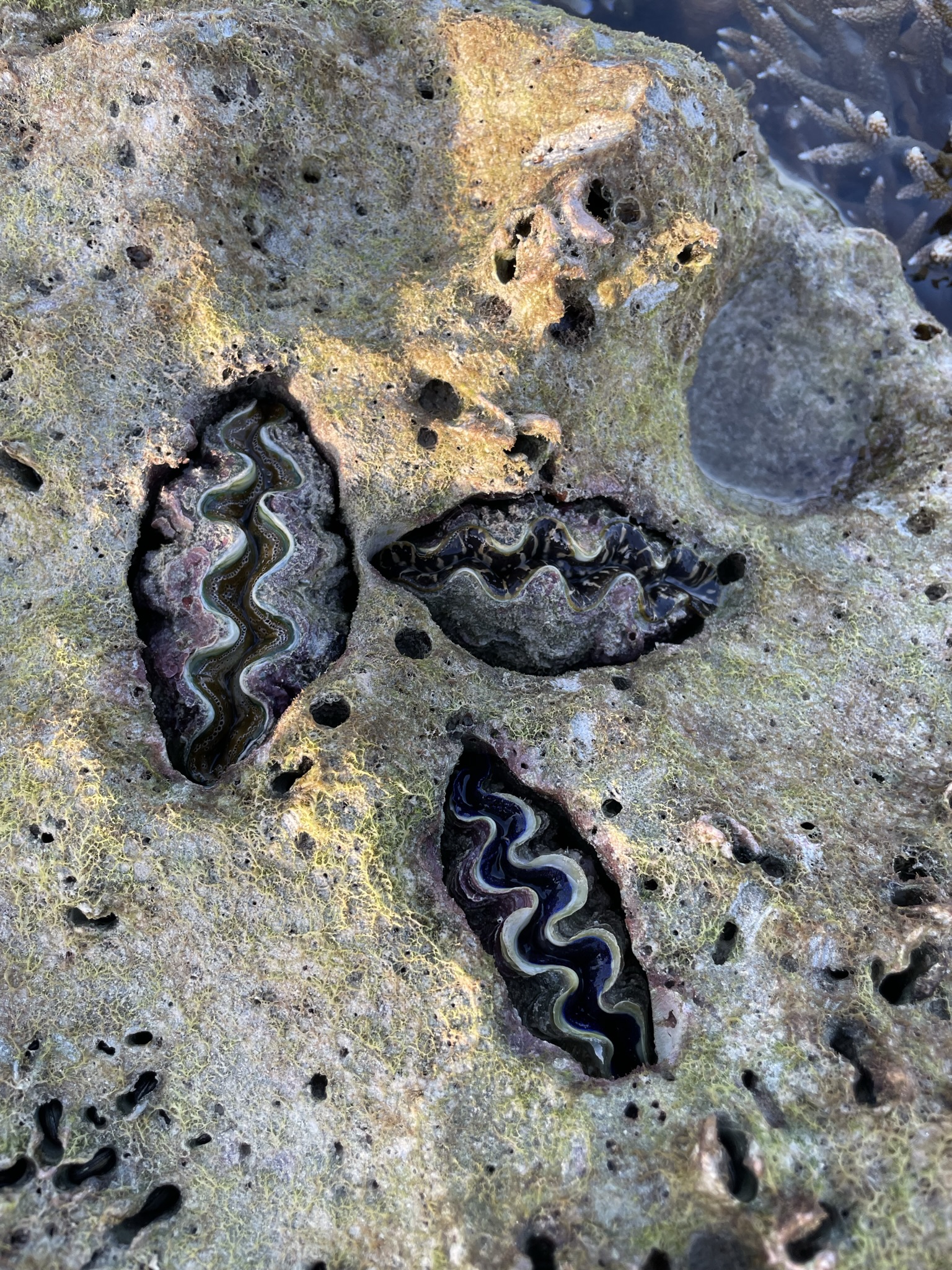
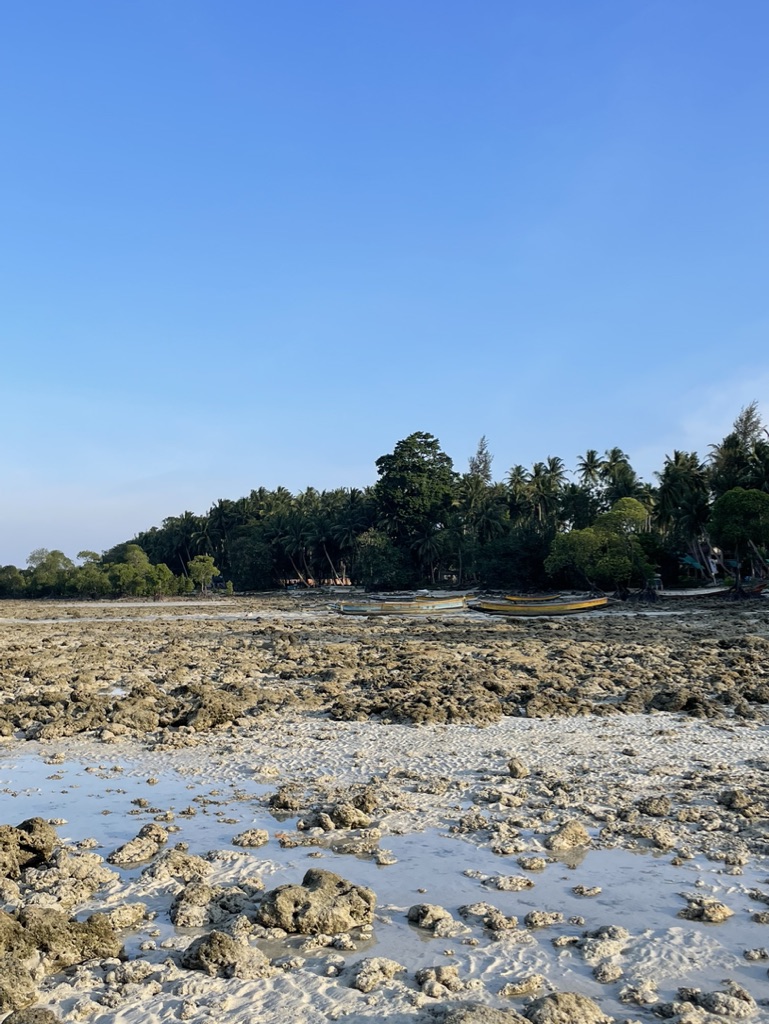
The holiday resort has a fairy-tale-like design. It goes something like this: “On an island in the middle of the sea, there is a resort. Inside the resort, there are paved pathways with street lights, and every so often, there are charming cottages …”. The cottages are not packed closely together; there is enough distance between them that the entire resort resembles a vast park rather than a tourist village. I don’t know how many guests were there during our stay, nor where they were, because at every turn in the resort, you could come across the employees who were cleaning, tidying up, and fixing things. As for fellow guests, you would only encounter them in the morning during breakfast at the restaurant, fostering a sense of coexistence.
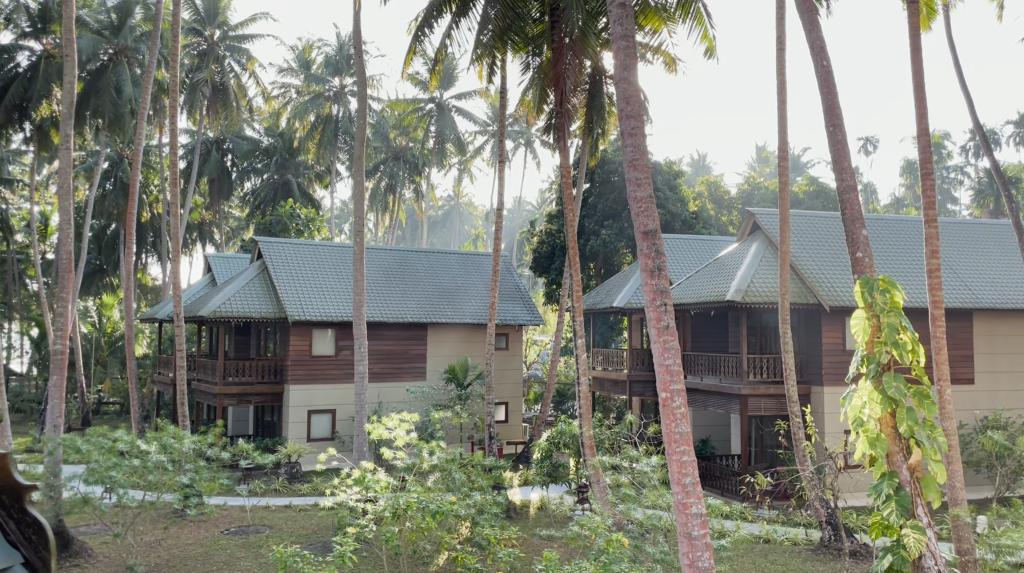
Our accommodation here was in a two-story house with one apartment on each side of the staircase, meaning there were two apartments on the ground floor and two above. Ours was on the upper floor, so the wooden ceiling was not level but followed the roof slope high above us. Not only did we have plenty of space, but the volume was also immense because of it. We certainly did not lack comfort and space. The balcony allowed for pleasant sitting with a view of the palm grove, only disturbed by the aforementioned noise. The wide double bed and an additional mattress were more than enough for all of us to sleep comfortably. The bathroom was also spacious and nicely arranged. In short, no complaints. The bathroom or toilet is usually the space that, in my opinion, determines the quality of accommodation. Even if everything else is more or less in line with standards, many places fail in terms of sanitary facilities. But this was not the case here. Although our accommodation was essentially a room rather than an apartment, as it did not have a kitchen and dining area but only a corner for making coffee or tea, the space felt more like an apartment than just a room due to its spaciousness.
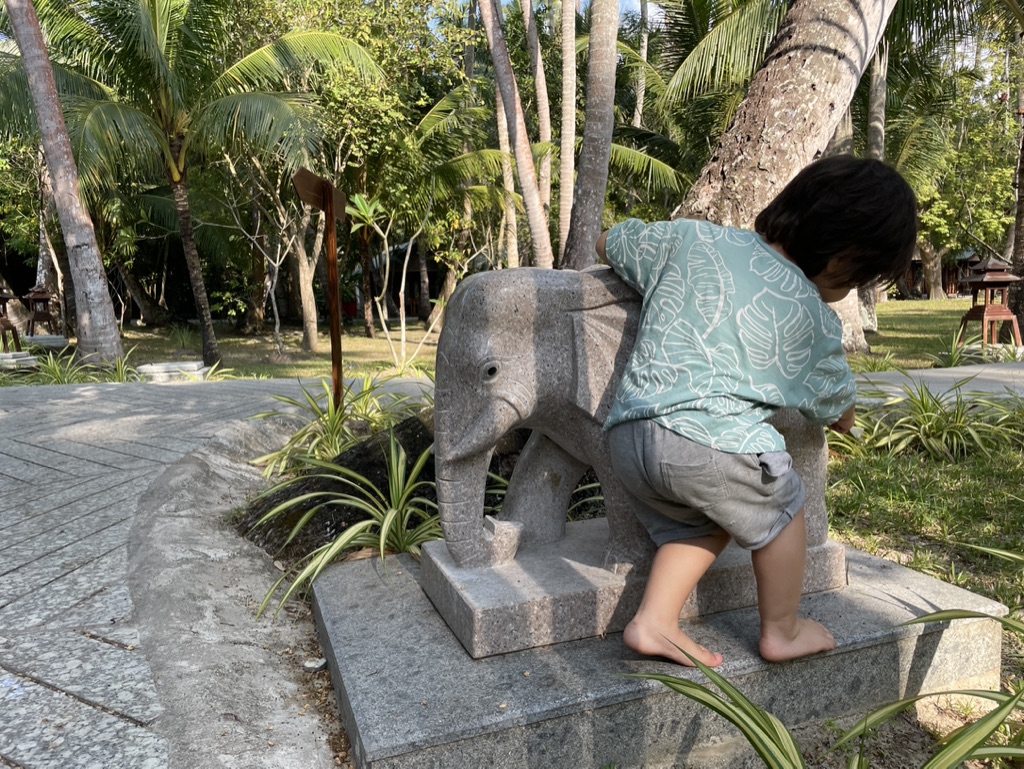
The fact that we were in a holiday resort of a slightly higher quality class was also evident in the prices at the restaurants within the resort. However, despite that, the prices were lower than in average Slovenian restaurants. In the restaurants along the street that looked like they were hastily set up for their annual firefighter celebration, the four of us had dinner for about 16 euros, which is roughly the cost of a vegan pizza and green tea for me in Koper. Back to the top!
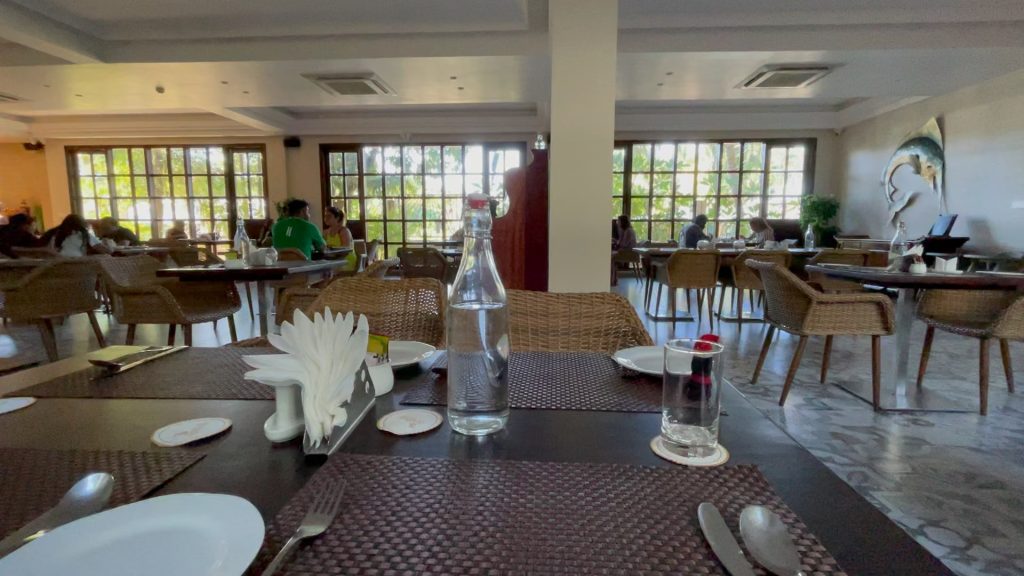
We saved the grand finale for the end of our stay on Havelock. The five-star Taj Exotica resort is located directly on that much-celebrated beach, the most beautiful in Asia and among the top ten in the world. Our regular driver took us there as well. Our arrival with such an unusual mode of transportation for guests of such a luxurious hotel was, to put it mildly, unusual. But before the staff even realized we had arrived and how we had arrived, our luggage was already unpacked, and we were ready to enter. The staff grabbed our suitcases and bags, and we were invited to the large covered reception terrace. There, we filled out registration forms and were welcomed with coconut water from their own coconuts and shell bracelets. As if that wasn’t enough, a quartet of receptionists sang a traditional welcome song to us with such unease that we didn’t know who felt more uncomfortable, the singers or the listeners. Then, we were taken to our accommodation in an open electric vehicle. And what an accommodation it was. Only the terrace, stretching the entire length of the building, supported by four corner pillars, was as spacious as our entire apartment in Sea Shell. The interior was so spacious that one could play tennis inside, if I may exaggerate a bit. The bed was truly royal, complete with a canopy. There was a long hallway serving as a wash room with two widely spaced sinks. At one end of this long hallway was the toilet, and at the other end was the bathroom. It was quite a decent walk from one of these private areas to the other. Everything was imaginatively designed, and just like in Sea Shell and Mountain Shadows, wood added warmth and homeliness to the space. Most of all, the main sound heard here was the singing of birds or mysterious sounds from the tropical forest. Occasionally, a maintenance vehicle would pass by, but guests were almost silently transported around the resort in open electric vehicles. It would take about 10 to 15 minutes to walk from the restaurant to the farthest accommodations, and a few more minutes to reach the beach. Complimentary bicycles were also available to guests, which often ended up abandoned or left all around the resort after use.
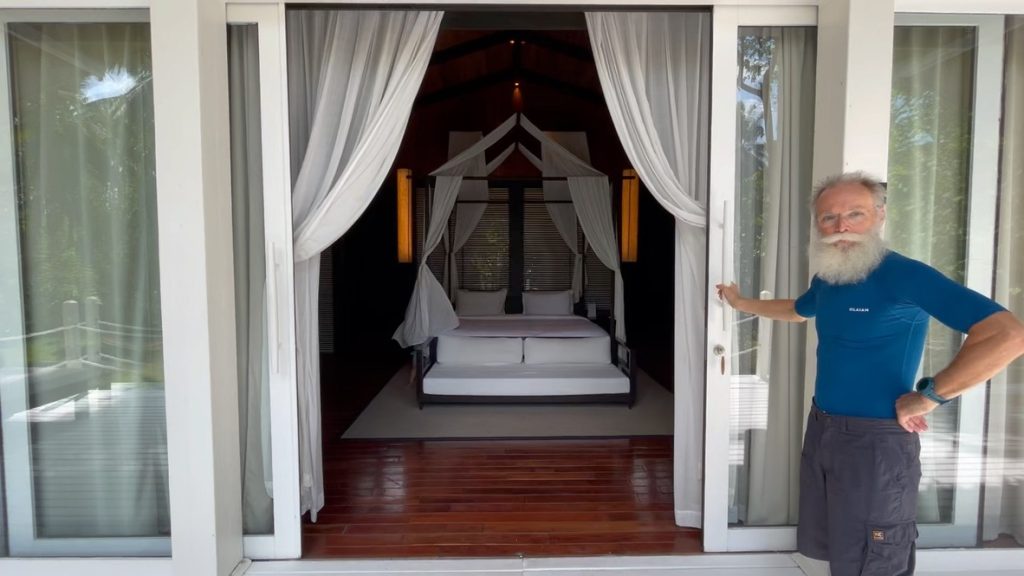
The accommodations of various quality levels are even more sparsely scattered here than in Sea Shell Resort, but they are mostly built on stilts. Some of the stilts were so tall that one could walk underneath the buildings without having to stoop too much. There is a real grove of coconut palms among the accommodations, so drinking coconut water is included as a welcome gesture.
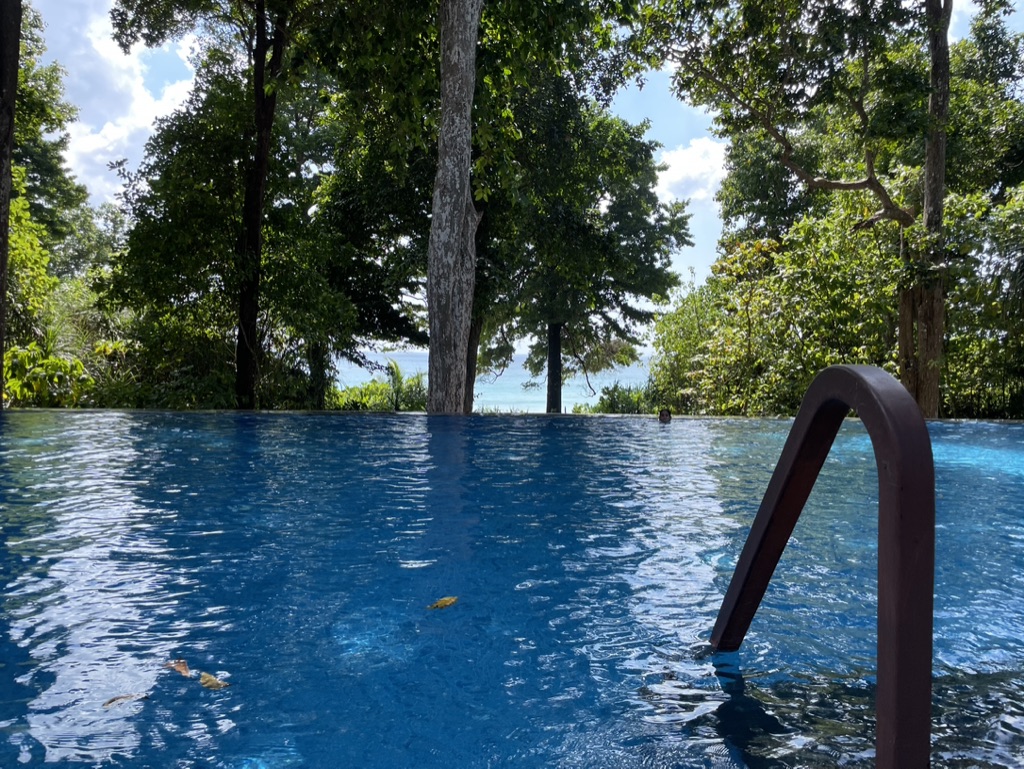
The building has a pool on the first floor, above the reception, and there is also a restaurant by the pool. The size of the pool is almost Olympic-sized, and through the tree canopy, one can see the waves of the sea. However, the water was noticeably cold for indulging, more suitable for swimming than lounging. But when you have one of the most beautiful beaches in the world and pleasantly warm sea at your disposal, it doesn’t really matter how the pool is or how warm or cold the water in it is. And the beach truly did not disappoint us. It can be somewhat frustrating that the majority of the beach is shared by two hotel resorts, and if you are not their guest, you have to squeeze onto the modest remaining section. For those who have enough means, there is the privilege of enjoying the beauty of the sandy coast, bordered by green forests of majestic deciduous trees, which add a special charm to the beach. Upon entering the beach, they serve you snacks and drinks, provide you with towels, set up a beach chair and umbrella for you – basically, everything you need for comfortable relaxation and swimming is provided right there. Above all, the beach is as clean as a whistle. Well, my hawk eyes (even with glasses) managed to spot an occasional plastic waste here and there, but it’s quite evident that not many of these waste items make it to the beach in the first place, and whatever the sea brings in, it seems to be diligently cleaned up.
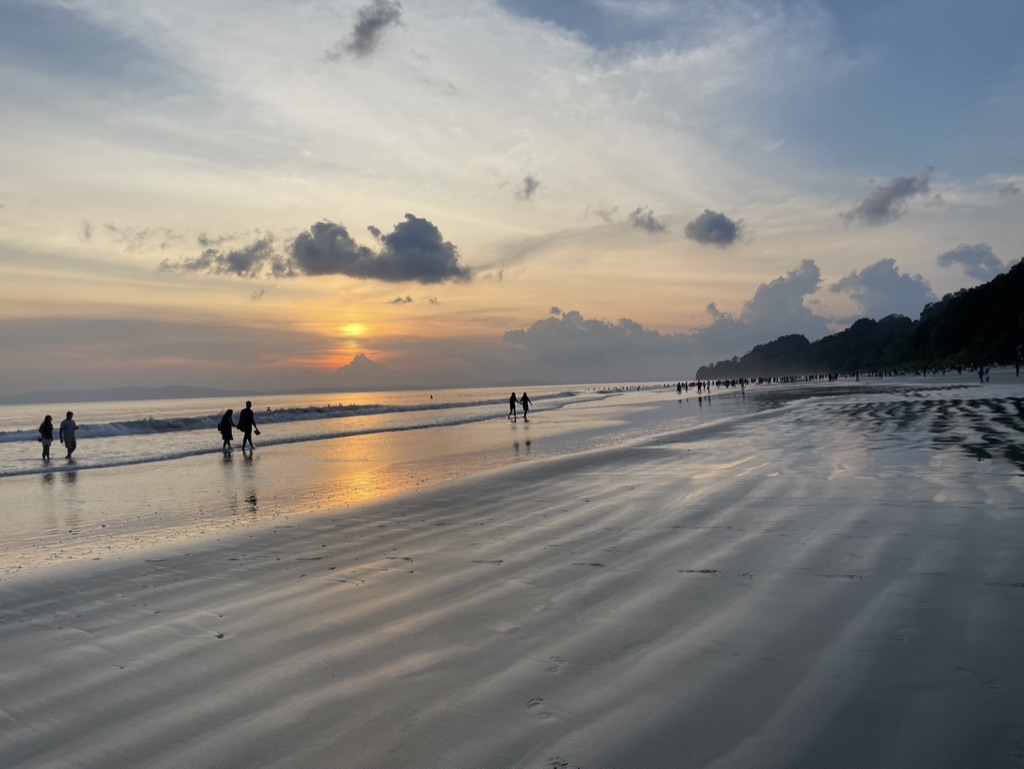
The shallows extend quite far into the sea, so you have to walk for a while to reach a depth suitable for swimming. The sand is home to a multitude of crabs, small and slightly larger ones, that you encounter at every step, or at least their little hiding holes. The sun doesn’t actually sink into the sea in the evening but hides behind South Andaman, yet the view of the setting sun is still captivating. Like everywhere else, the sunset here also has a special charm. However, it also means that the beach needs to be vacated because it is closed in the evening due to certain insects that appear, and it reopens the next morning when the sun peeks over the green, forested hills on the other side of Havelock. We witnessed sunrise and sunset only twice because we are not among those who have ample means. However, we managed to scrape together enough to treat ourselves to what the wealthy indulge in on a much larger scale. If I were to express it in car advertisement style, we had everything the big shots have, just not for very long. Upon our departure, a whole team of staff came to bid us farewell, shaking their heads in disbelief when they saw us leaving in a regular auto-rickshaw. The question of whether we would be uncomfortable was valid, but such discomfort doesn’t bother us in the least. We told the staff that we chose this mode of transportation because Sky loves riding in an auto-rickshaw so much. Whether they believed us or not is another story. At least they will have something to tell their friends and acquaintances – how white tourists from Europe came to them and squeezed three adults and a child with a lot of luggage into an auto-rickshaw and then travelled across half the island to the port from where they sailed back to Port Blair. Since the road there passes over some long slopes, the motor, burdened with excessive weight, struggled uphill suspiciously, but we successfully climbed all the hills and arrived there and back without a hitch. Back to the top!
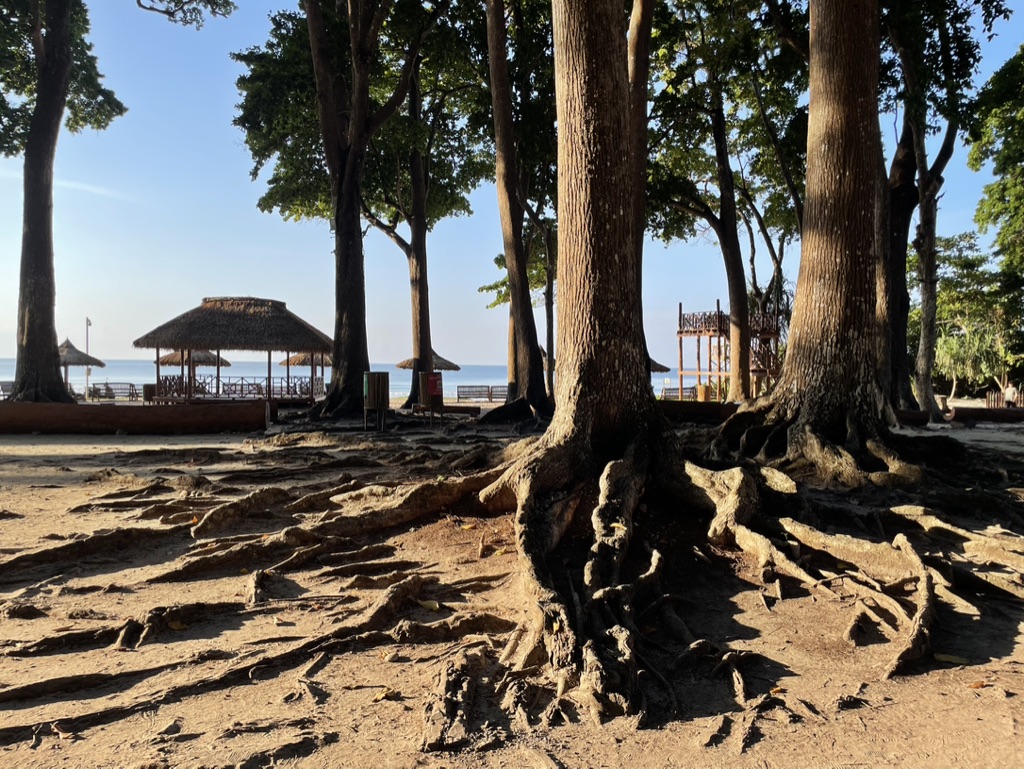
When we landed in Port Blair, it was already night, and there we were greeted by a taxi driver who went to buy a lighter for Julija because he misunderstood “later” as “lighter.” Without that unnecessary stop, the journey to the hotel would have been slightly shorter, although it was already short by Indian standards. Our last hotel was located on the road across the island, where new houses were sprouting up like mushrooms. I was curious about how much the saying “Nomen est omen!” applied here, meaning that the name also has a meaning. The hotel was called Lake View. This meant that it should be possible to see a lake from it. Only, I wasn’t quite sure if the island even had a lake. In Slovenia we have a well known lake that has an island, and here they are supposed to have an island that has a lake. Island Mljet in Croatia also has them, not one, but two. But in reality, they are not true lakes because they are connected to the sea. So it was a valid question whether it was the same here. Looking at the map, it seemed to be the case. However, it should be noted that some of the islands here are so closely positioned to one another that they are separated only by a narrow strip of sea, almost like a slightly wider river running in between. In the South Andaman, north and west of Port Blair, the sea cuts so deep into the island that only a little over two kilometres of land remains, with its total width being almost 20 kilometres. A significant portion of the area also has an elevation of only a few meters above sea level. The archipelago is located at the junction of the Indian and Burmese tectonic plates. The former is subducting beneath the latter and advancing at a rate of about half a centimetre per year. This means that earthquakes occur here quite frequently, and the last catastrophic earthquake and subsequent tsunami on December 26, 2004, along the shores of the Indian Ocean, claimed the lives of 280,000 people. The Andaman Islands were slightly deformed as a result. The western part of the North and Middle Andaman rose more than a meter, while the eastern part of the South Andaman subsided half a meter, and the islands in the far east also experienced some uplift. Following the earthquake, a ten-meter tsunami surged over the coastal areas, flooding low-lying regions that are still submerged or at least marshy in many parts of the South Andaman today. The hotel certainly had a view of the water, but whether it deserved the name “lake” is another question.
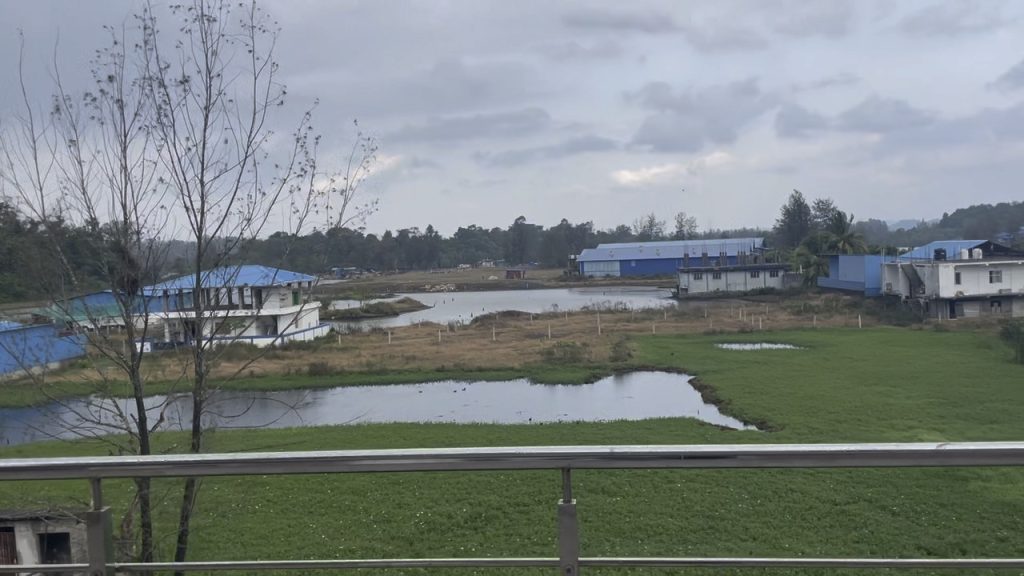
While we’re on the subject of water, let me describe an unpleasant incident that was the prelude to our fall from a five-star stay to a mere two-star one. That’s how many stars our last hotel in Port Blair had. Although there were no signs of those two stars anywhere, what was unmistakably visible was a cockroach that seemed to be residing in the hotel freely and without the knowledge of the hotel management. But let’s return to the water. From the road, which was also a construction site, we practically walked straight into the reception and were warmly welcomed. The expressions on our faces indicated that we were somewhat dehydrated, so one of the staff members was sent to fetch a jug of water. Maša was taking care of the formalities at the front desk, I was holding Sky in my arms, and Julija was somewhere in between, probably making connections with the locals. Sky was the first to receive the water. He steadily emptied a large glass, and because he was clearly very thirsty, I encouraged him to keep drinking. And he did, until the last drop. Then, apparently while trying to shift him from one side, where I had placed him due to his weight, to the other side, I inadvertently transformed him into that childlike angelic figure that spouts water in Baroque fountains. Everything he had drunk and much more gushed out of him in a big stream. Julija immediately wanted to start cleaning up, but the hotel staff quickly stopped her and explained that they would take care of it and that it was nothing to worry about. However, an evil suspicion crept into my mind that the child might have contracted an infection, although I couldn’t understand where or how, as we had been living under five stars for the past few days. But you never know, regardless of the stars. So, appropriately concerned, I stepped into the first floor with the child, where we were given rooms opposite each other. I took him to Maša to change his clothes, but Julija’s voice came from the opposite room, wondering why the room had no window but had a cockroach instead. I didn’t really care about the windows and cockroaches; I was only worried about Sky. However, Maša went to the reception determined not to stay there and started looking for alternative accommodation. Downstairs, they naturally didn’t want to lose customers, which apparently weren’t plentiful in that part of the city, so they offered us a room on the second floor for all four of us with a large double bed and an extra bed. Accepting the offer for the same price seemed more practical than looking for a new place to stay just before bedtime, not knowing what it would be like. Unless they had a place for us in the hotel where we stayed when we arrived. We didn’t check that option; instead, we decided to take a risk and stay. Surprisingly, Sky quickly recovered and showed no signs of illness any more. However, the catastrophic start of our stay had indelibly marked the remaining time spent at that hotel, even though the room we received was not bad at all. It was surprisingly good for a two-star hotel. The exception was the extra bed assigned to me. It was a simple couch that could be turned into a bed by pulling out the part underneath the seat. If you pulled it too far, it would split into two pieces. Regardless of how much you pulled out that movable part, it would creak loudly with the slightest touch. So, while sleeping, my legs were sticking up in the air from the part of the couch I was lying on, because any movement during the night would likely wake up all my room-mates. My conclusion at the time was that this extendable couch was something I could have made myself, and it was possible to spend the night on such a half-collapsed couch with not that much effort.
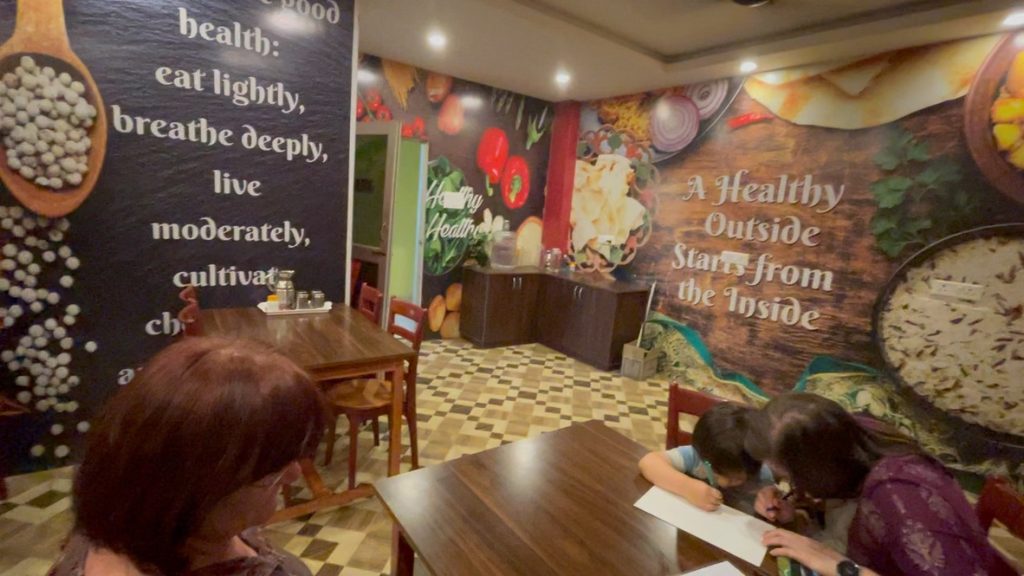
Not only was it possible to stay quite comfortably in the hotel, but the food was also not bad. The walls of the dining room were covered from top to bottom with advertisements featuring food photographs and slogans highlighting the importance of healthy eating. But we didn’t know where the food for us came from, and we didn’t want to know either because behind the doors through which it was brought, it all looked quite unappealing. I couldn’t help but be reminded of what was once called a “pig kitchen” on our farms. Not because the room was so “pig-like” dirty, but because they cooked for pigs there. Pigs can be clean animals, and my grandmother always cooked for them in a way that we could eat it without fear. But the place where it was cooked was stripped of any luxury – bare walls and concrete floors, the most basic setup, in short, two levels lower than the standard for us, humans. I don’t know what the standard of our hotel kitchen was, but I suspect it wasn’t very high. However, as I mentioned, the food was perfectly decent, and I continued to eat in the hotel restaurant even after my room-mates got tired of their food.
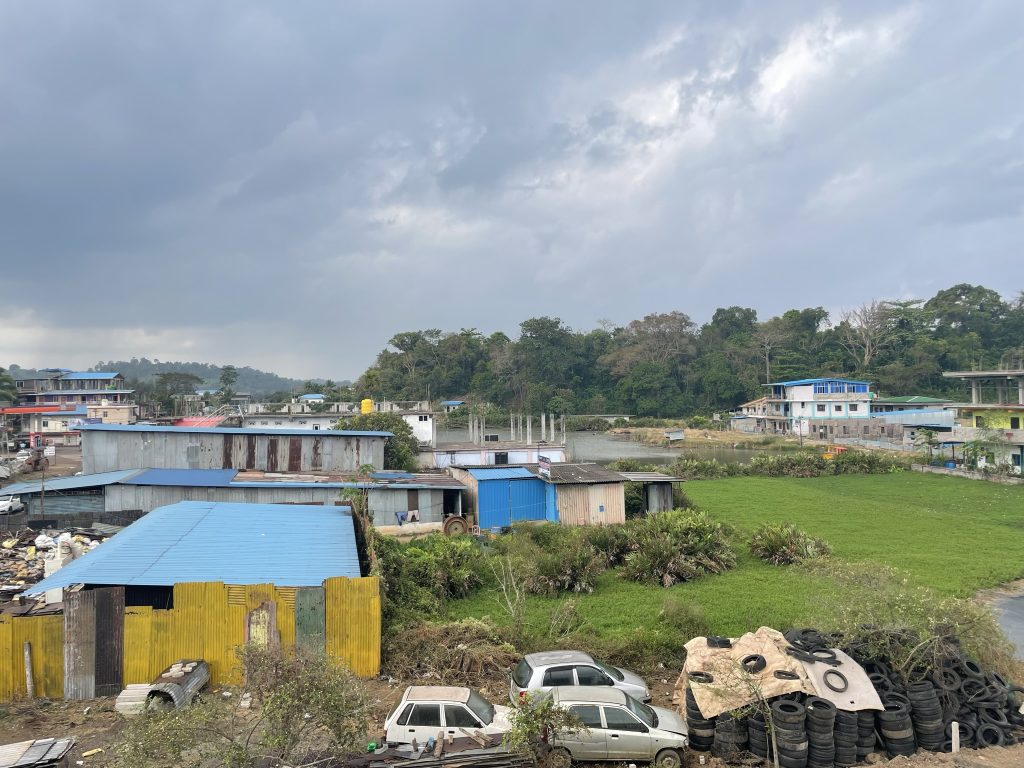
However, it is worth mentioning that our new room not only had windows but also a huge glass window, in front of which there was an even larger balcony with a view of what was supposed to be the lake. Of course, besides the water, there were also many other less attractive things to see, such as growing houses. After completing the ground floor, they “slap pillars to extend the first floor, and these unattractively protrude, spoiling the appearance of the already built part of the house until they scrape together enough money to add walls and a ceiling, and preferably another set of pillars for an additional floor on top. It’s not even worth mentioning the waste and dusty old cars, boats, and who knows what else. However, seeing all the discarded objects scattered around reminded me of my home and the fact that it deserves to have all the junk that has accumulated around it over time taken to the landfill. But alas, something else always takes priority, whether it’s stand-up paddling, cycling, or preparing for a stage performance.
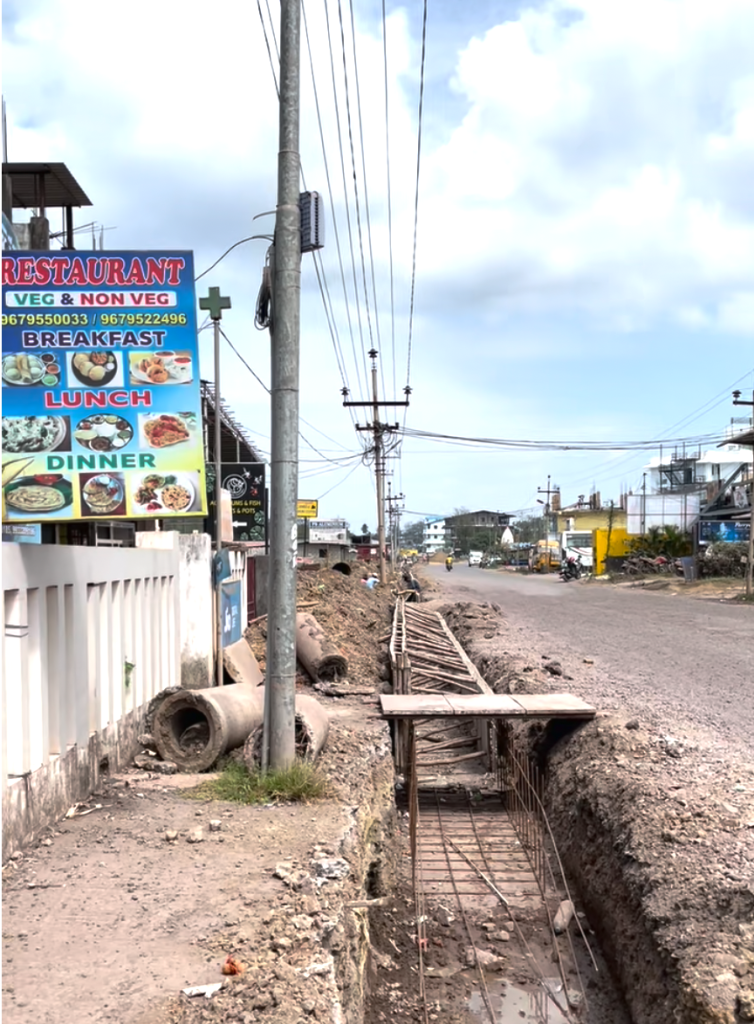
The main flaw of the Lake View hotel was that it was situated in the middle of nowhere. Not literally, as there were plenty of buildings along the road on both sides. But there was nothing truly interesting nearby. Maša chose the hotel as our base for visiting Jolly Buoy Island. From here, the distance to the marine national park named after Mahatma Gandhi, where boats depart for the island, was much shorter than from the city centre where we stayed upon arrival. I only discovered our plan after it turned out that, for unknown reasons, access to the island was impossible, and swimming on the beach from which the boat departed was prohibited. So we spent the whole morning strolling along the beautiful beach and could only wet our feet. At first, I thought swimming was forbidden because it was a marine park and a protected area. But then a local explained to Julija that it was due to the presence of saltwater crocodiles, which could be dangerous for swimmers. There was no transportation to the island because the boat they used for transport had sunk or was damaged. Apparently, nobody had maintained it during the pandemic, and it seemed that either the devil or Poseidon himself took it, although the Indians probably have their own sea god up their sleeve. This god likely resides near Jolly Buoy Island, as it is described as an ideal place for diving and admiring coral reefs and marine life, not to mention the stunning beaches.
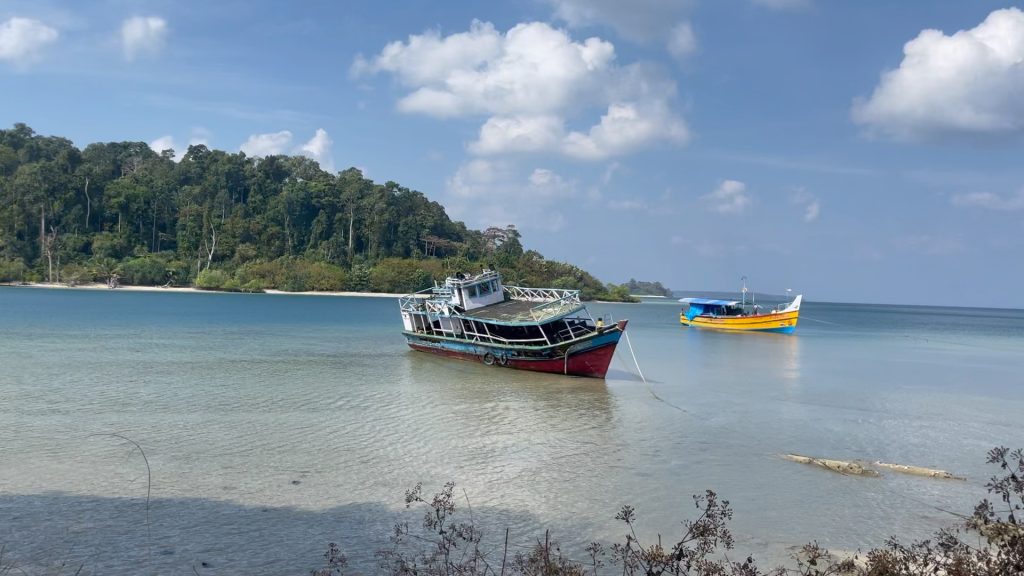
Beaches and swimming would have been suitable for us, but unfortunately, it didn’t work out. In the afternoon, the taxi driver took us to another beach where swimming was also not allowed, but you could take pictures with crowds of other tourists and then go watch the sunset. I mean, it was nice, but I think the taxi service benefited the most from it. Of course, the saying applies here too: “Tourism is people!” But in our case, it’s reversed – we, the tourists, supported the local economy and allowed ourselves to be taken to places that the taxi drivers know everyone wants to see, and of course, they are not very close so they can drive you further. In any case, we filled the memory cells of our phones with photos and videos of these exotic places, where the pleasantly warm water invites you into the roaring waves crashing onto sandy dunes, but we had to politely decline this entirely decent invitation and be satisfied with filling our electronic memory. The next day, the plane carried us over all these beaches and flooded plains back to the Indian subcontinent, and the Andaman Islands became nothing more than a memory of the swiftly passing time we spent there, and the places and experiences that left a strong impression on us.
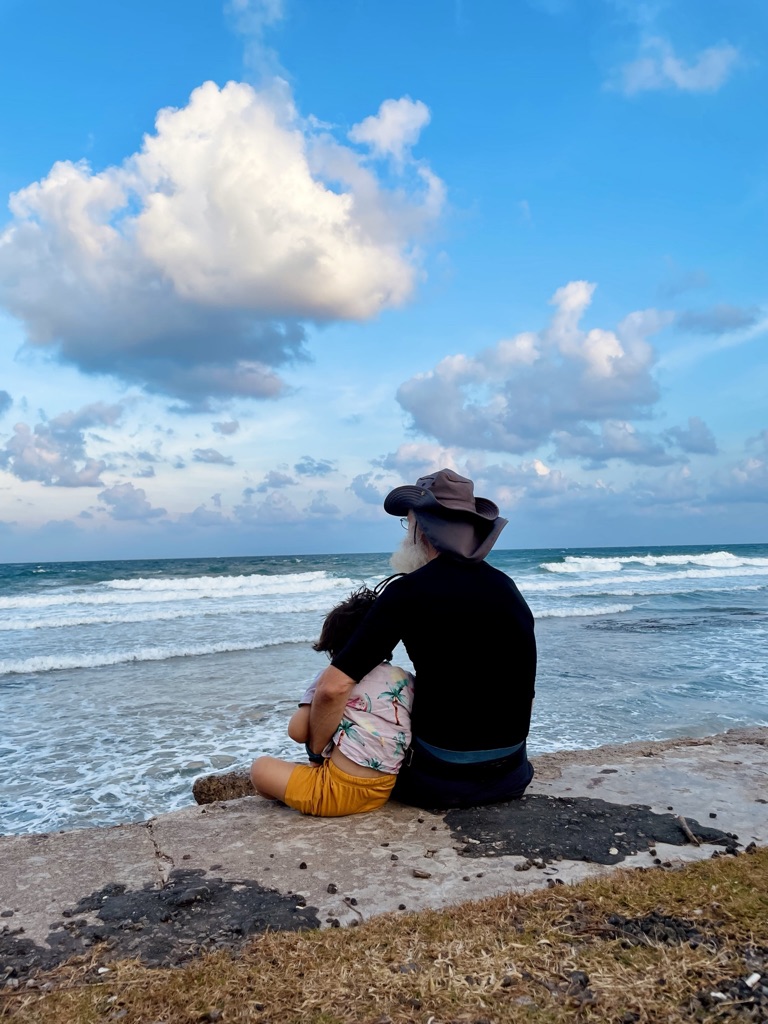
To conclude …
Just like the ten days of our Andaman vacation, the month and a half of our visit to southern India suddenly came to an end. Too soon? Certainly not too slow. But time cannot move slowly for a person of my age, and I no longer know what boredom is. It doesn’t matter where I am or what I’m doing. Well, not entirely. Because living in an Indian metropolis is quite different from anywhere in Slovenia and, in many ways, even different from anywhere in Europe. Therefore, simply living there is a special experience, even if you’re not playing the role of a tourist who must make the most of every moment spent travelling, trying to see and experience as much as possible of what tourist agencies and self-proclaimed travel gurus offer on the World Wide Web.
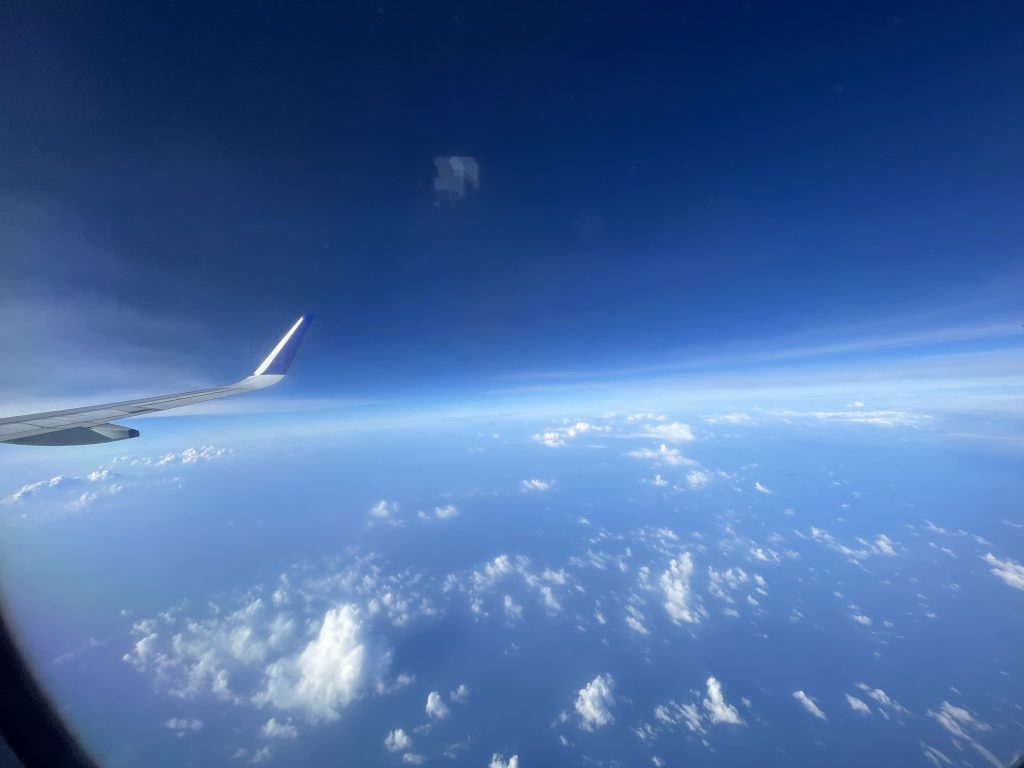
The steps on the staircase that woke me up early in the morning, when our grandchild jumped into our bed with a wide smile on his face, meant more to me than the sight of fortress walls and the splendour of palaces and shrines. The memories of how we ran from mosquitoes on the playground or how we observed doves, squirrels, and other birds from the terrace are worth more to me than capturing a tiger on safari with my phone. But the most beautiful memories are undoubtedly those from the paradise-like Andaman Islands. Especially when Sky and I ventured out to explore the seashore before sunrise. All those cute hermit crabs carrying their shells here and there, shells tucked into wet, dark rocks somehow, not to mention the stunning colours and shapes of the coral that appeared during low tide amidst the remnants of former mangrove trees. And the morning walk on the sandy beach, with Julija joining us. The sun barely peeked over the tree-covered hills, and our shadows stretched far across the sand, all the way to the mighty tropical trees, where drawings created by countless crabs during the night were exhibited in the sand among the roots, showcasing each crab’s unique path.
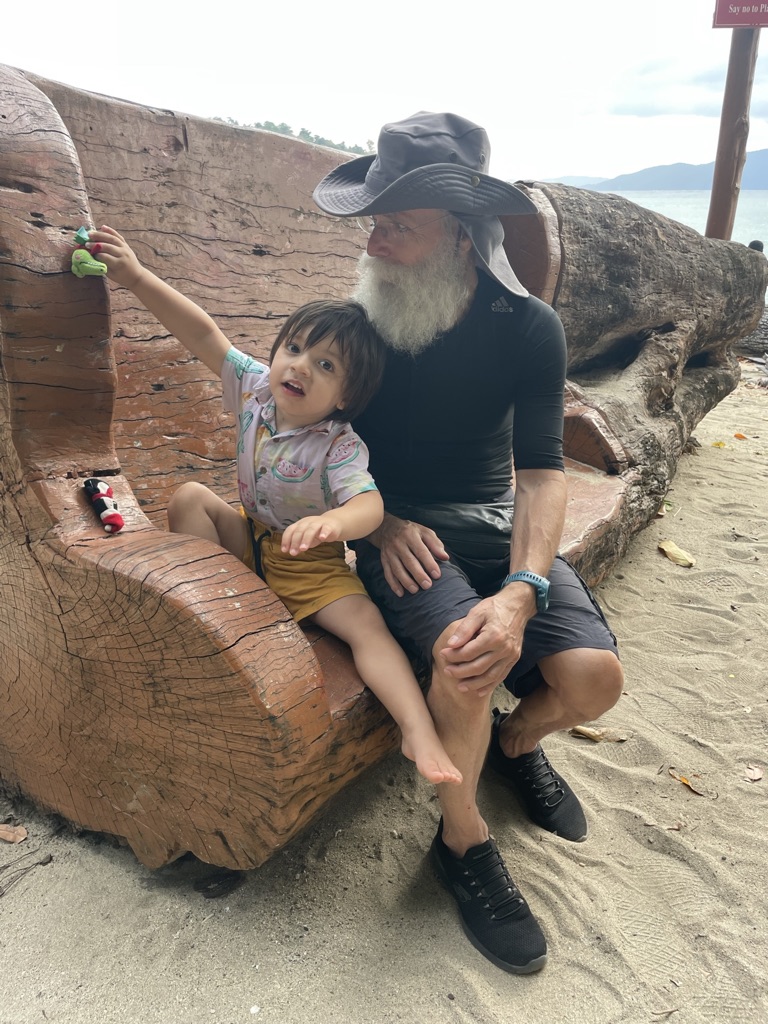
In addition to me, Maša also captured electronic memories on her phone, so there are plenty of opportunities to refresh the memories of numerous beautiful and even more beautiful moments, you just have to take the time for it. After all, this writing is also a kind of return, a journey back in time, so to speak, enabled by our memory, reinforced by material evidence on our smart devices, not to mention the World Wide Web, where you can educate yourself about where you’ve been and what you actually saw, even though at the time you were looking, you didn’t quite know exactly what you were seeing. Perhaps next time I’ll be better prepared for the journey. Who knows? Time is such an elusive thing, there’s never enough of it for what means the most to a person. And it’s not to be expected that this will change much in the future. Nevertheless, the month and a half in India was a well-utilized time and a pleasant experience, which has enriched me with many experiences. I believe that not only me, but also all those who made my moments spent with them more beautiful and enriching.
